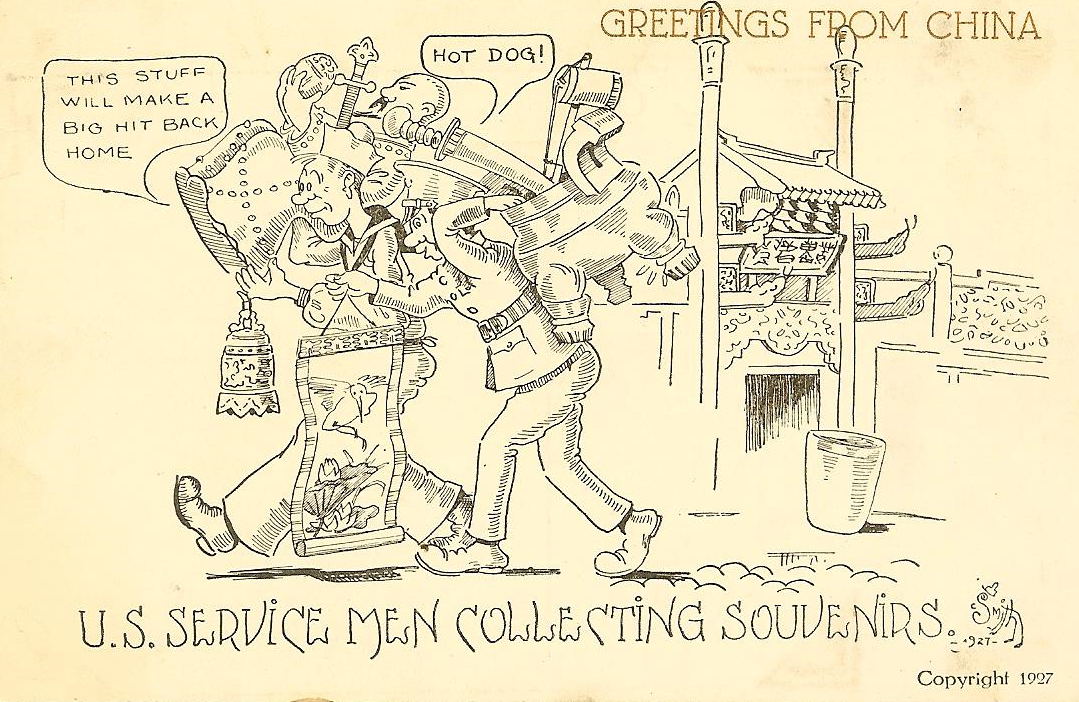This page covers non-uniform items originally associated with the China Marines. Such things found here include scrapbooks, decorated photo albums, trench art, ephemera and other souvenirs.
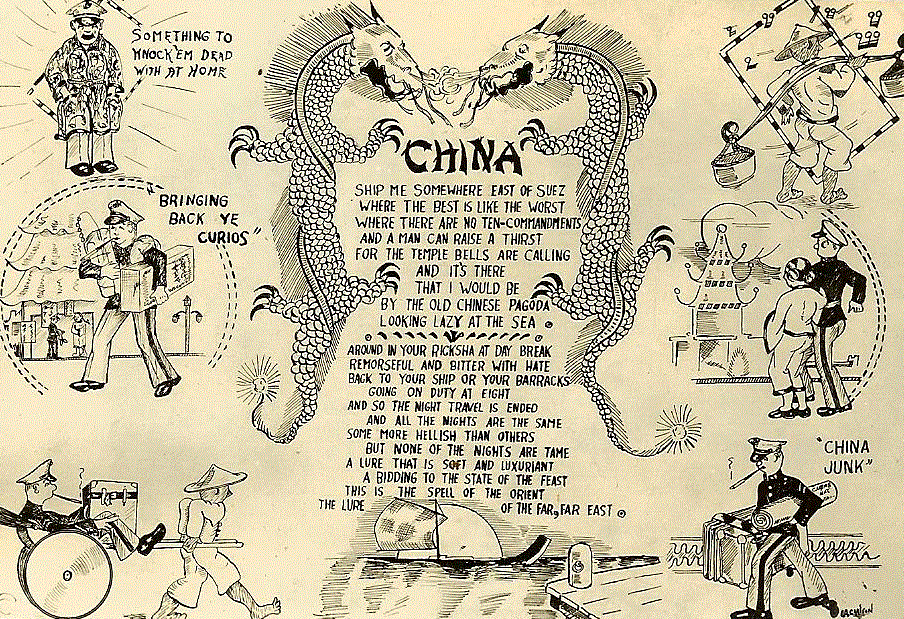
Scrapbooks
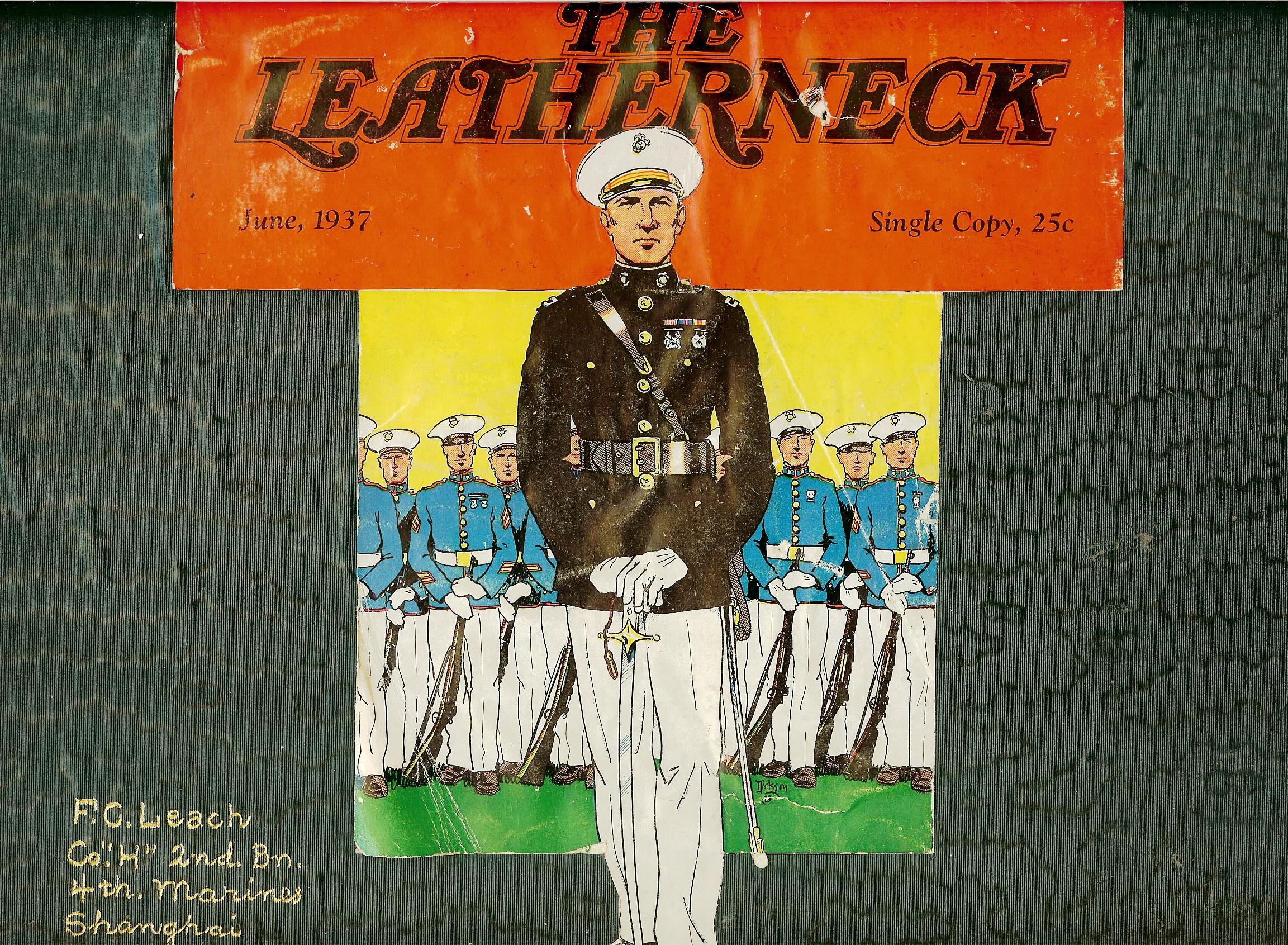
It may suprise some that during the first half of the Twentieth Century, Marines were active scrapbookers. Sometimes using a discarded Navy Logbook, an old binder or photo album, Marines of this era eagerly filled their scrapbooks with an endless variety of items ranging from pin-ups, beer bottle lables, and love letters to copies of orders, dance cards, newspaper clippings or even poems. I find such books an untapped source of historical information that highlights what these men considered important or memorable during their time in China. Here we see the bars, clubs and cabarets they frequented, menus from their resturants, where they shopped and even business cards from their favorite "working women." The earliest scrapbook I have in my collection dates from 1916 and the latest I have was still being added to by the Marine even after his captivity by the Japanese in December of 1941!
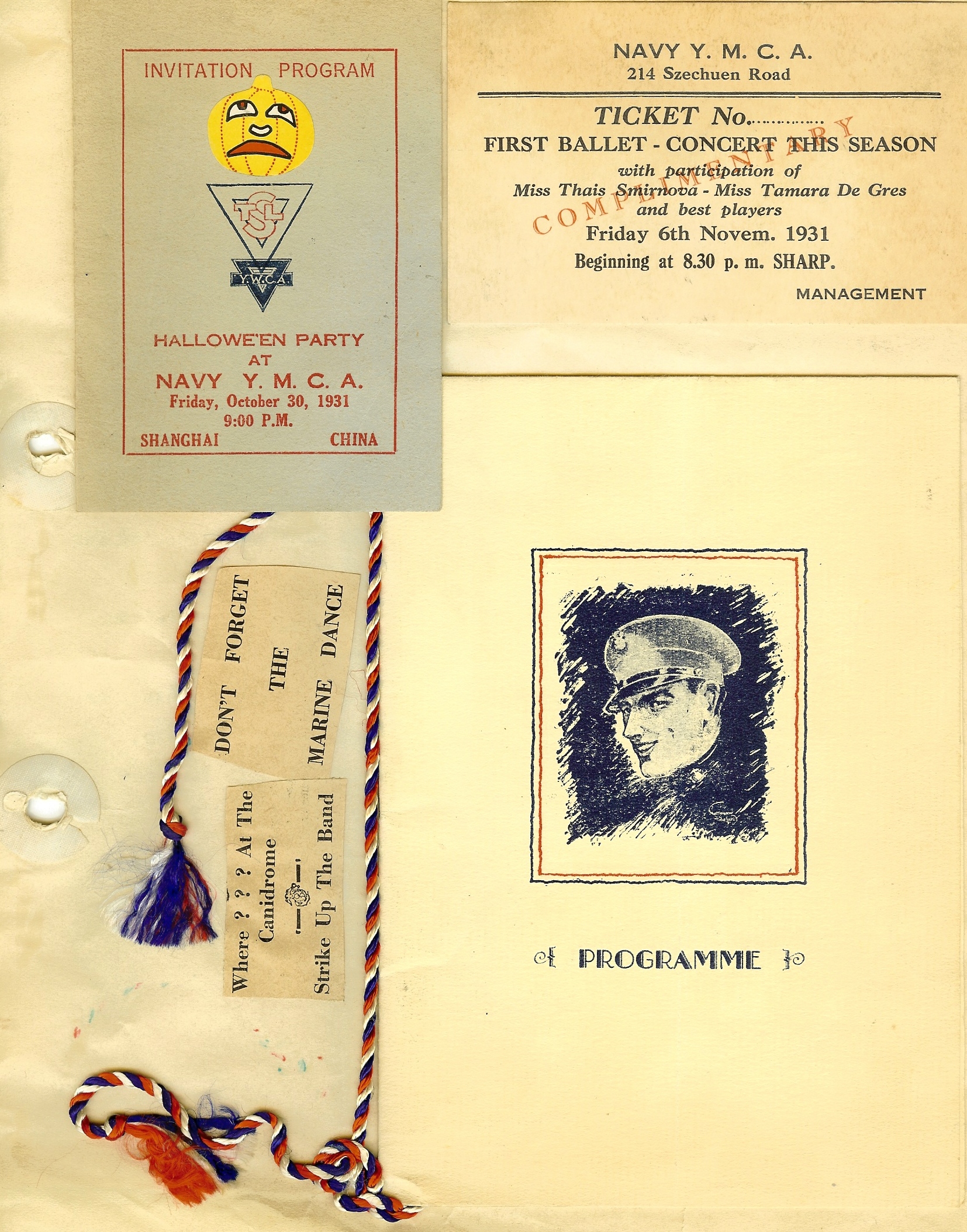

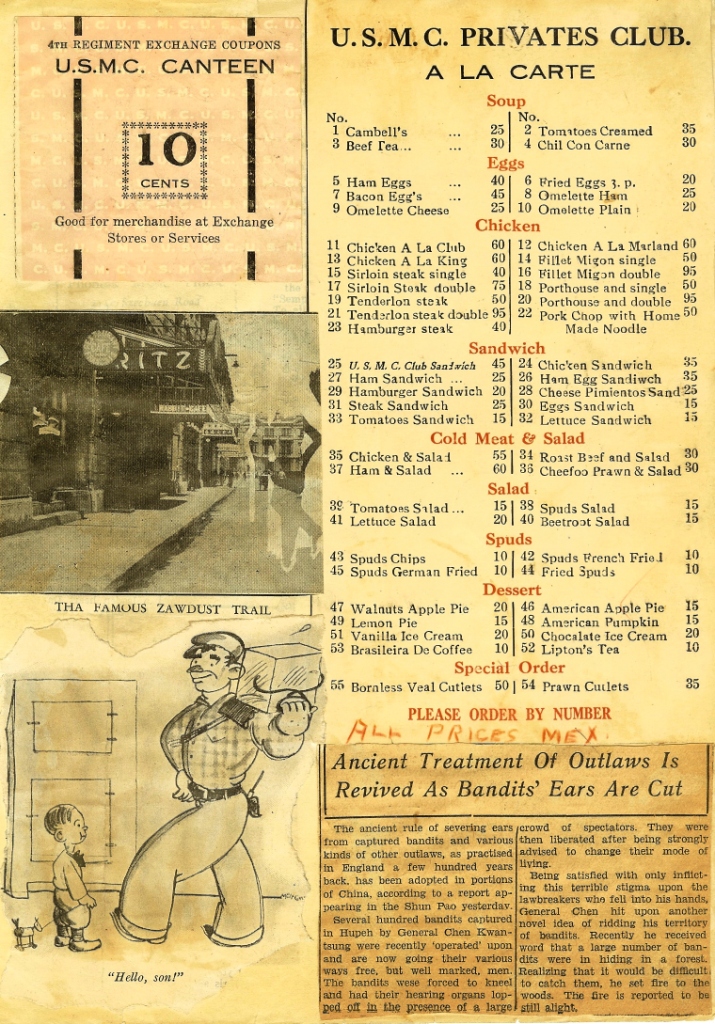
Pages from various China Marine Scrapbooks
Photo albums
Photo Albums. Marines were avid photo collectors. As photography became cheaper after 1900, these men began to take or purchase a large variety of images that they mounted in American or Japanese manufactured albums. In the mid 1930’s things changed, when some enterprising merchants in Shanghai and Peiping began producing albums specifically for sale to American Naval personnel. Of these custom albums there were two main types: leather bound or embroidered. Normally, a Marine would go to a local gift shop or their post exchange and choose from of number of design covers that could be further customized. Then the Marine would have the option of filling the album with in-stock images (mainly of the local sights or formal military events) that the merchant would then mount in the album and caption in white ink. Any personal pictures in Marines possession might also be added to the album by the shop or left to buyer to mount as he saw fit.
Early Photo Albums. The album below was put together by Lt. Sam Budd and dates from 1910-13. Of note, the album appears to have an Asia motif, but was customized with Chinese script that highlights Budd’s time in China. The words appear to have been done in ink, and so were likely added at a later date. Since I don’t believe Budd could speak Chinese it is interesting to speculate if one of the Marine Language Officers (who do appear in the album) added the writing to the cover for him. Also each page of the album, as many albums of this period, consist of hard cardstock vice thinner black pages as seen during and after WWI.
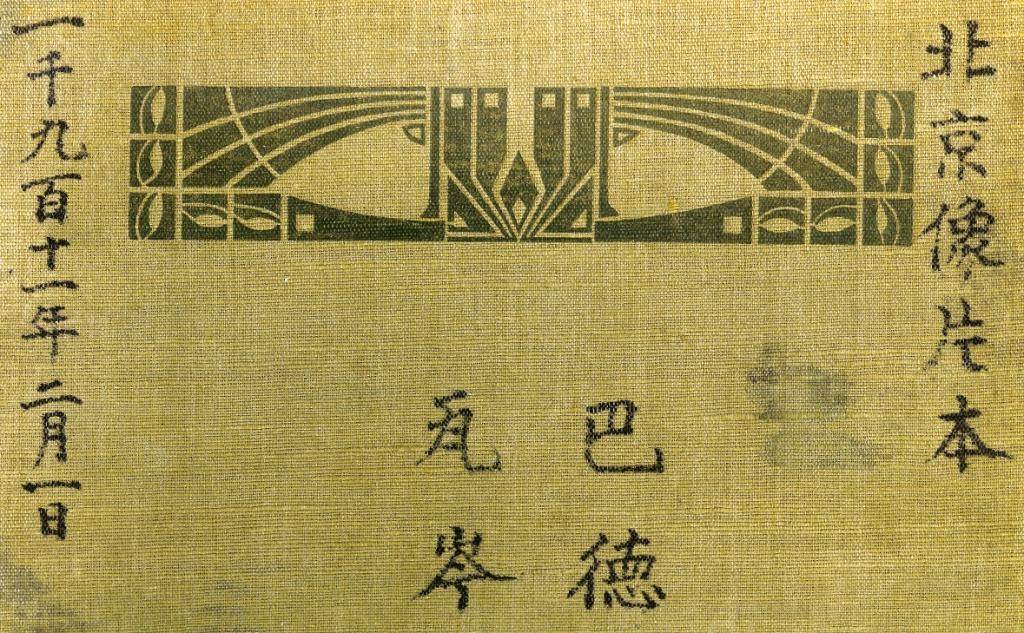
The cover of Lt Sam Budd's Album
Leather Dragon Album: From examples I’ve examined, Shanghai merchants excelled at producing leather bound large format albums that normally had a nautical design cover supplemented with dragons or a scenes from a particular coastal location. Further upgrades could include embellishing the cover with the name of the owner in gold. The leather cover was stitched around cardboard or a wooden frame. Although the leather of these albums must not have been of the highest quality, I’ve found they have aged well and a number of them have survived the years intact. In the case of Colonel Charles Price, Commander of the 4th Marines his albums were custom designed of very fine leather and featured a large raised EGA on the cover.
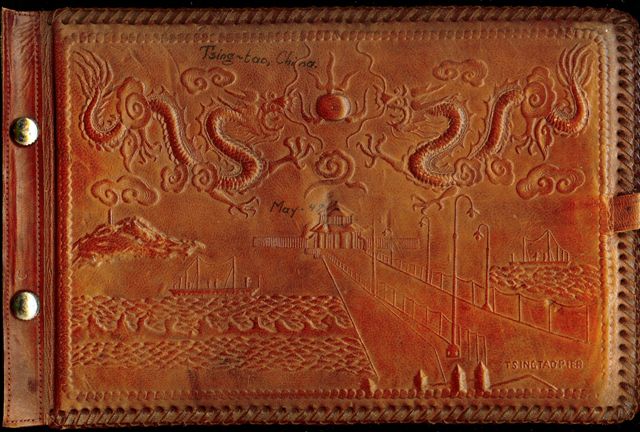
Silk Embroidered Album: By far the silk embroidered album presents a most dramatic and colorful remembrance of China. Although produced by a number of studios in Peiping and Shanghai, in my opinion the quality of the Peiping product in unsurpassed for the detail, quality of needlework and design. Many of these covers featured a large Eagle Globe and Anchor or “Devil Dog” surrounded by dragons and other Chinese symbols. I also have seen designs copied directly from the covers of Leatherneck magazine or other Marine publications. Following World War II embroidered albums were again made for sailors and Marines, but in my opinion the quality was not as good as the pre-war article.
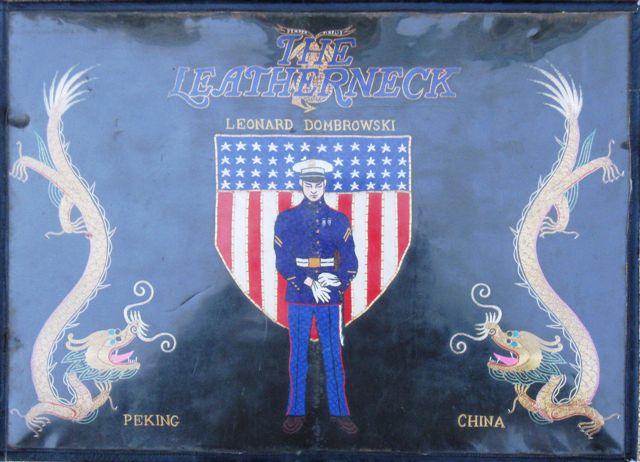
A fine Peiping produced silk thread cover c.1938-39. The reflective glow comes from a period-produced protective film cover.
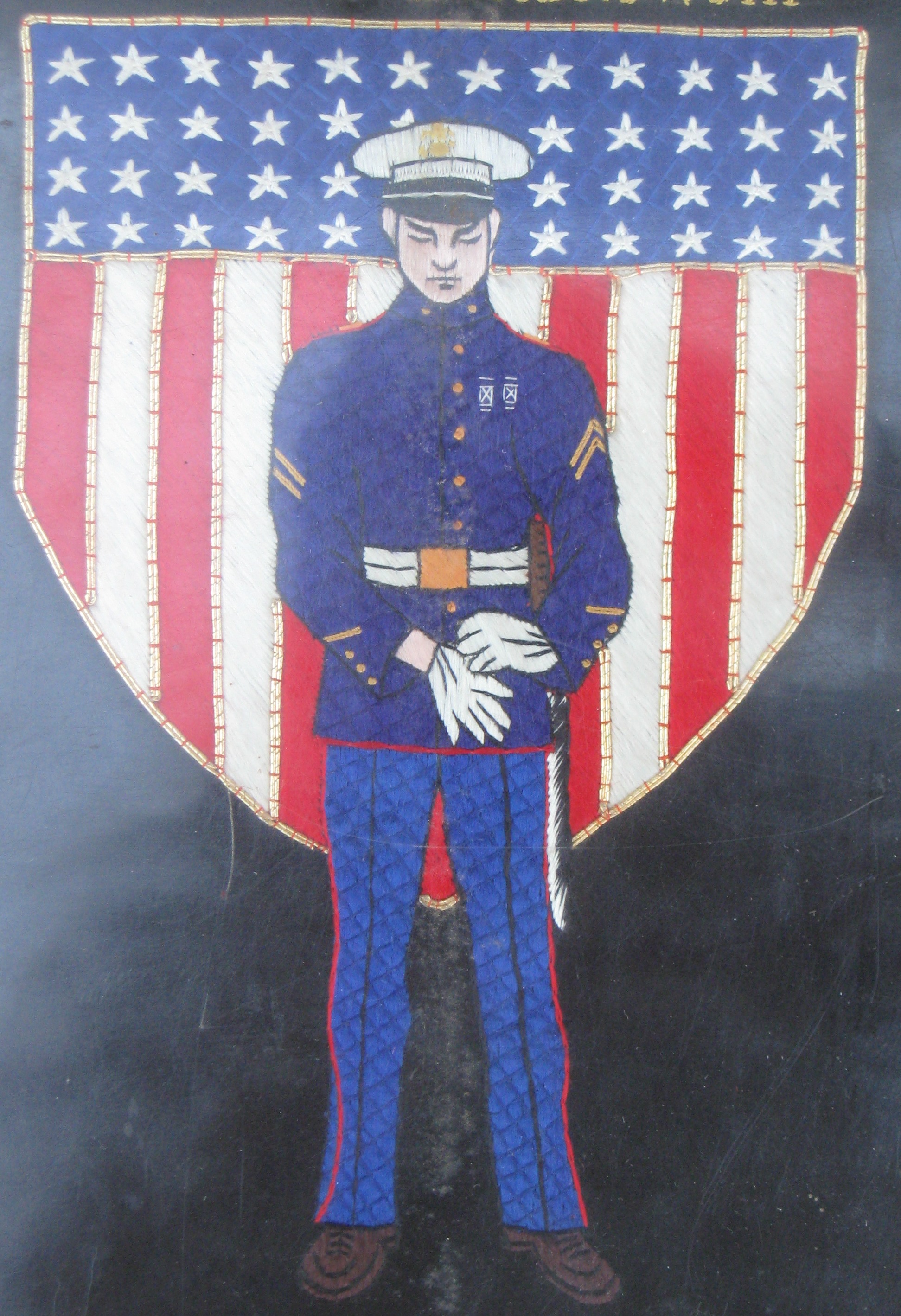
A detail of the album. Note this image was copied directly from the July 1937 Leatherneck Magazine cover
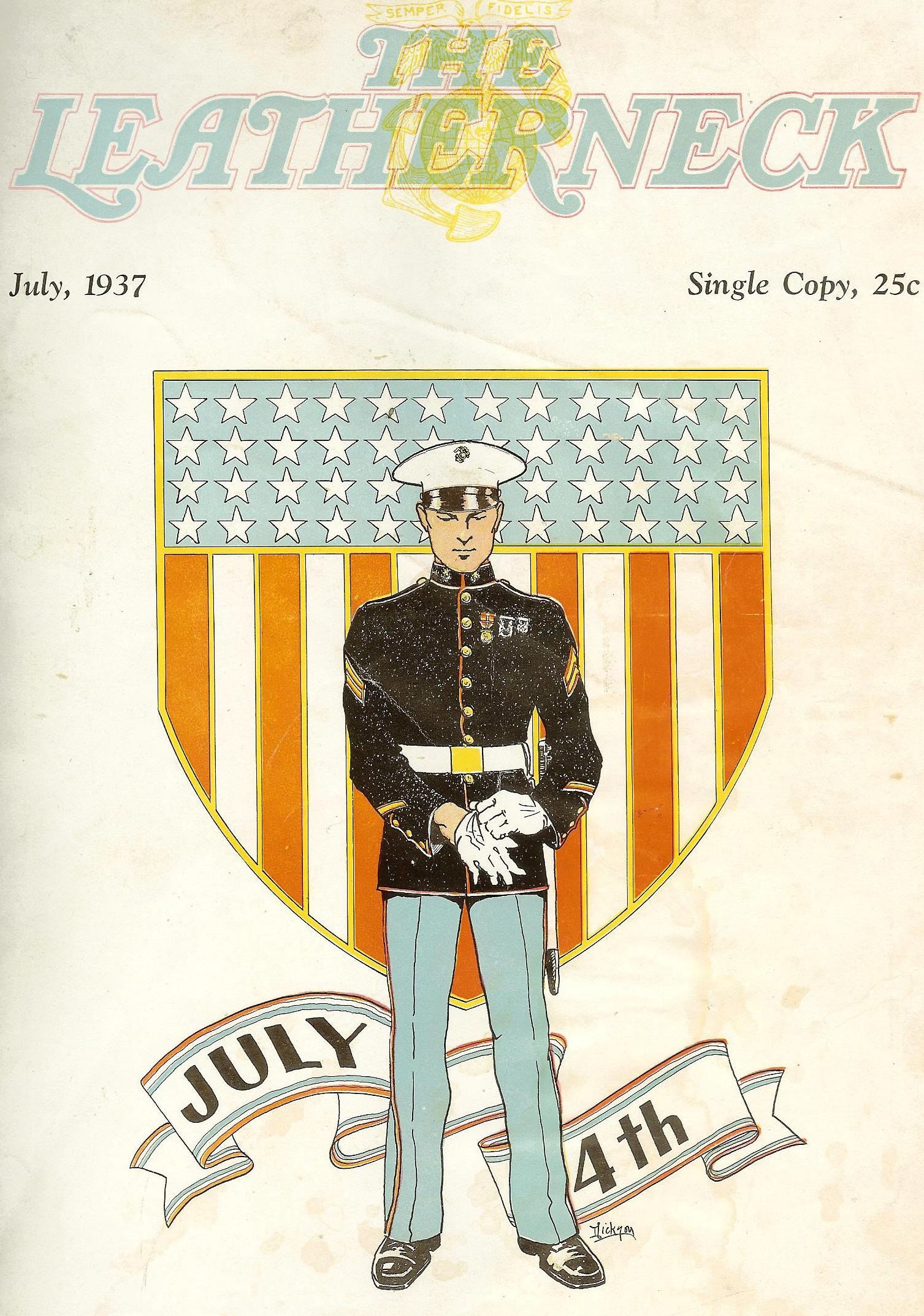
Leatherneck Magazine, July 1937
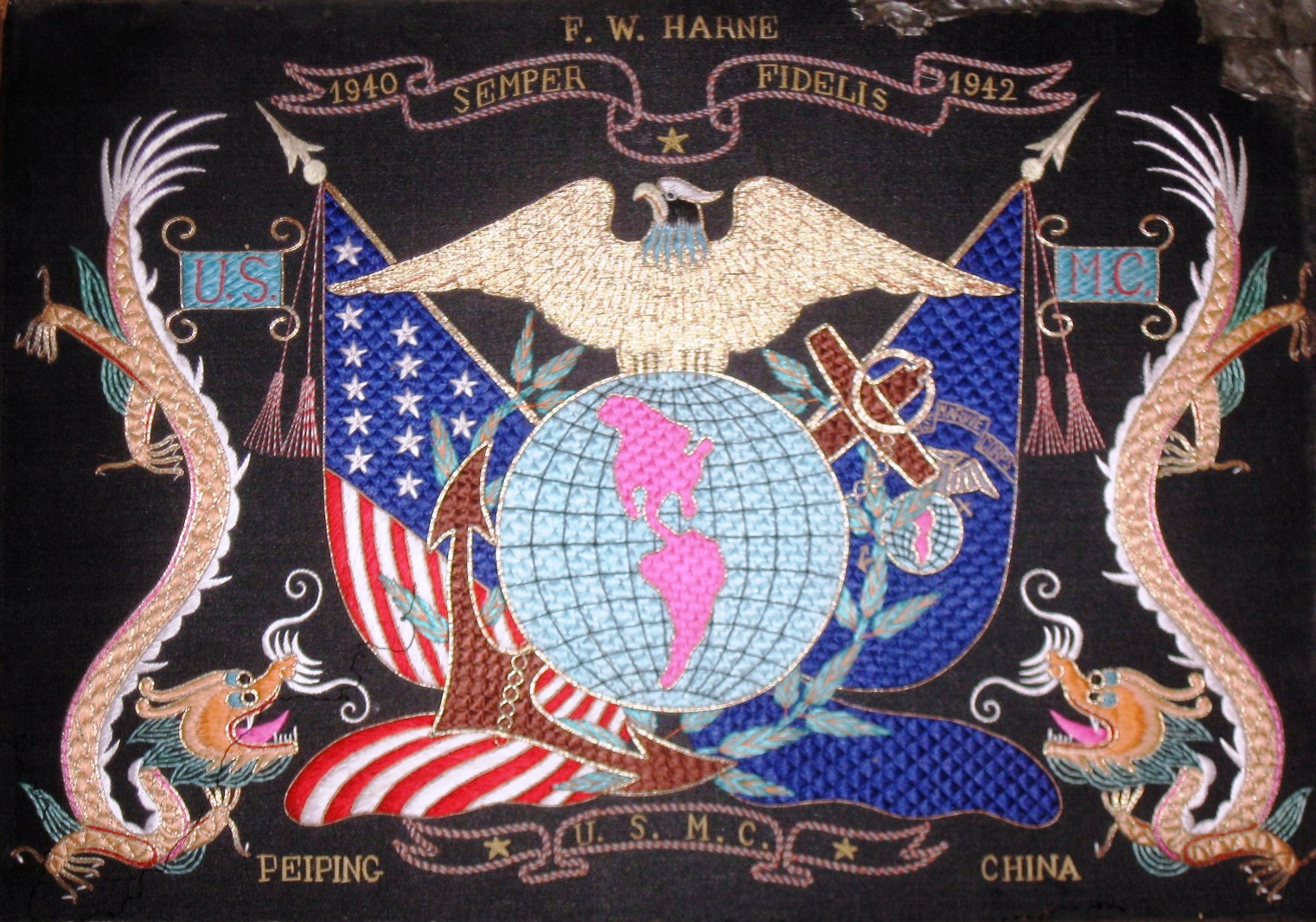
Another high quality Peiping produced album, c.1940. Because it is missing its protective film cover the viewer can see the rich colors. The blue of the Marine flag almost looks three dimensional. Also of interest is the 1942 date. Since this Marine does not show up on the North China Marine POW list, we can assume he left prior to December 8th 1941.
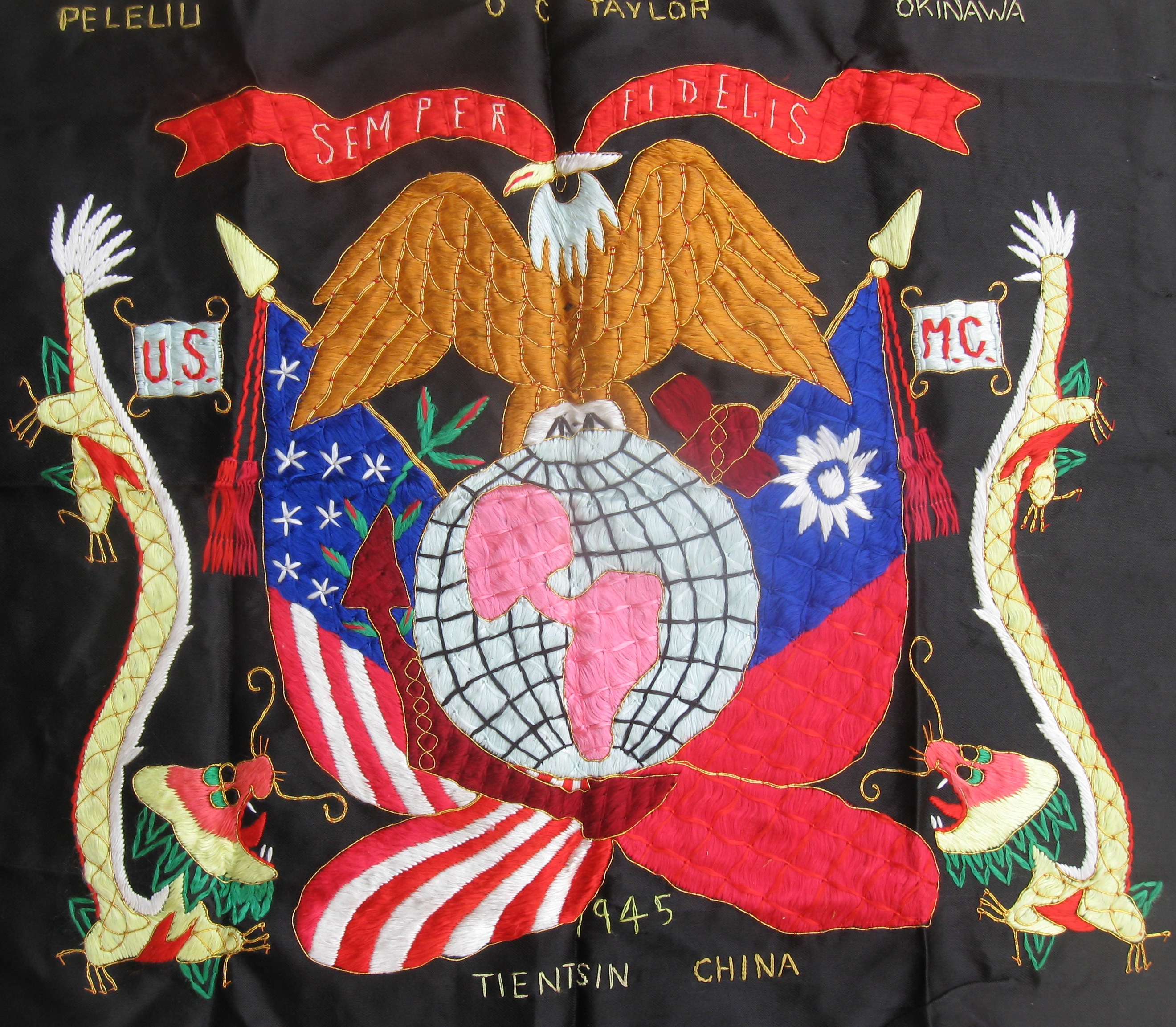
A post-WWII cover. Clearly the deatil is not as fine as the pre-war examples above.
Cruise Books
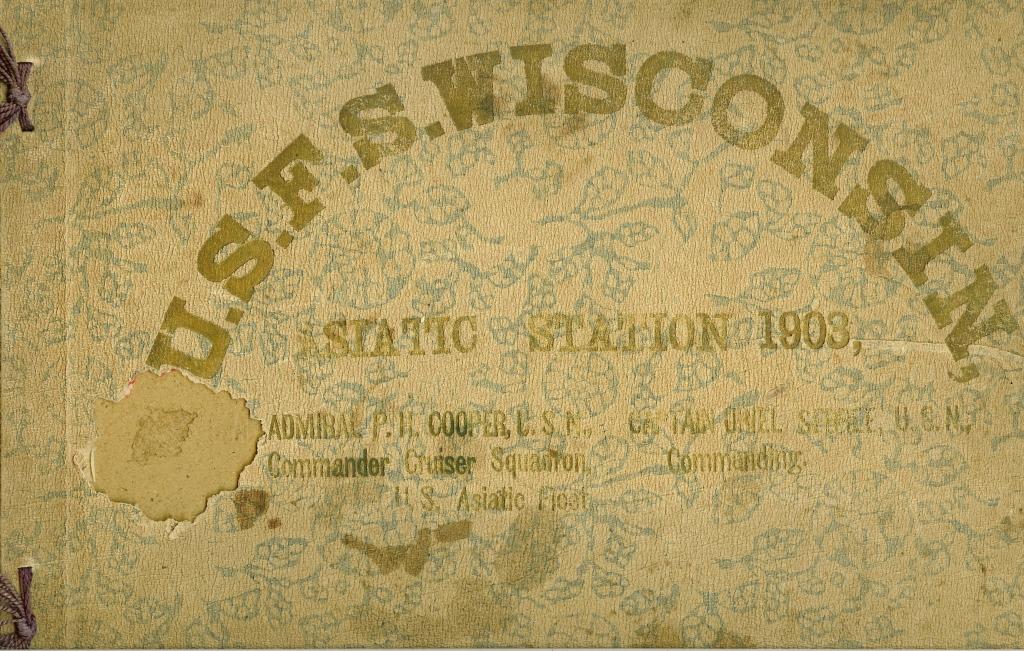
Cruise Books: I am not sure when cruise books first appeared, but the earliest one I have in my collection is from the Asiatic Fleet Flagship USS Wisconsin, circa summer of 1903. Such books initially highlighted group photos of the officers, the men of each watch- as divided by division, the Marine Guard, the band, ship’s sports teams; and a shot showing the entire crew. A sailor noted such full crew pictures were always enjoyed, as sailors and Marines jockeyed for a prominent position behind the Captain. Over time these books recorded events during a cruise or short stories about crew members.
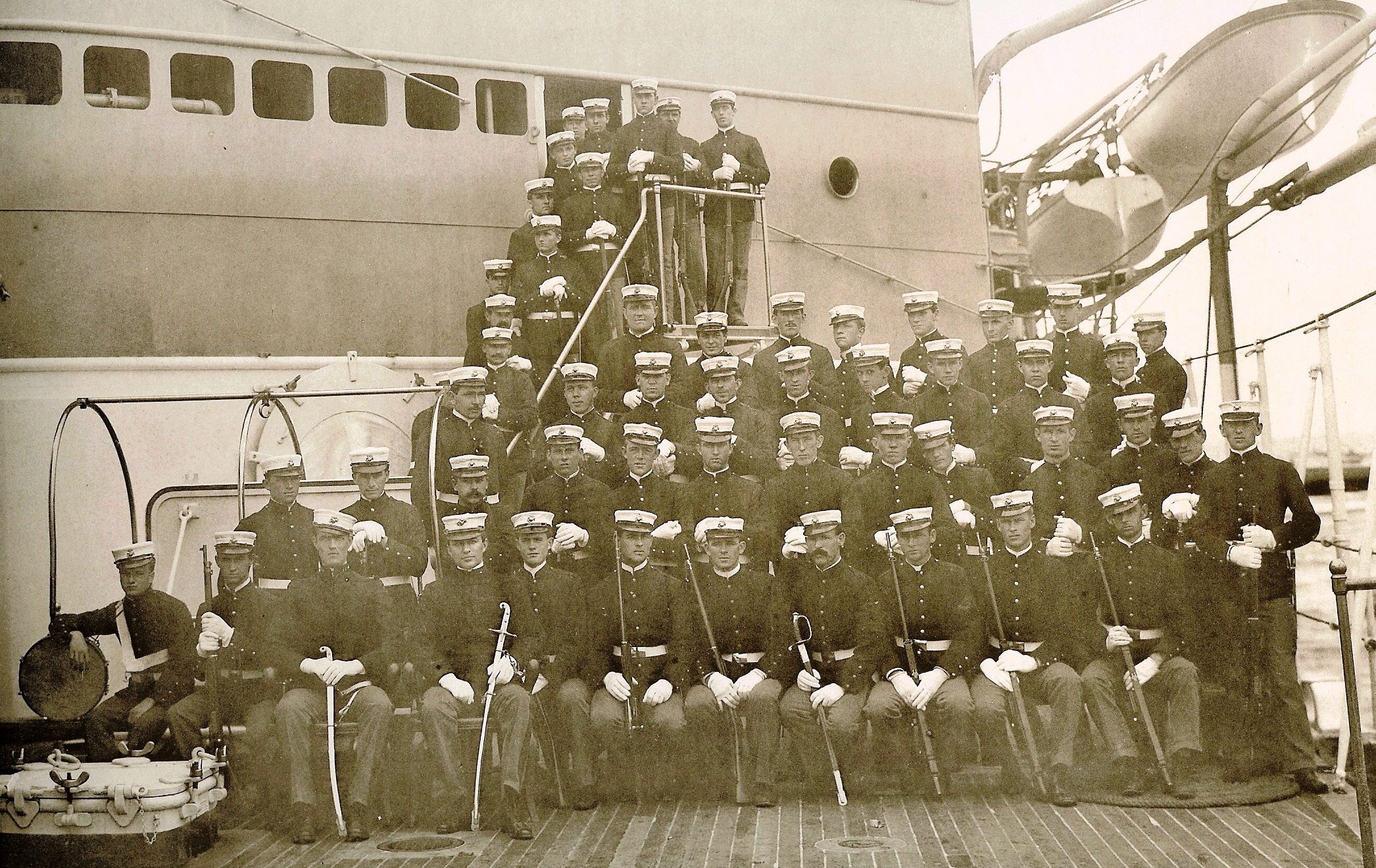
The Marine Detachment, USS Wisconsin
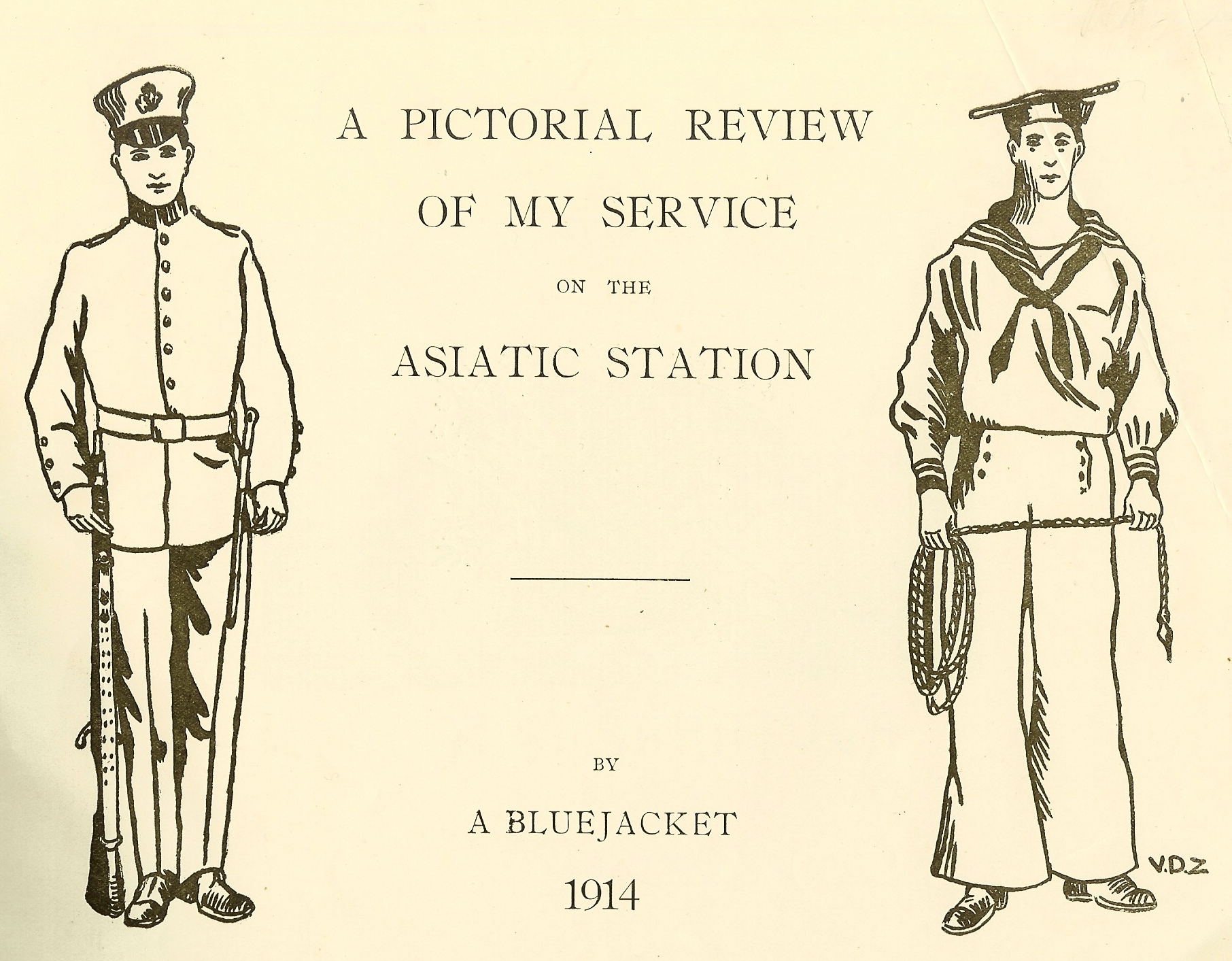
This Cruise Book example dates from 1914 and was a multi-ship collaborative effort that recorded Fleet activities during the Second Chinese Revolution of 1913.
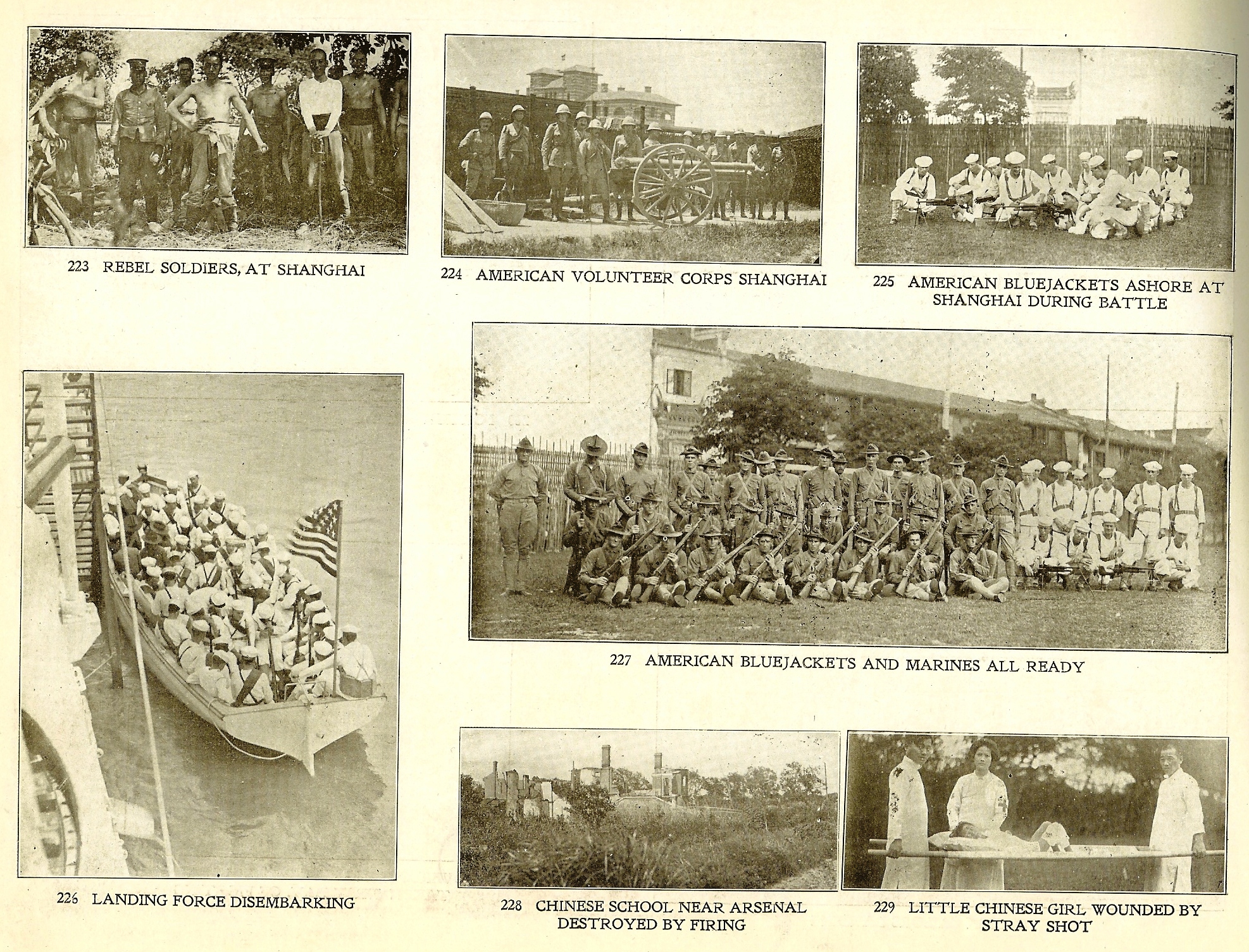
A page from the Asiatic Station Album
Souvenirs
Silk Remembrance (Trapunto) Scrolls
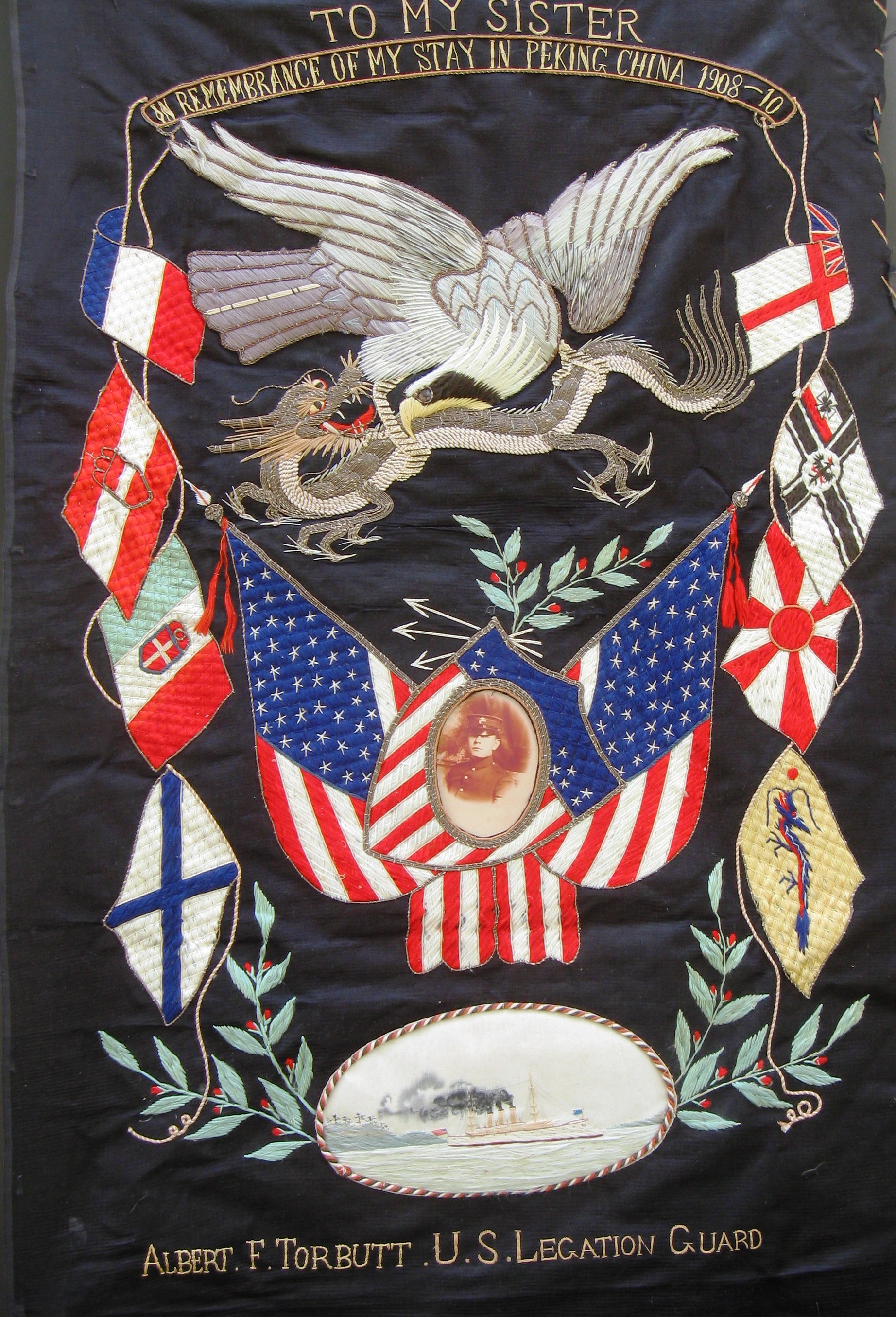
One of the more popular souvenirs for many on the Asiatic Station was what I call a silk embroidered remembrance scroll. These scrolls came in a myriad of sizes, colors, designs, and materials and could be customized for a sailor, soldier or Marine to offer a unique keepsake of his Asiatic Cruise. Since a number of Great Powers operated in China during this era, scrolls usually were composed of patriotic symbols unique to each power. Not surprisingly, American themed scrolls combined the Eagle with the Stars and Stripes. Some of the more elaborate versions allowed for a photo of the owner and/or his ship to be inserted into the finished product. I believe silk scrolls were produced at several locations in China, Japan, and the Philippines with Japan being the largest producer. Furthermore, I am sure each location had its own style and favored patterns. Since the majority of American servicemen purchasing these were sailors, it should not be a surprise that most seen today have nautical themes that favored sailors. However, the examples shown below were customized specifically for Marines, and therefore much rarer. Although, highly popular before WWI, I believe the scroll fell out of favor by the mid-1930s.
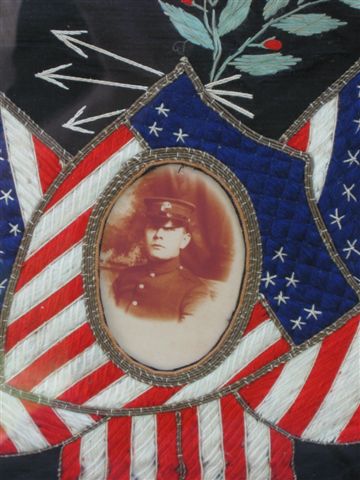
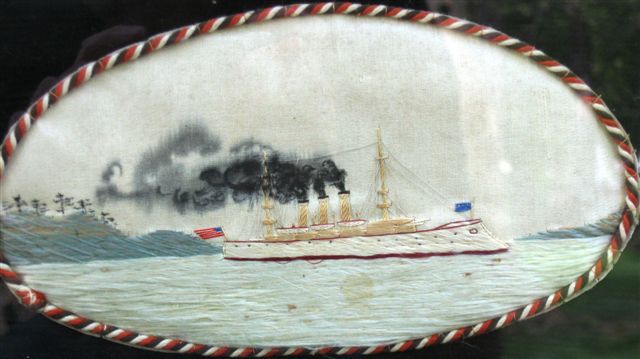
This detail shows a American Armored Cruiser with painted smoke added.
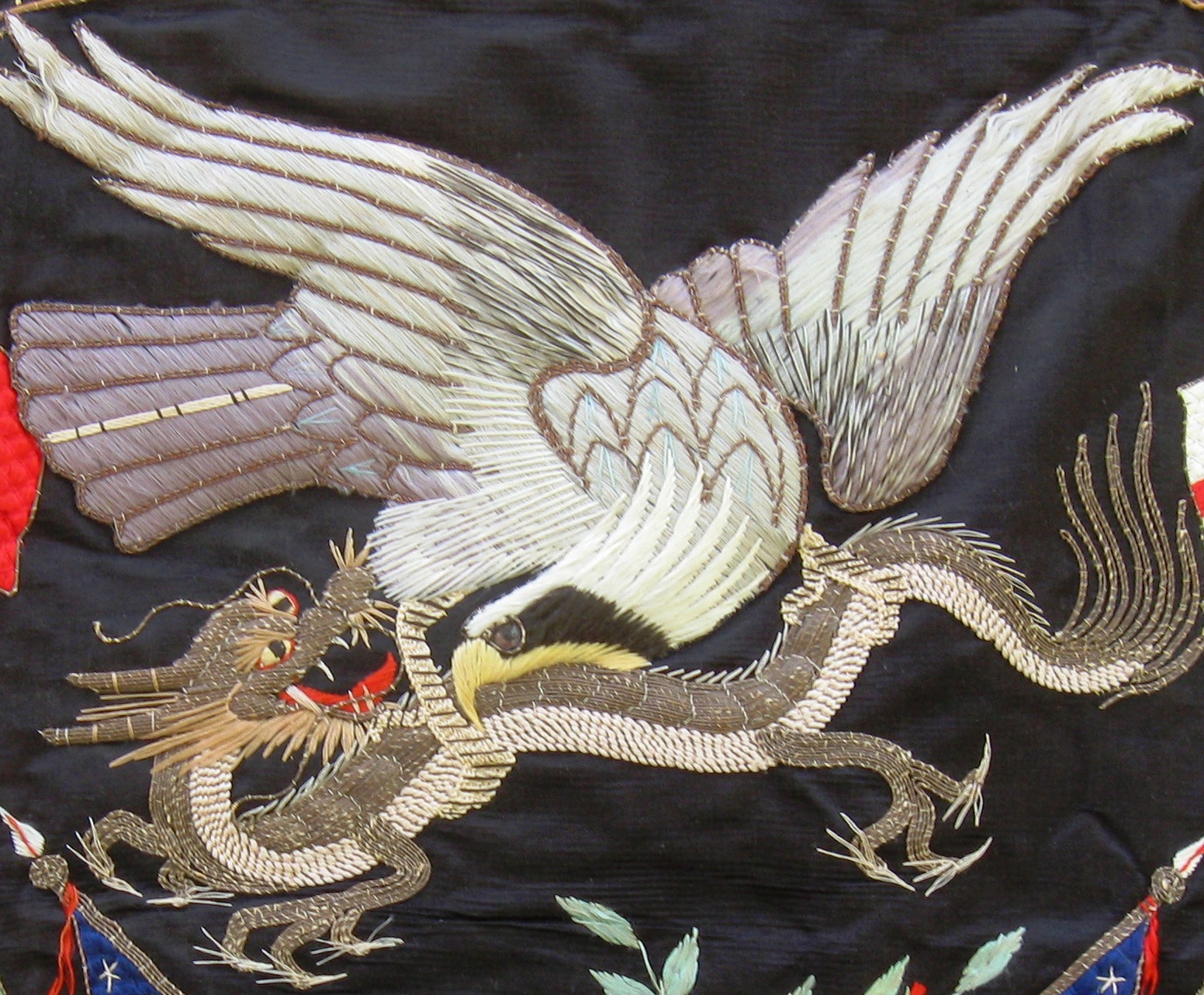
This silk scroll is the earliest I’ve seen to date specifically tailored for a Marine. Pvt Albert Torbutt enlisted for one cruise and found himself part of the Peking Legation Guard, which at the time was comprised of only one hundred men. Torbutt, hailing from Jasper County, Illinois was from a large farming family that included several sisters. Census records show he returned to the county following the end of his Marine Corps enlistment in 1911. He died there in 1970. The flags gracing this scroll represent the naval ensigns of the Great Powers who maintained a presence in Chinese waters. Also included is the yellow Imperial Dragon flag of 1890. The 1910 dated photo of the Marine is not Torbutt, but has been added to show how it would have appeared when complete.
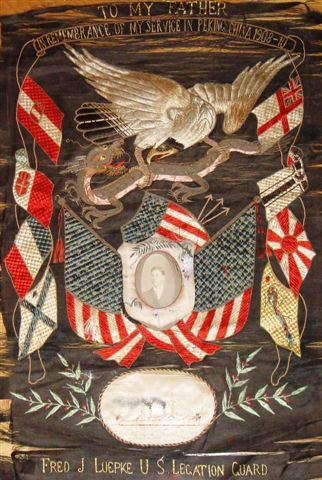
Another remembrance scroll also dated 1908-10, and made by the same Peking shop as above. Although this design is very similar to the previous scroll, there are subtle differences. The Marine who commissioned the scroll served as Lt Col George Barnett’s orderly while in China and accompanied Barnett to the Great Wall. Sadly, the scroll’s original owner was discharged early as it was determined he was suffering from TB.
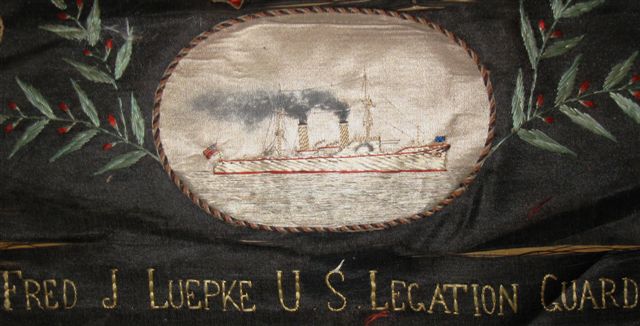
Note the ship the artist chose to copy appears to be a protected cruiser vice an armored cruiser as shown above.
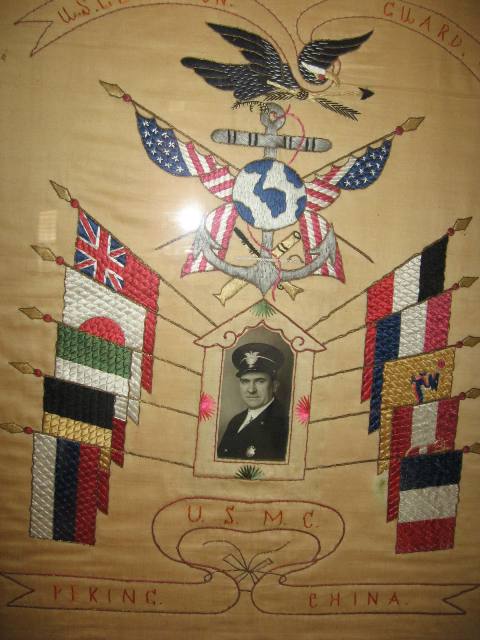
This scroll made in Peking soon after the ones shown above breaks all the conventions I expect for a rememberance scroll. On a light background and of sparse design, it stands out as being made with Marine's EGA as inspiration. The photo is of the original owner but long after he left the service (Courtsey of the Robert Gill Collection)
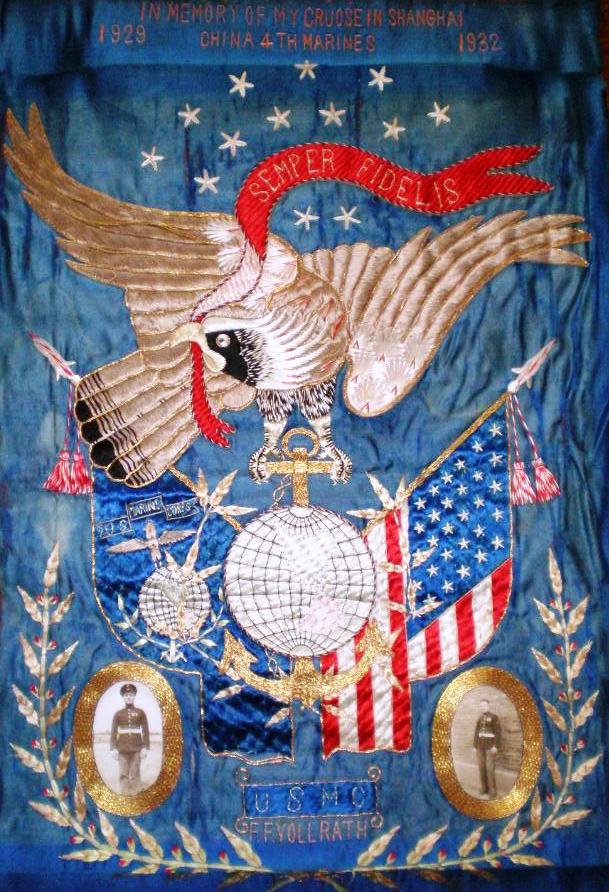
This stunning rememberance scroll was made for a Shanghai based 4th Marine. Scrolls from this period are much harder to find as they were falling out of favor with U.S. Servicemen stationed in China. Yet the quality of the needlework on this example is outstanding. (All photos shown of this scroll are courtesy of the Jeremiah Cable Collection)
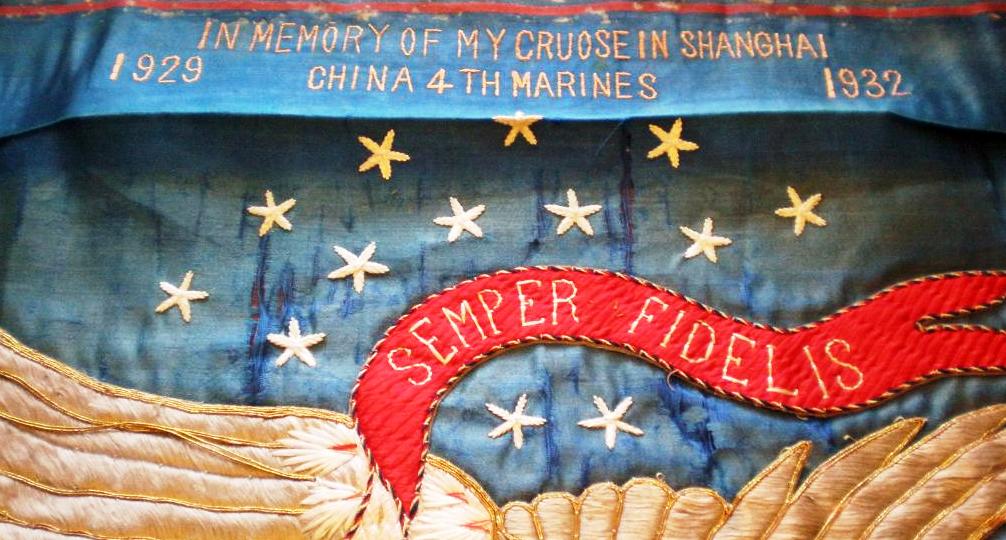
A detail of the scroll's title
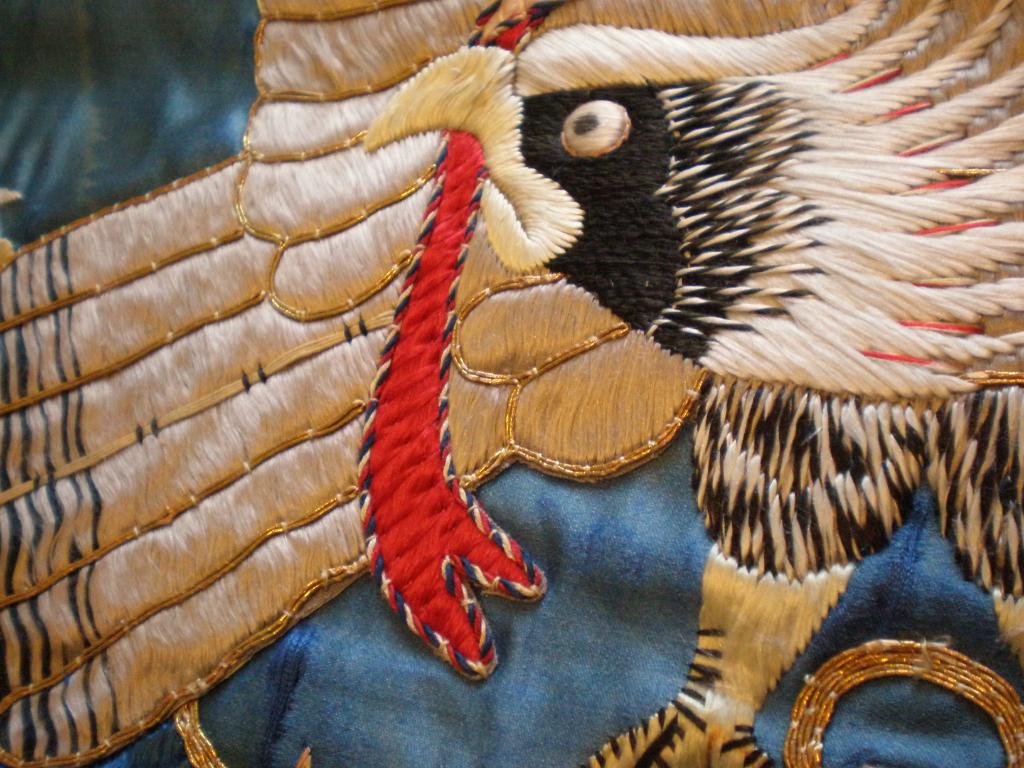
A detail of the eagle
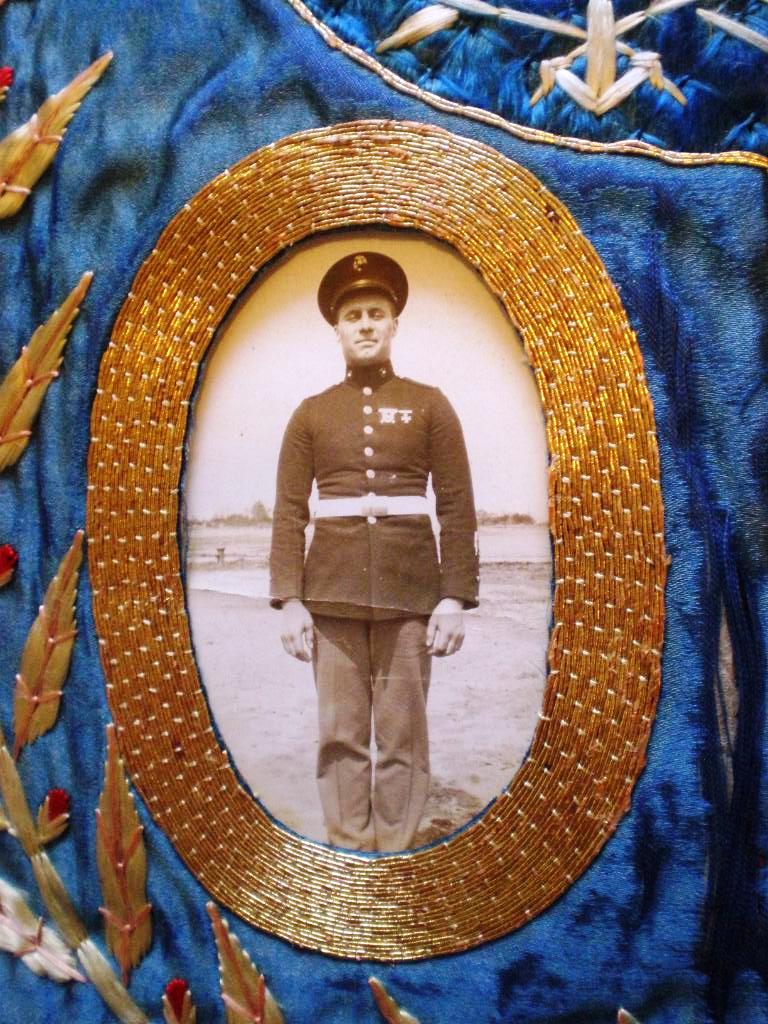
One of two images of the owner, Corporal Francis Vollrath. The gold silk around the frame stands out
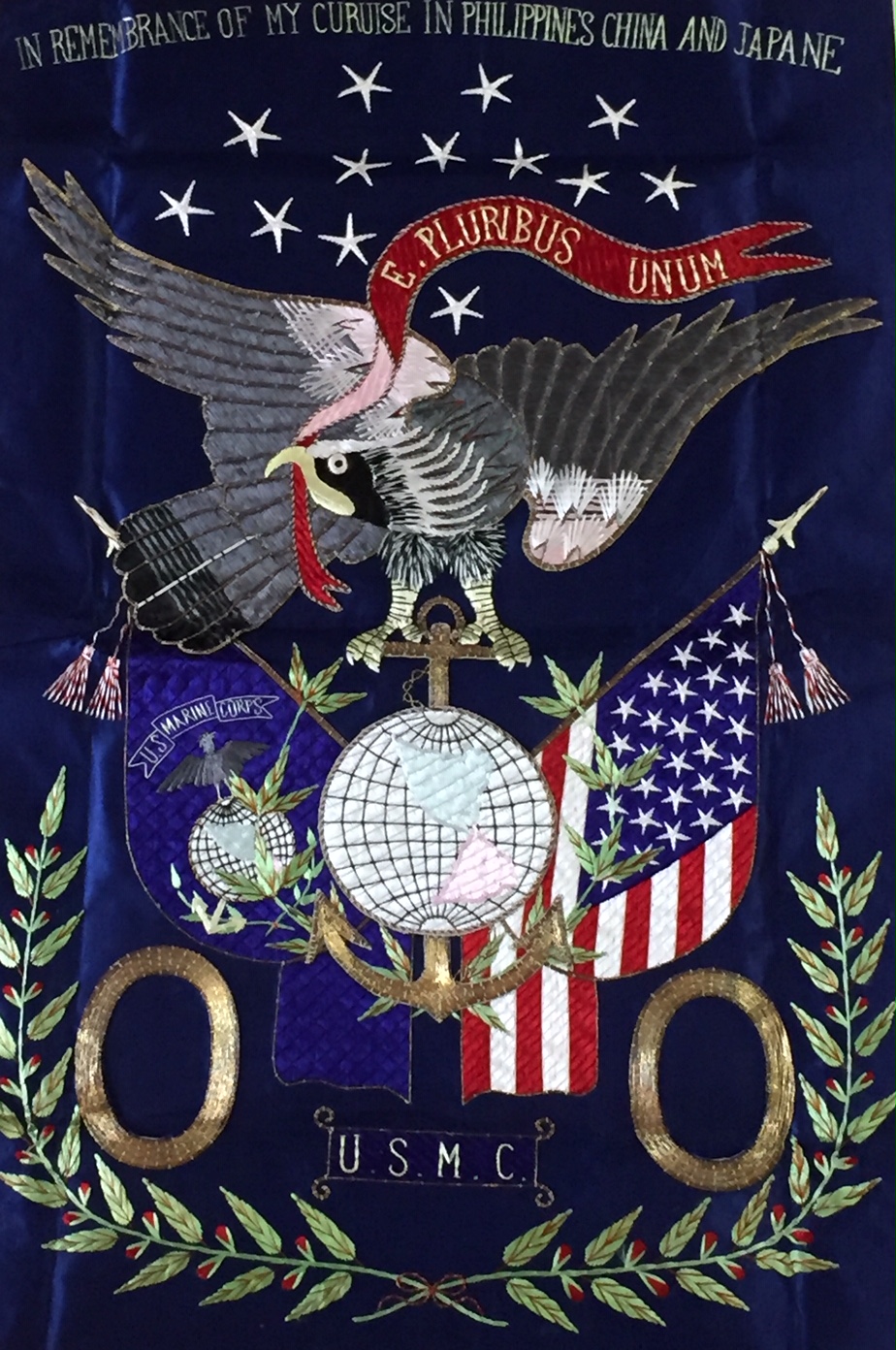
This scroll, almost identical to the one above, was purchased by Pvt Raymond Loomis of the Legation Guard, c. 1926-28. The scroll was manufactured by S. Iyda & Co. of Peking. Iyda was a Japanese owned company selling silks, embroideries, and curios from a store near Hatamen Street. According to Loomis's family, the scroll was never displayed, and so remains as vivid as the day it was made.
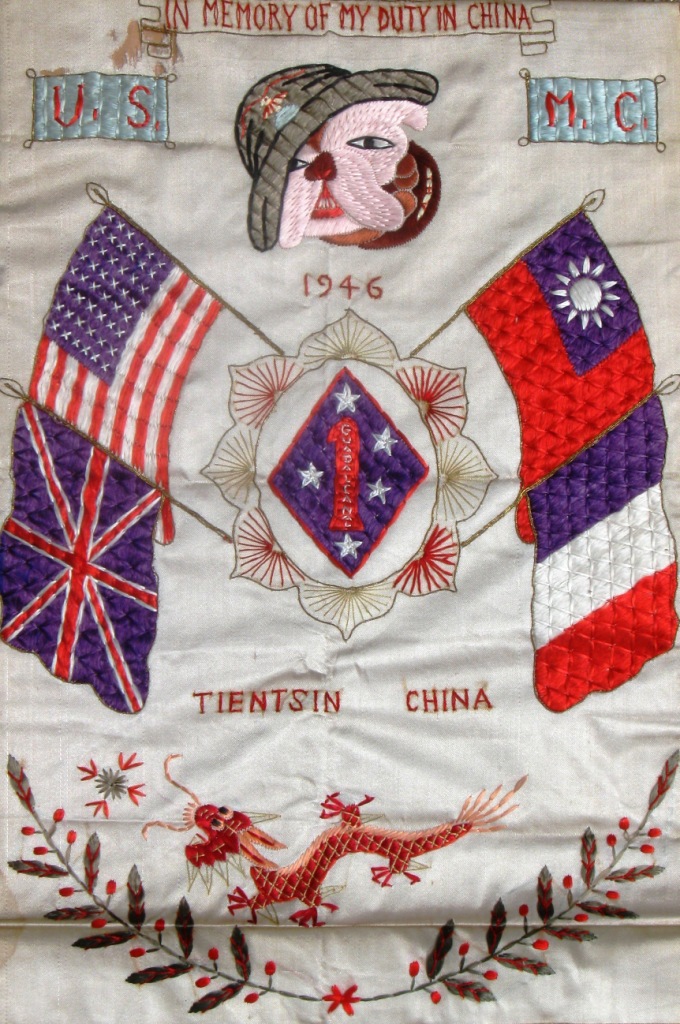
Post-War Remembrance Scroll. This 1st Marine Division themed scroll represents the final evolution of this type of art form. Now much smaller than pre-war scrolls and showing a lesser quality of needle-work, it appears local craftsman combined elements of pre-war Marine embroidery design with Japanese inspired themes to create this silk souvenir. See the embroidered photo album section above for comparison.
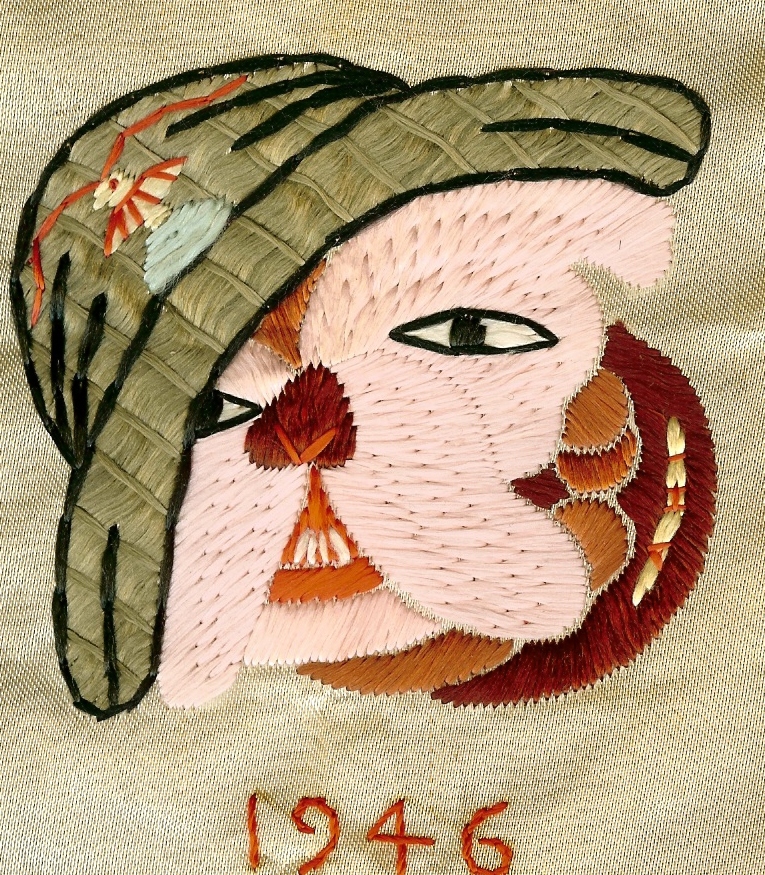
A close up of the needle work. I’ve seen another example of this type of scroll with the Marine “Devil Dog” but with a black silk background.
Silk:

General Smedley Butler in his Pennsylvania home following his return from China with his two umbrellas of Ten Thousand Blessings. The General was presented these umbrellas by the Chinese Government for his good works on behalf of the Chinese people. (Photo courtesy of the Butler family)
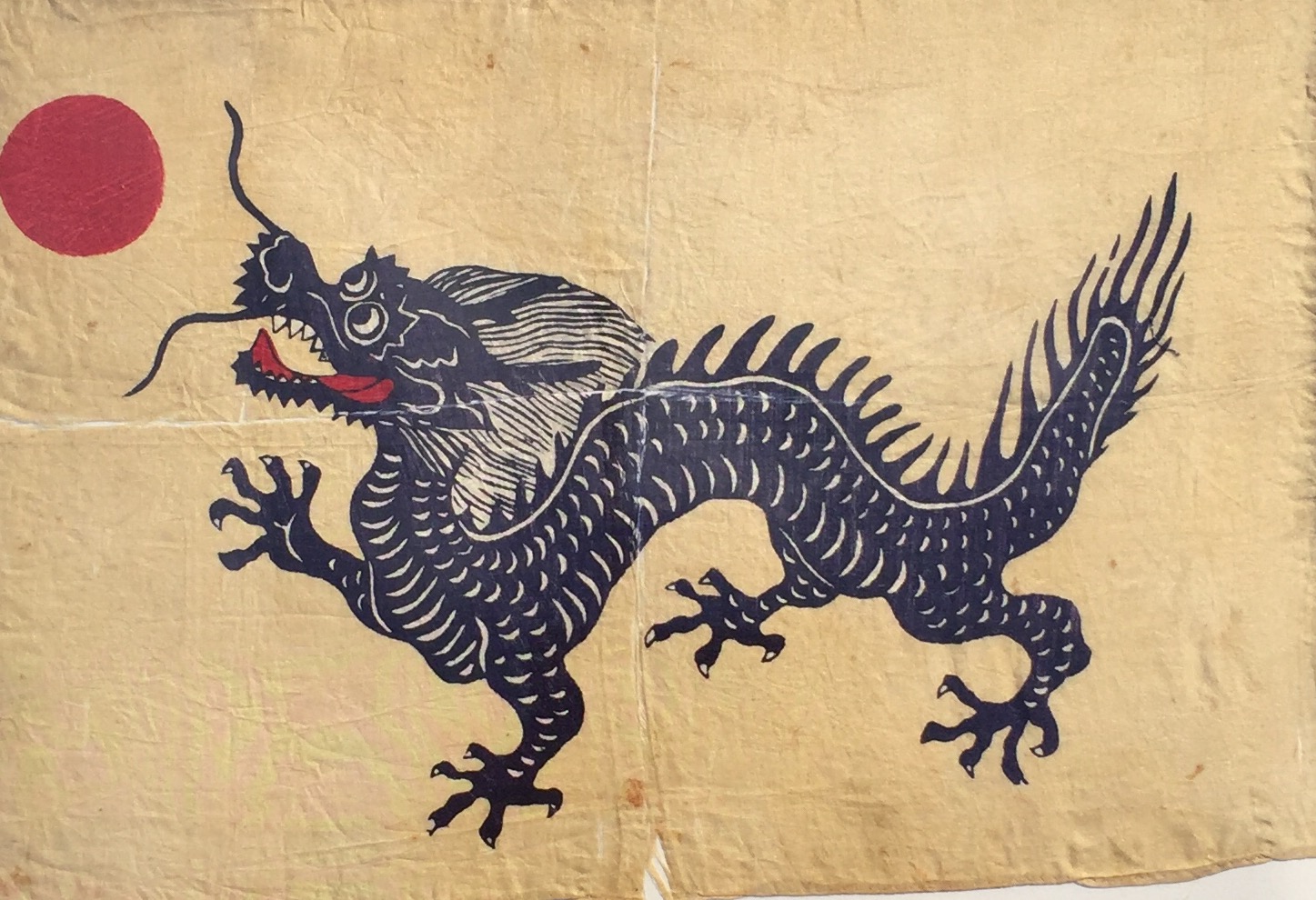
A small Imperial Chinese Dragon flag in silk, brought back by a China Marine soon after the 1911 Revolution.
Silver:
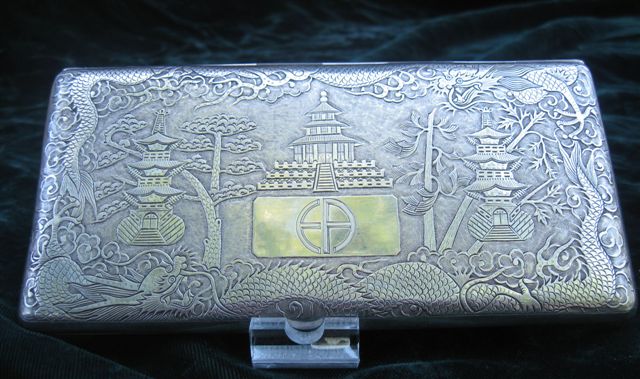
A silver cigarette case. Attributed to Teh Ling, a Chinese silversmith in Peiping
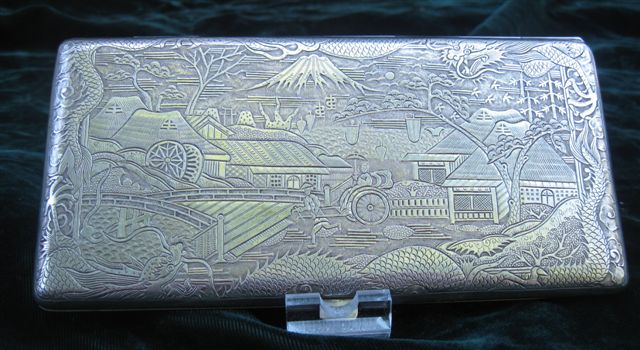
The reverse of the case shown above. This design appears on several cases belonging to Peiping Marines. Only the style of script and the Marines initials are different on each known example
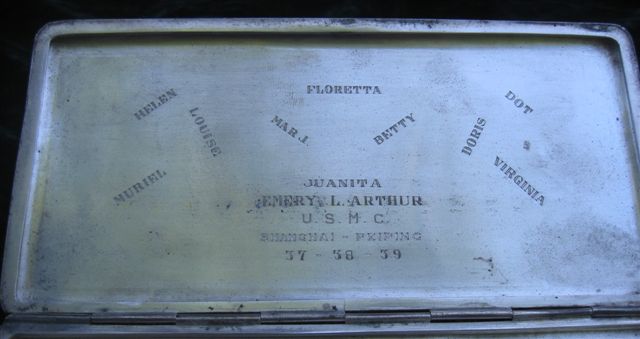
The interior lid of the cigarette case. What is interesting with this example was the Marine added a number of female names he was associated with while in China
.jpg)
A post-World War II silver cigarette case to a 1st Division Marine
.jpg)
Reverse side of the case above with the engraving to the Marine
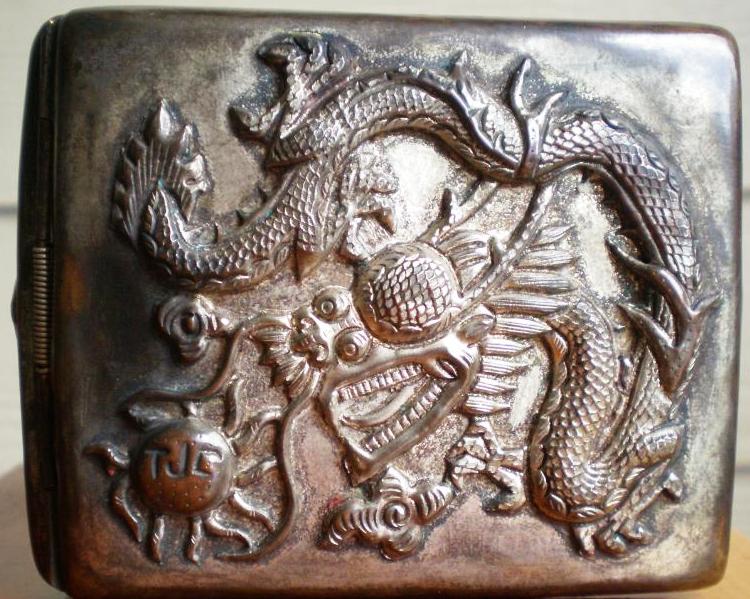
Another post WWII cigarette case. Following the end of the war, Chinese craftsman quickly produced a number of military themed souvenirs aimed at newly arrived American servicemen (photo courtsey of Jeremiah Cable)
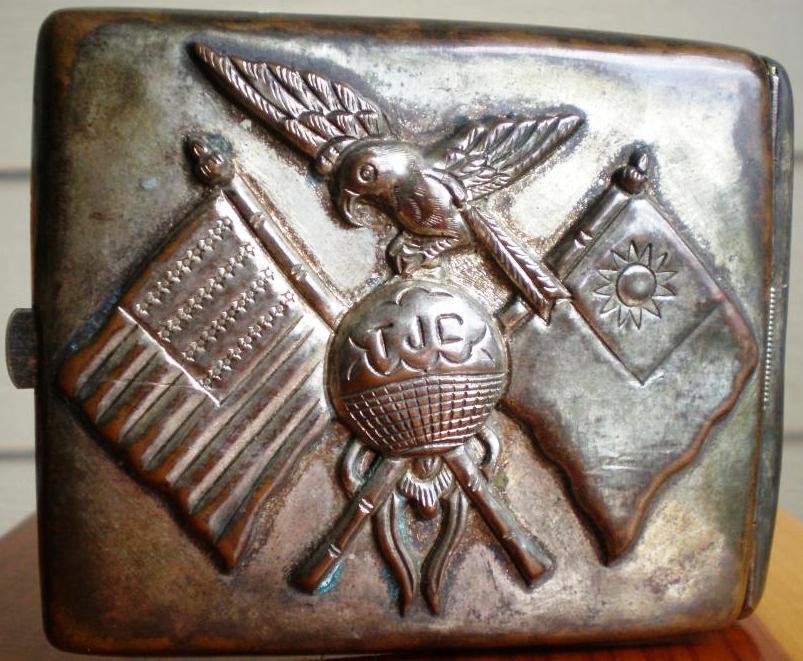
The reverse side of the cigarette case
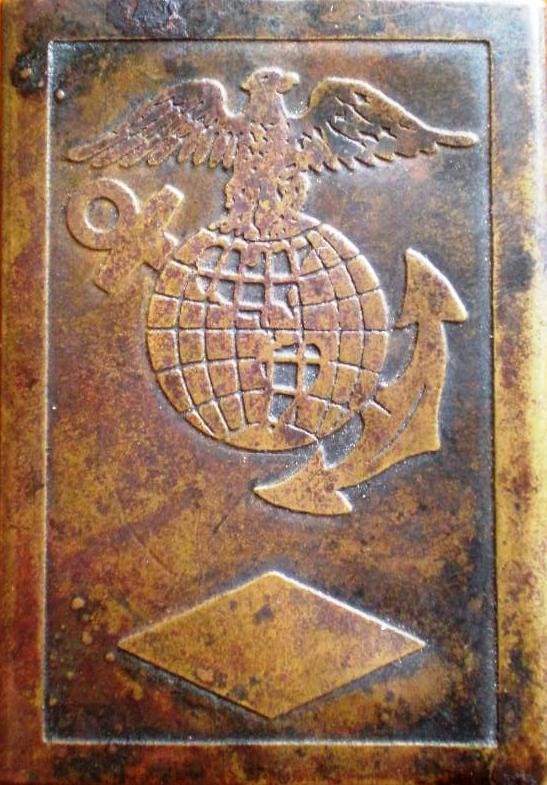
A Marine themed silver money clip believed to have been made in China (courtesy of the Jeremiah Cable collection)
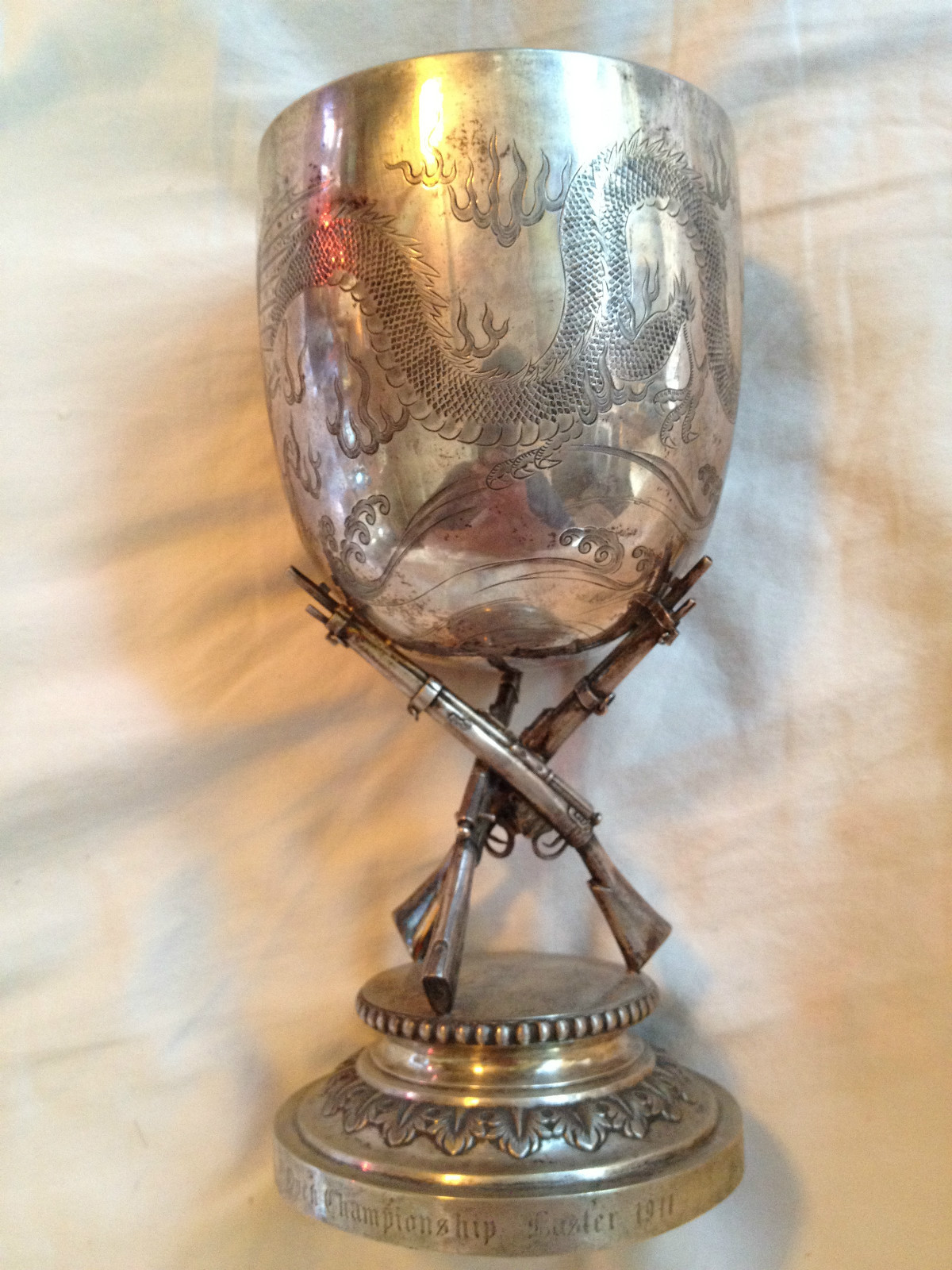
Silver Shooting Trophy. This stunning trophy honors Pvt Alton Shaffer, winner of the 1911 Tientsin Rifle Club Open. The cup was made by Hung Chiong & Co. (Photo shown with the premission of elgatoca)
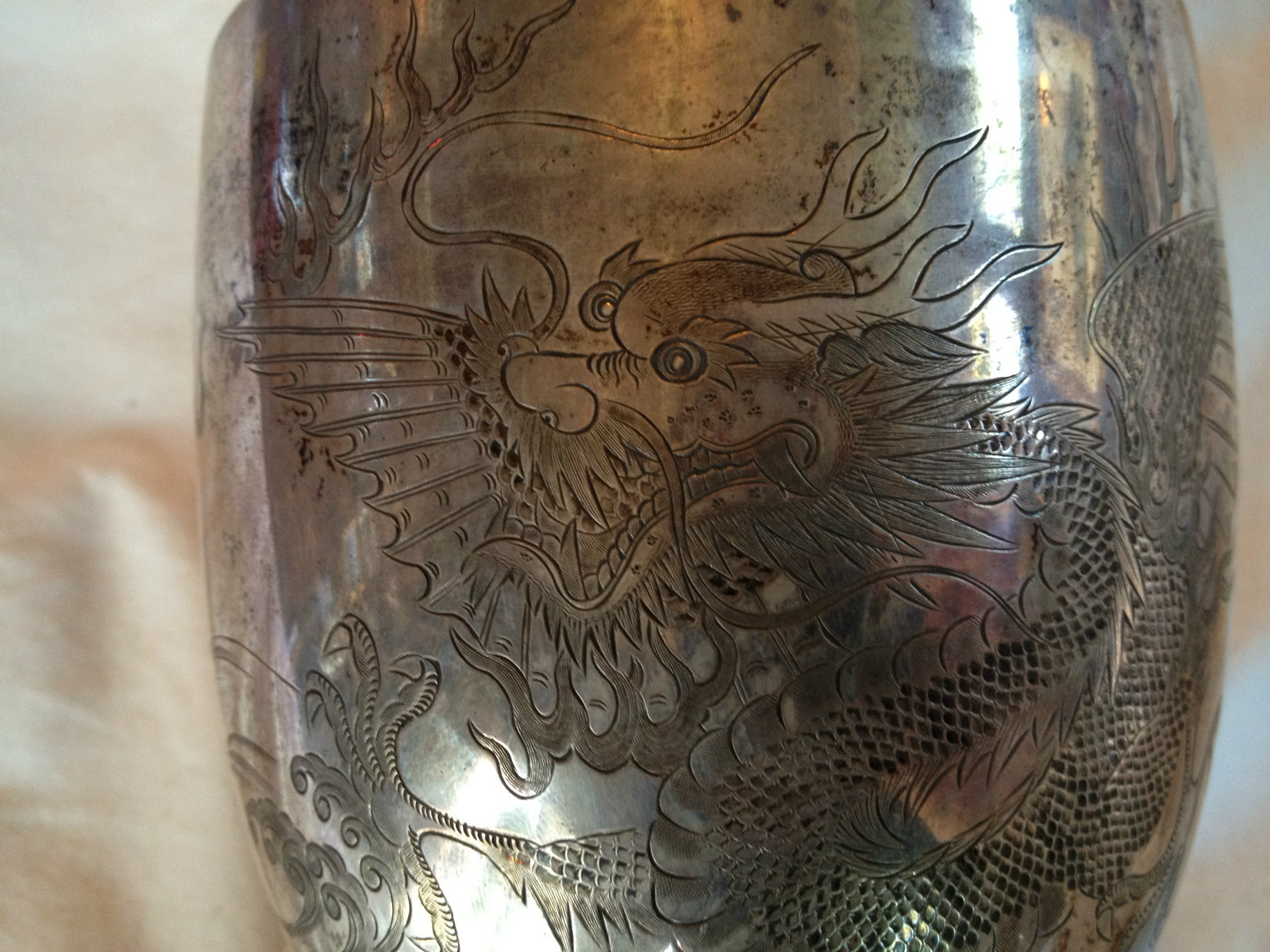
Detail of Shaffer's trophy. A photo of Shaffer, and the other award winners with his trophy appears in the Peking section of this web site. (Photo shown with the permission of elgatoca)
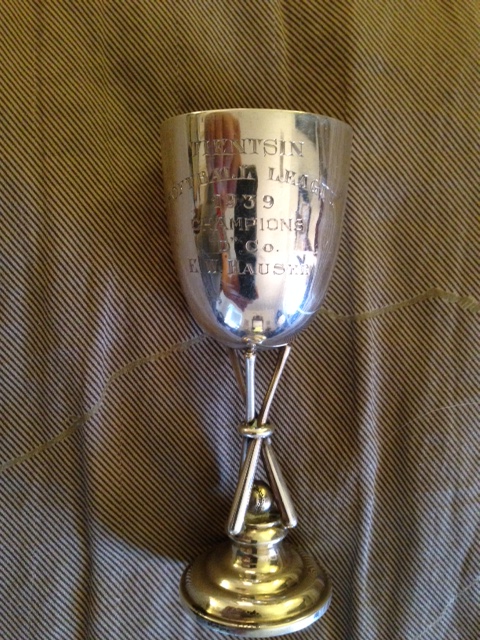
Small sterling silver softball trophy awarded to PFC Emil Hauser December 1939. This trophy was produced by M. Levy, a jeweler located inside the Peiping Legation Quarter in the 1930s, and awarded to each member of the Company D softball team.
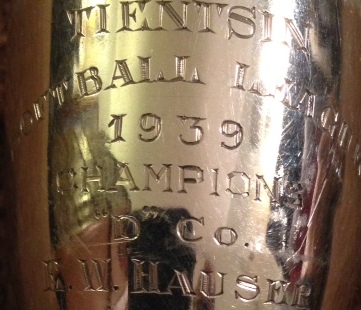
Detail of PFC Hauser's trophy
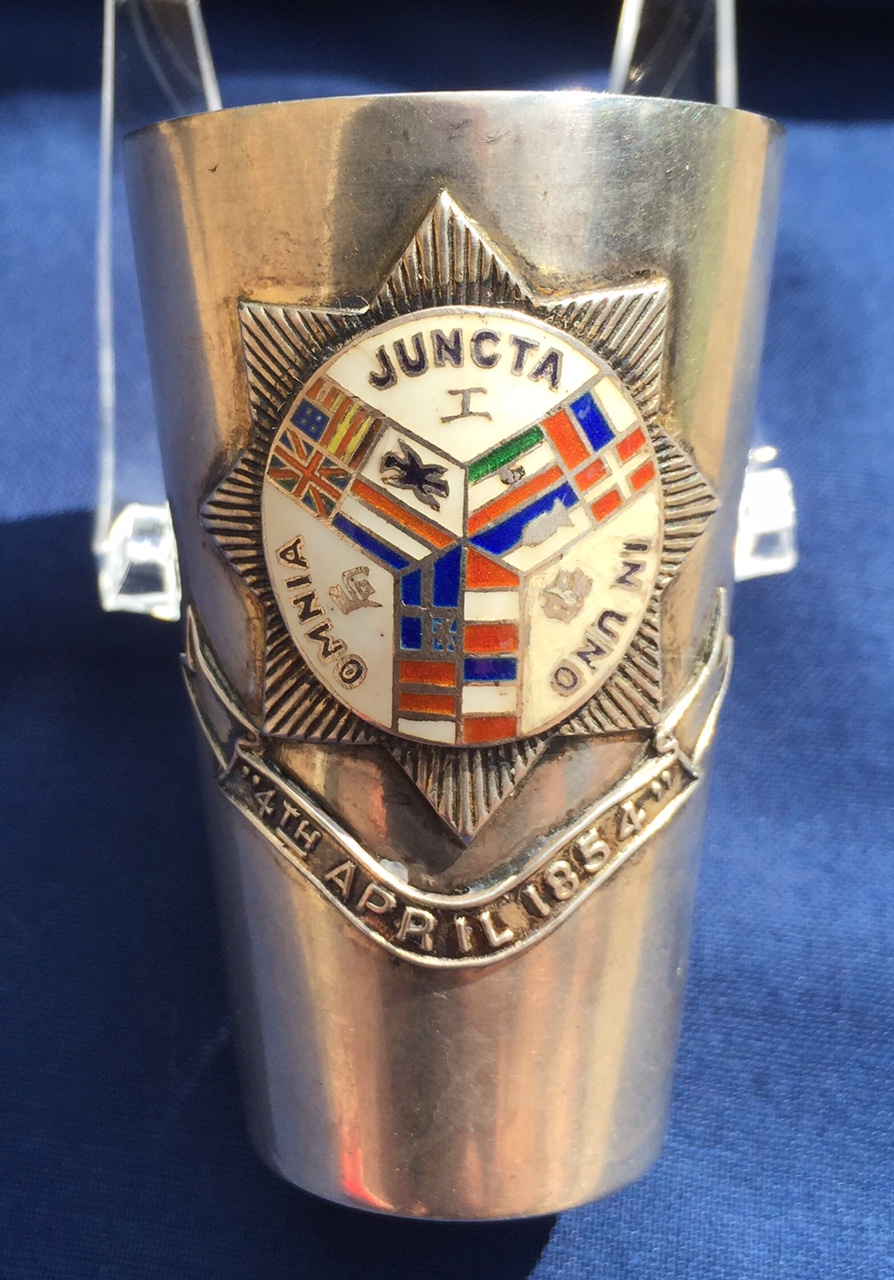
Small silver Shanghai Volunteer Corps (SVC) boxing trophy awarded to a Marine
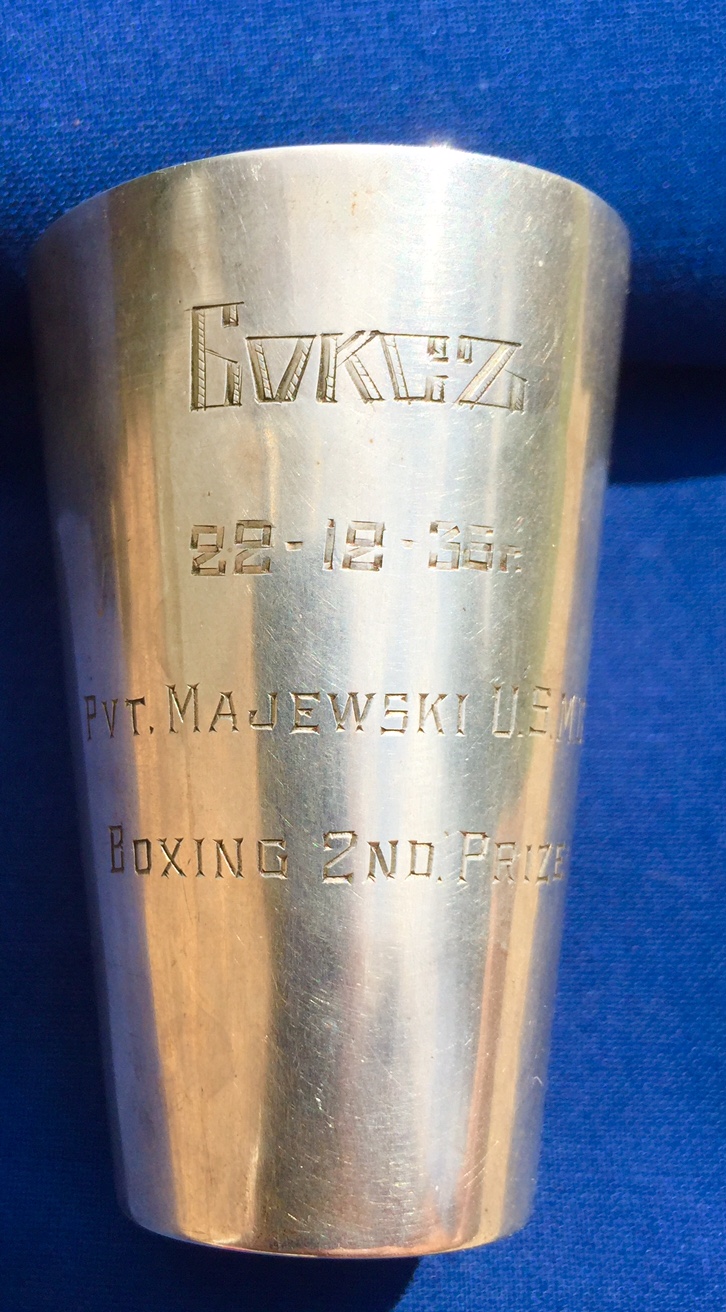
Reverse of the SVC boxing trophy
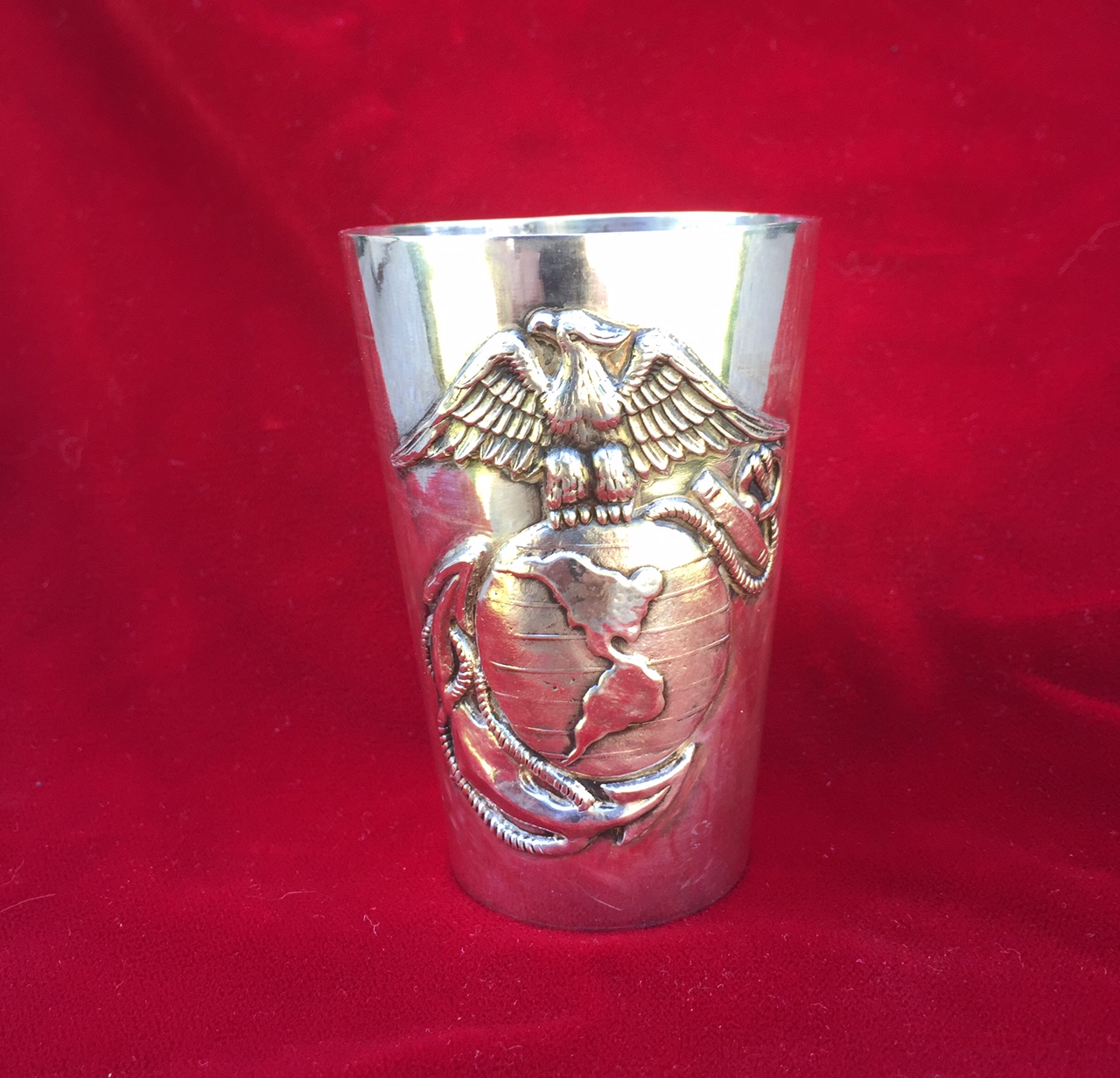
Sterling silver Cup with a stylized EGA design. The makers mark indicates the silversmith was named Chen.
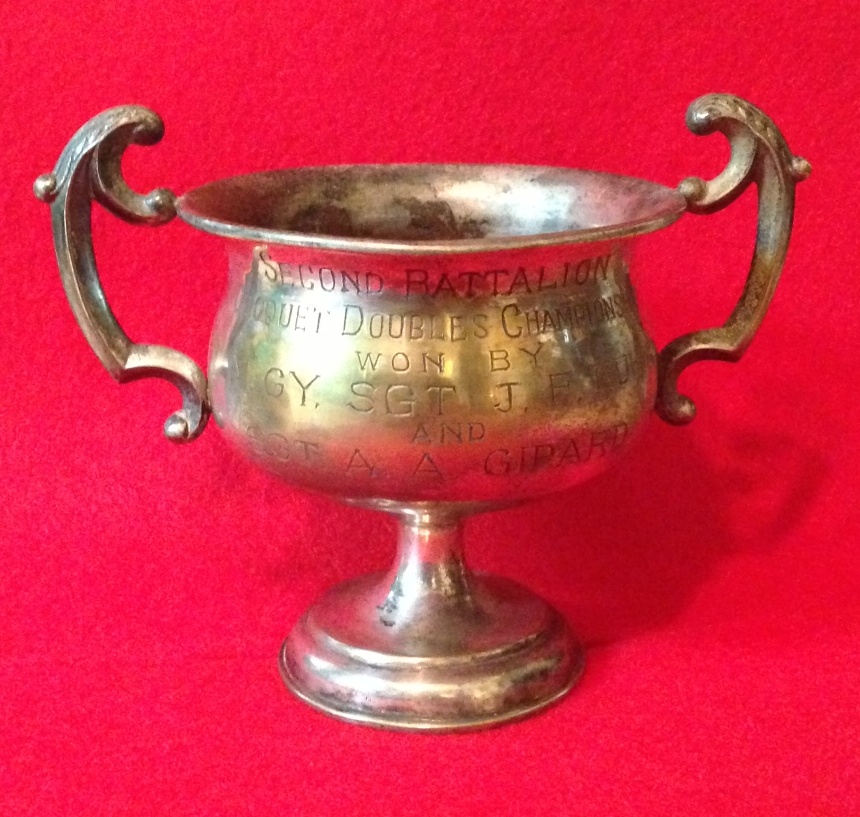
Silver Plated 4th Marines, 2nd Battalion Croquet Trophy, 1939. No makers mark visible
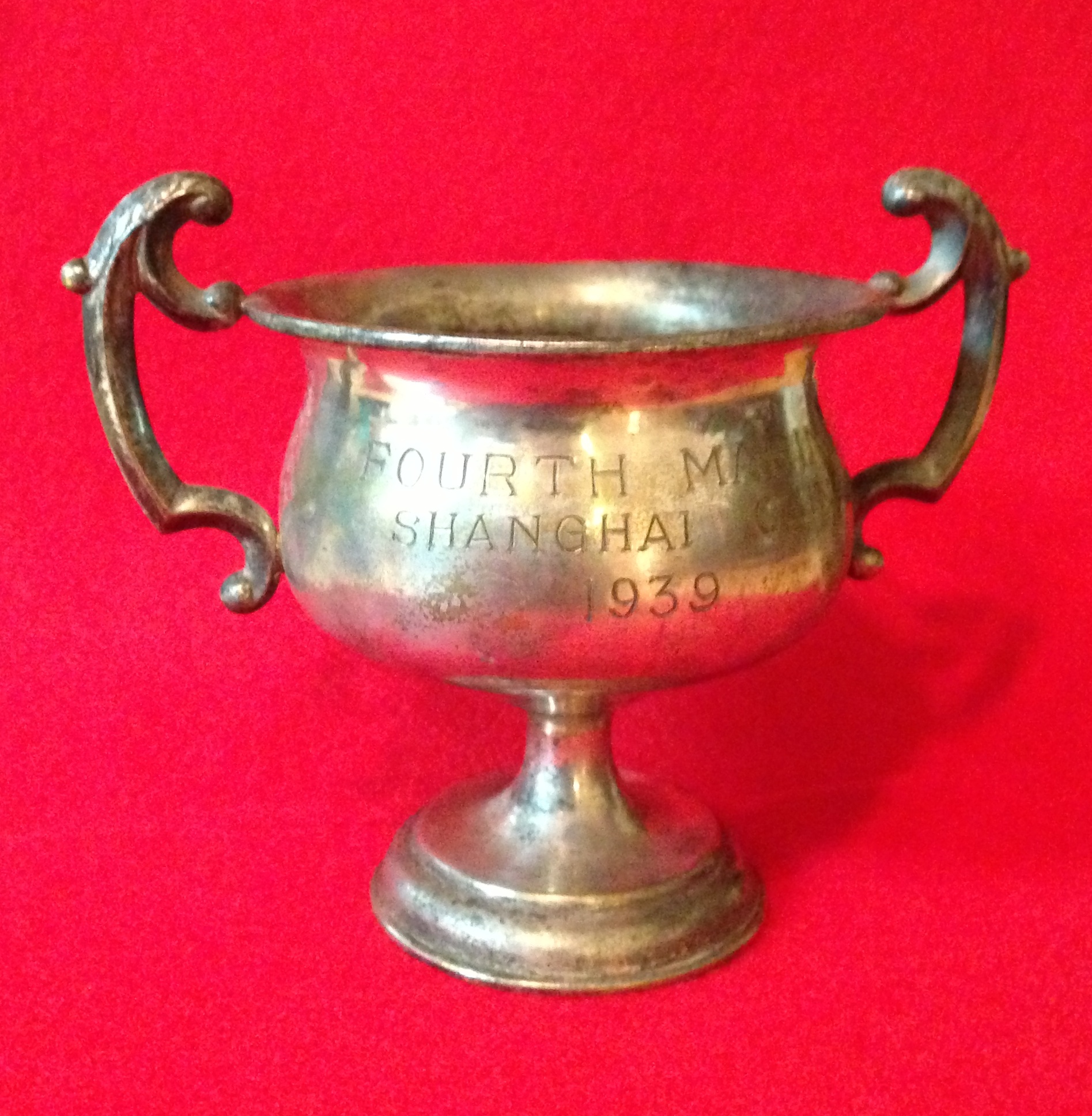
Reverse of the Croquet Trophy
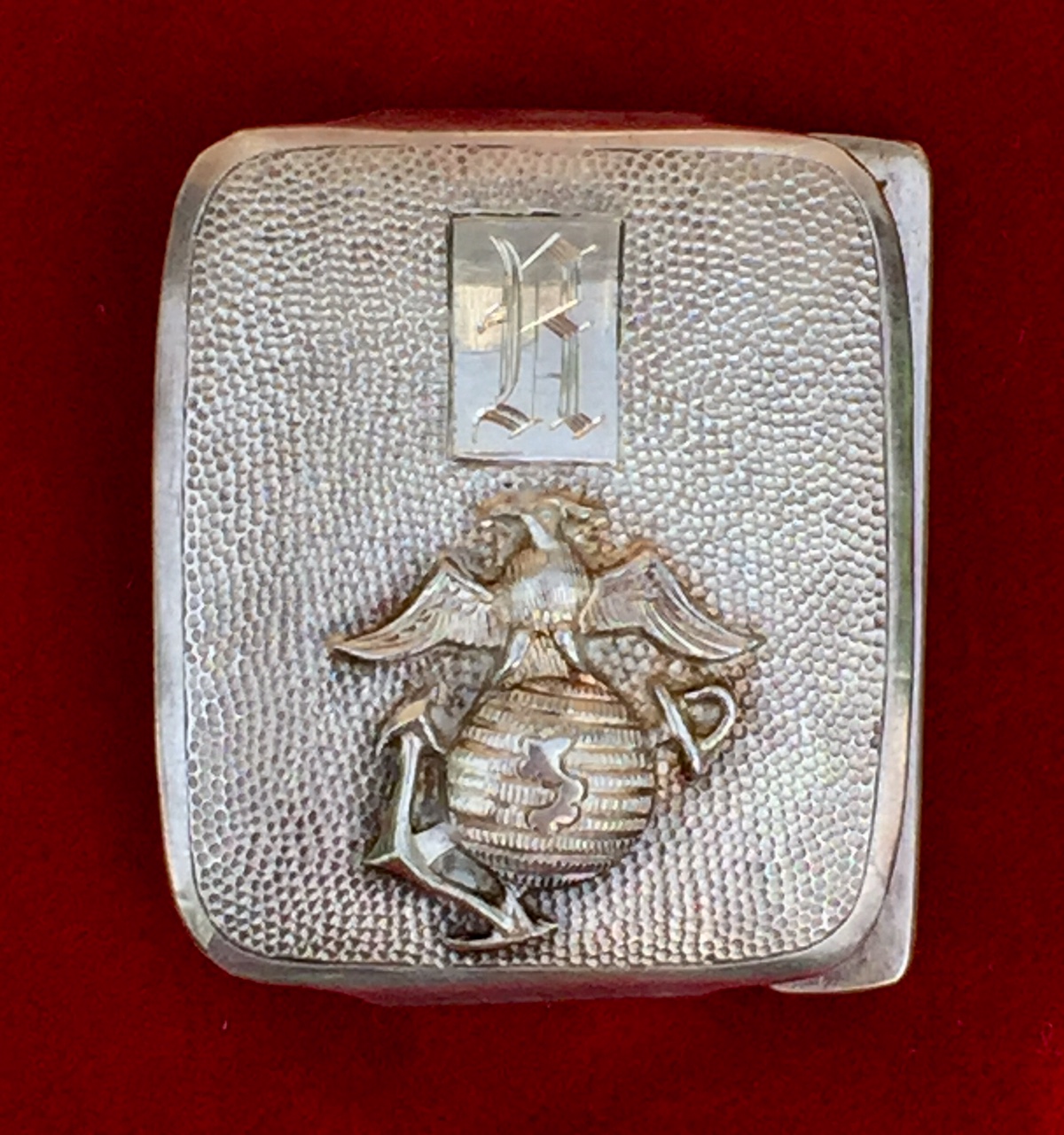
Sterling silver belt buckle made by Peiping based jeweler Teh Ling.

General Smedley Butler's Riding Crop. This is one of two riding crops the General was photographed with while in China 1927-29.

The silver hook of the crop showing the engraving to the General.
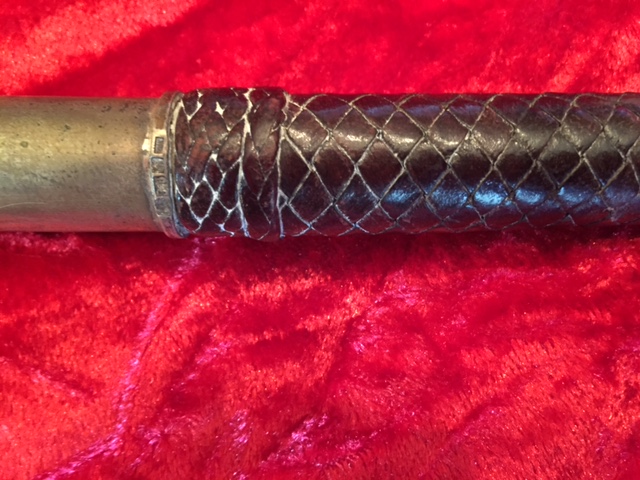
A close up of the markers marks and silver content.

A frame captured from a movie taken by the American Minister to China, John MacMurray, showing the General clowning around and waving this exact crop outside the American Ministers residence in Peiping c. 1928. (Frame courtesy the Mudd Library, Princeton)
Pewter
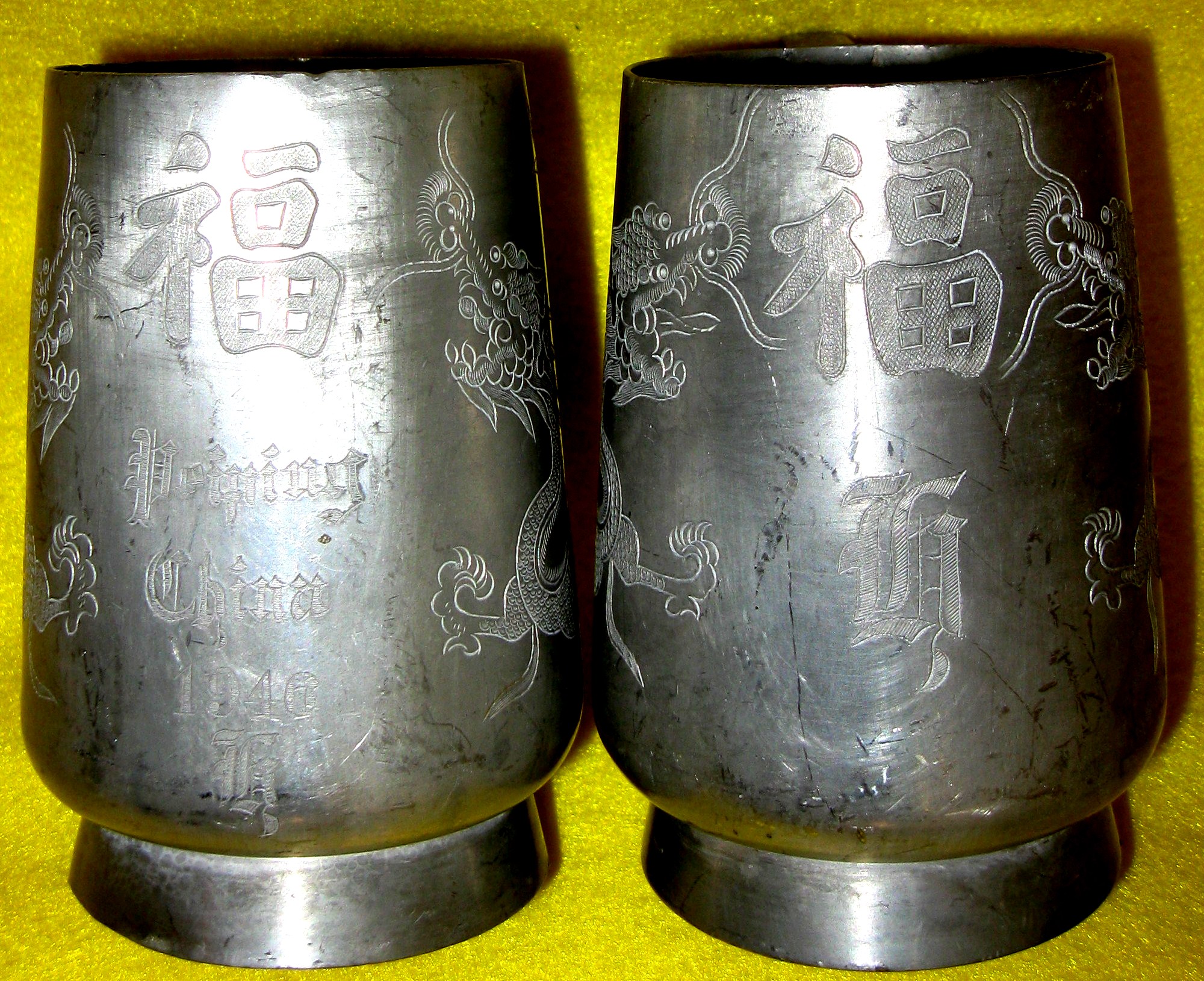
A pair of post-WWII dated pewter dragon motif mugs. One of the mugs reads "Peiping China 1946."
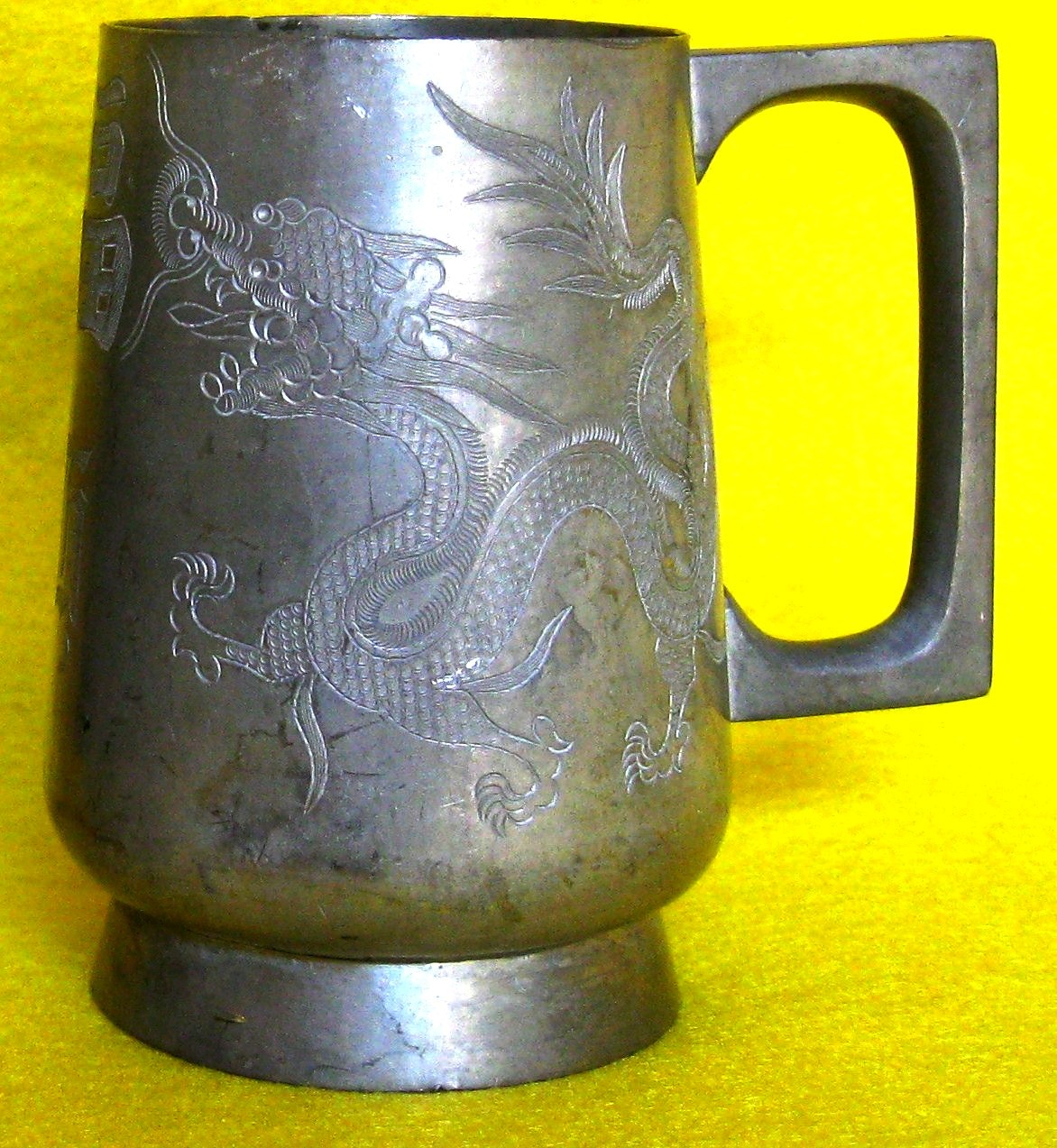
A side-view of one of the mugs shown above
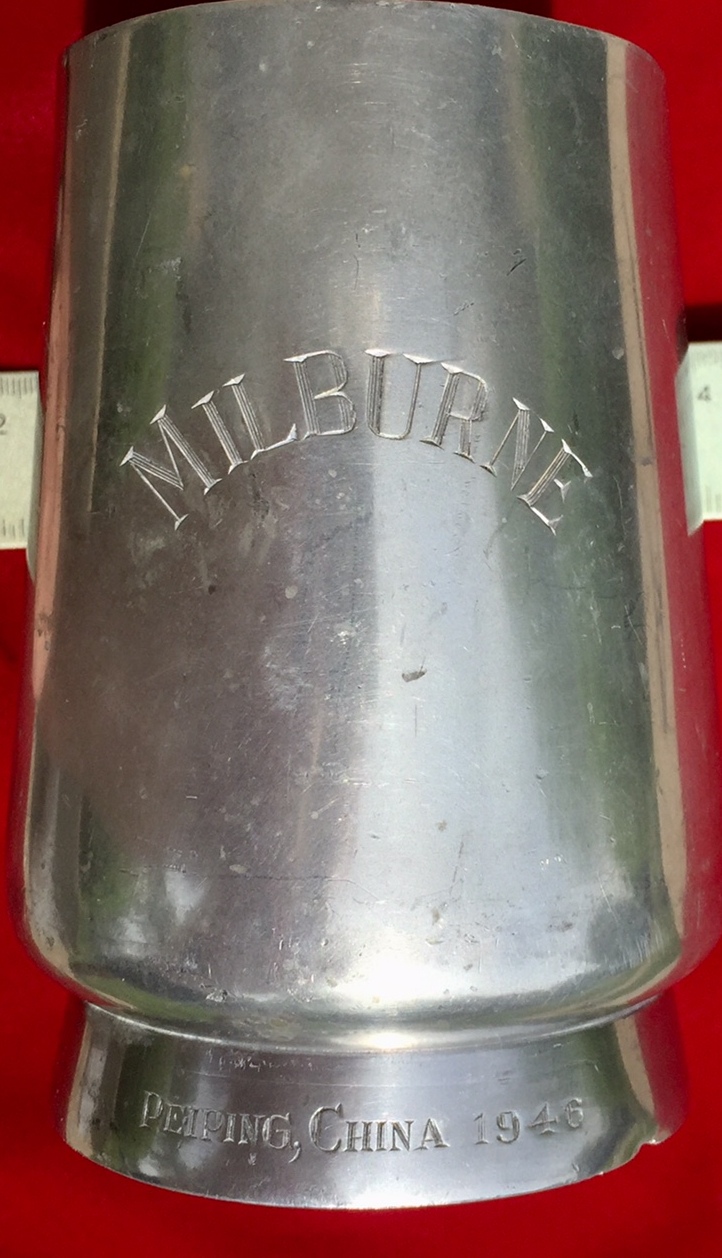
A post-war pewter mug from an unknown Peiping manufacturer. This mug is of higher quality than the mug pictured above.
Brass and Copper
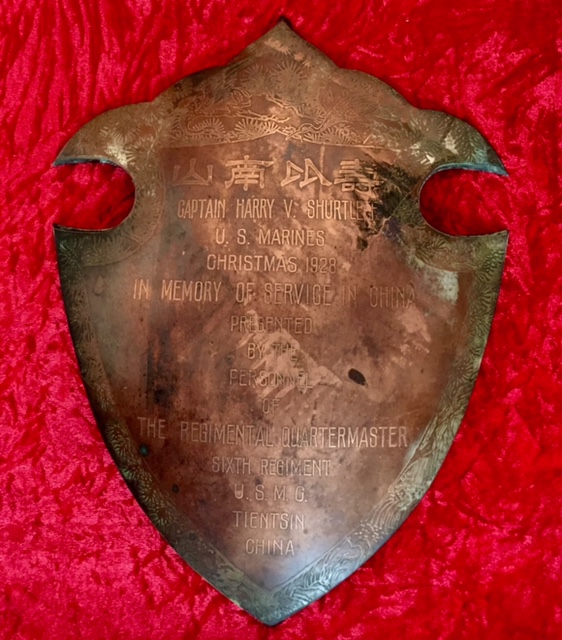
A Chinese-made plaque in copper for a departing Marine Officer. This would originally have had wooden frame of a similar shape surrounding the plaque, but the wood frame is now missing.
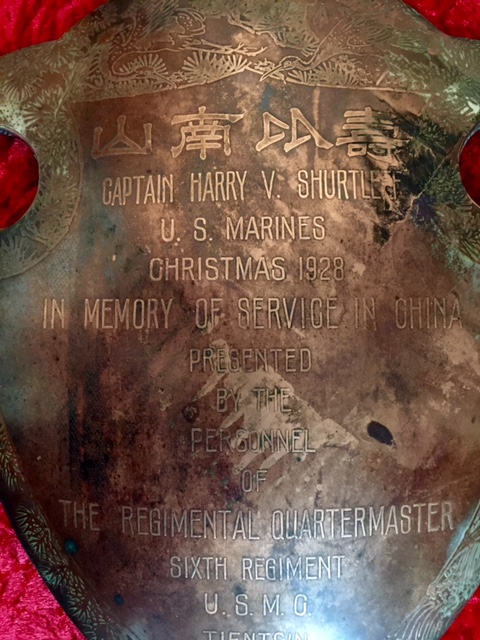
A detail of the plaque
Swagger Sticks
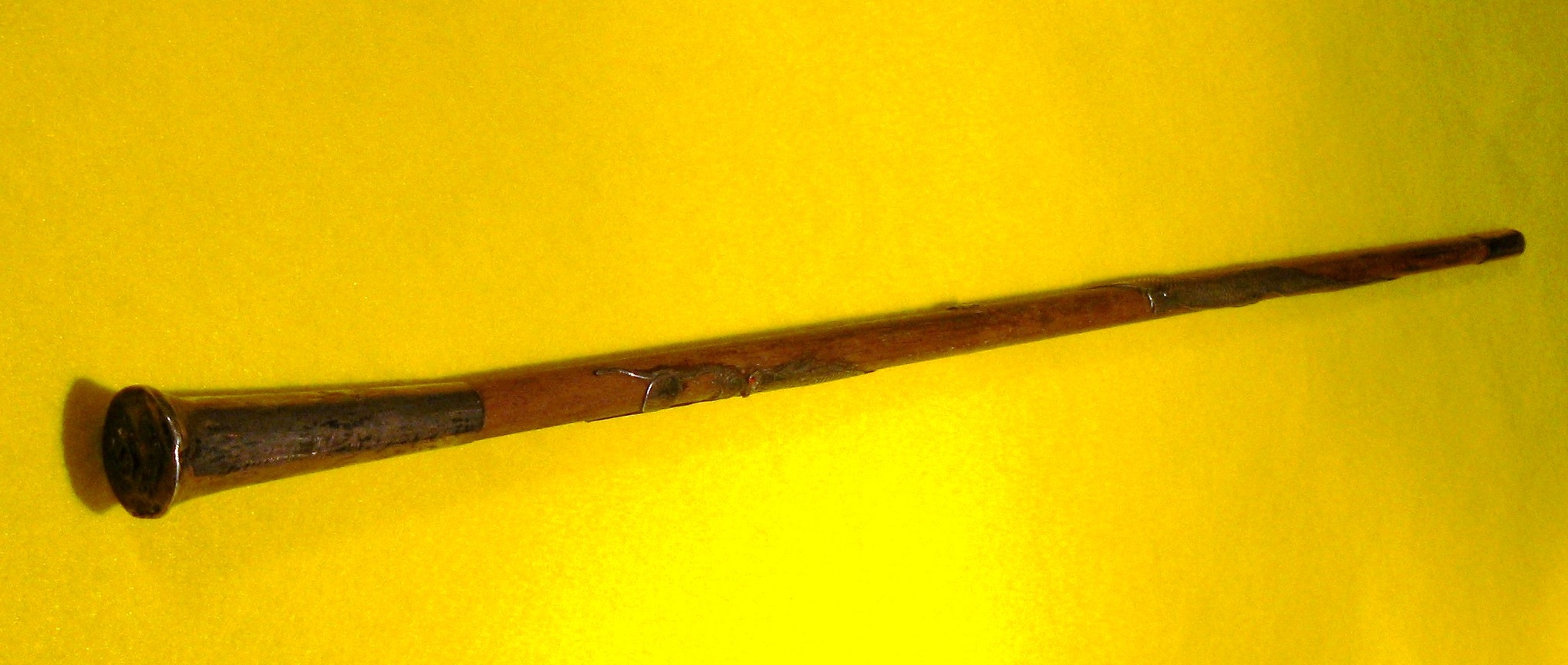
Dragon Motif Swagger Stick. Both Marine officers and enlisted men carried swagger sticks during their time in China. I believe the idea was adopted initially by copying the British, who were the dominate Great Power in China at the start of the Twentieth Century. Such sticks could be as simple as a homemade model made by using a piece of wood and a shell casing or as ornate as the example shown here, which was most likely made by a Chinese silversmith. This example although heavily worn, is capped with an EGA design and features a Chinese dragon wrapped around the length of the stick. The eyes appear to be two small semi-precious red stones. The markers mark shows this piece is by Teh Ling, a silversmith based in the Legation Quarter of Peiping.
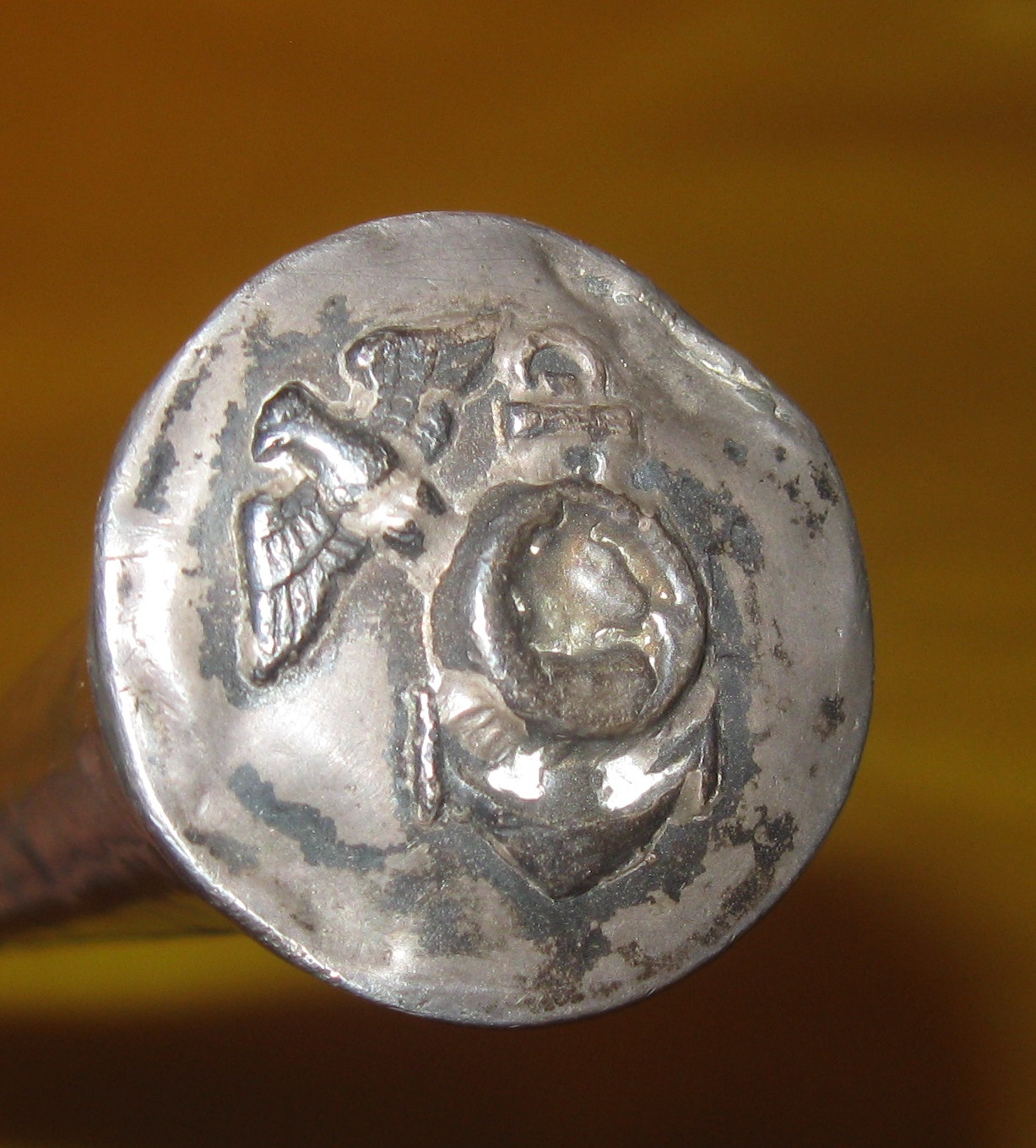
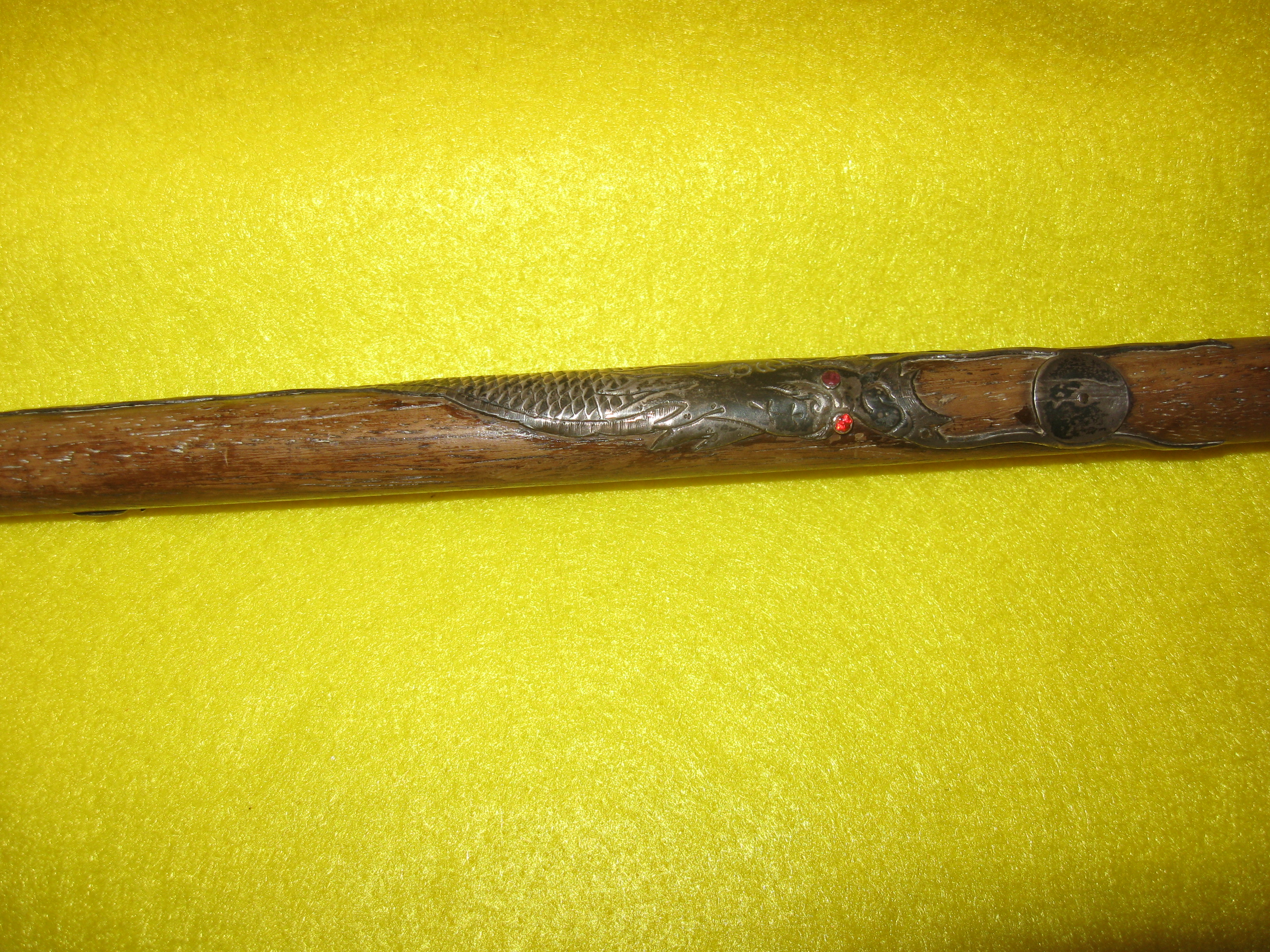
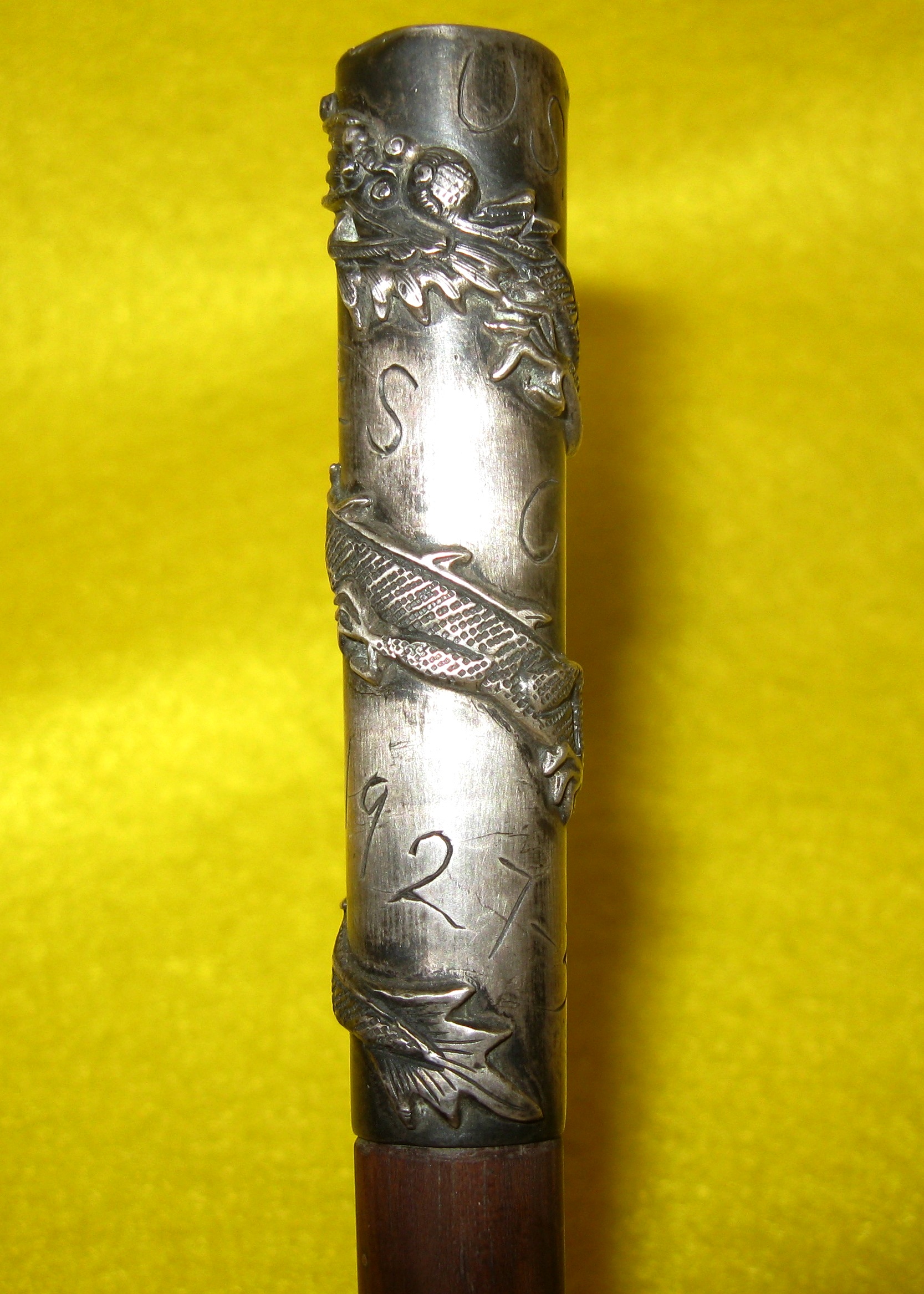
This double dragon swagger stick had a dragon wrapped around its silver top (shown above) and a second, larger dragon around the wooden shaft. Alternating between the bands of the upper dragon's body a Marine had the words "U.S. Marines China-1927-30." engraved.

A detail of the dragon running the length of the swagger stick

A Post-War Dragon swagger stick. The hollow shaft is made of thin metal, painted black and is caped at one end by a pistol round. Inside the shaft is a small steel dagger with engraved dragon on the blade. The grip is brass, with a dragon design and flowers, topped by a Eagle, Globe and Anchor.
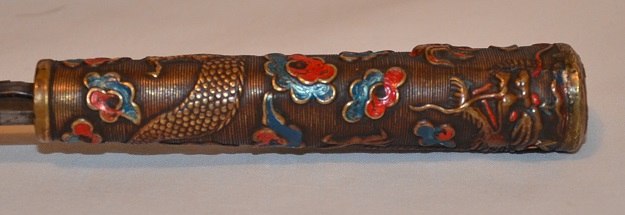
The cast grip of the swagger stick described above. Given the overall lack of quality in this swagger stick's construction, items like this were quickly made to be sold to Marines as they flooded the country at the end of WWII.
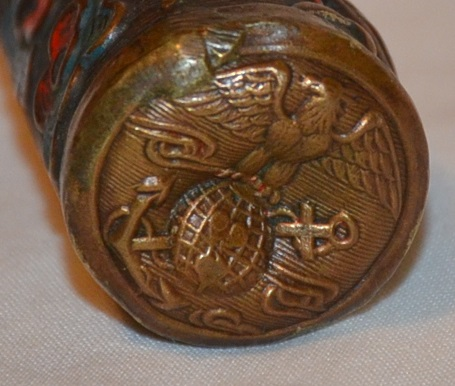
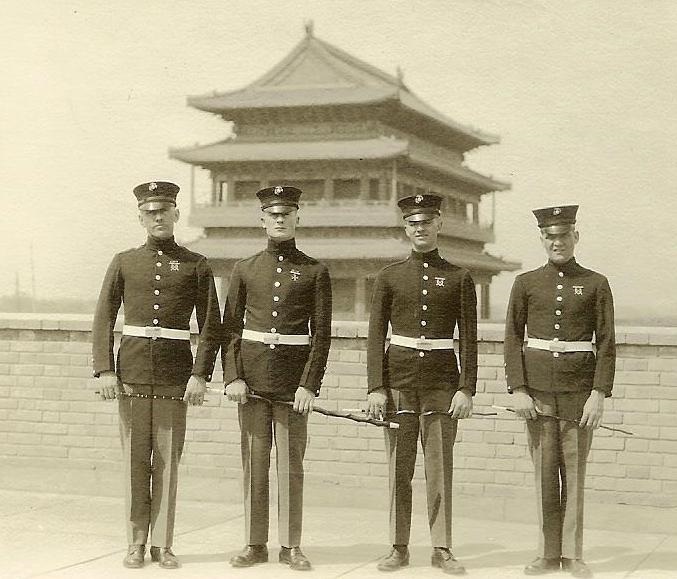
Marines with their swagger sticks
Walking Stick
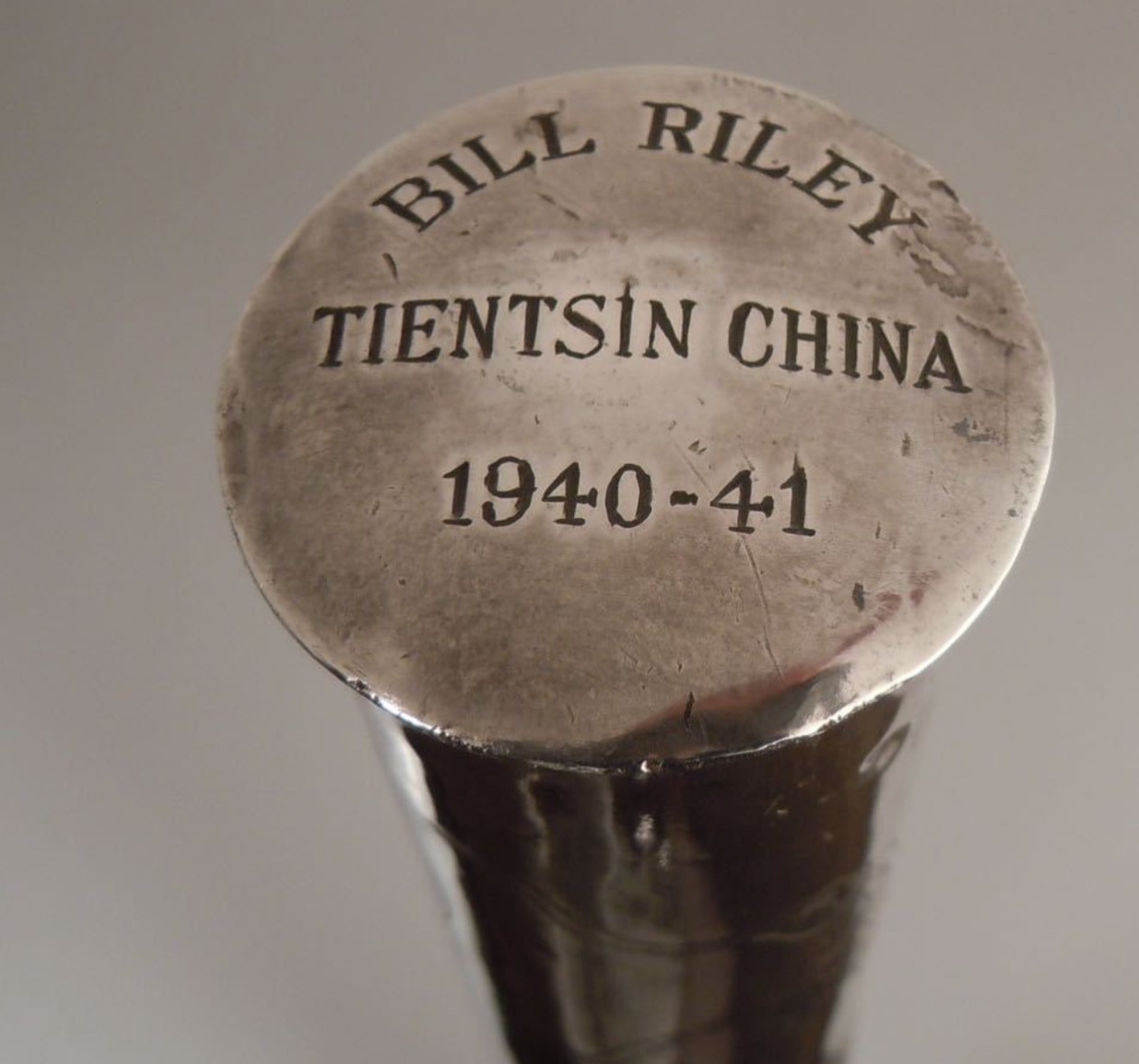
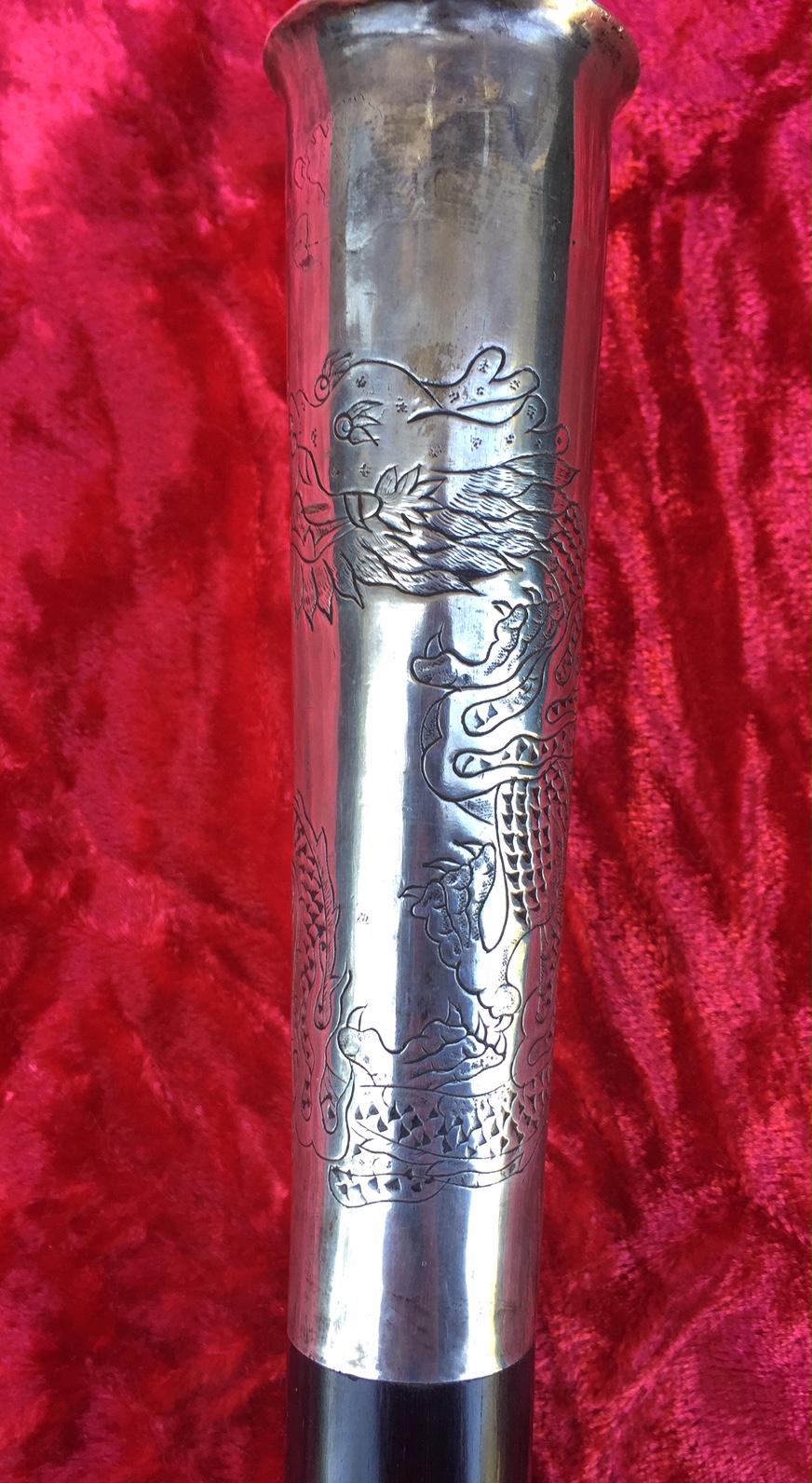
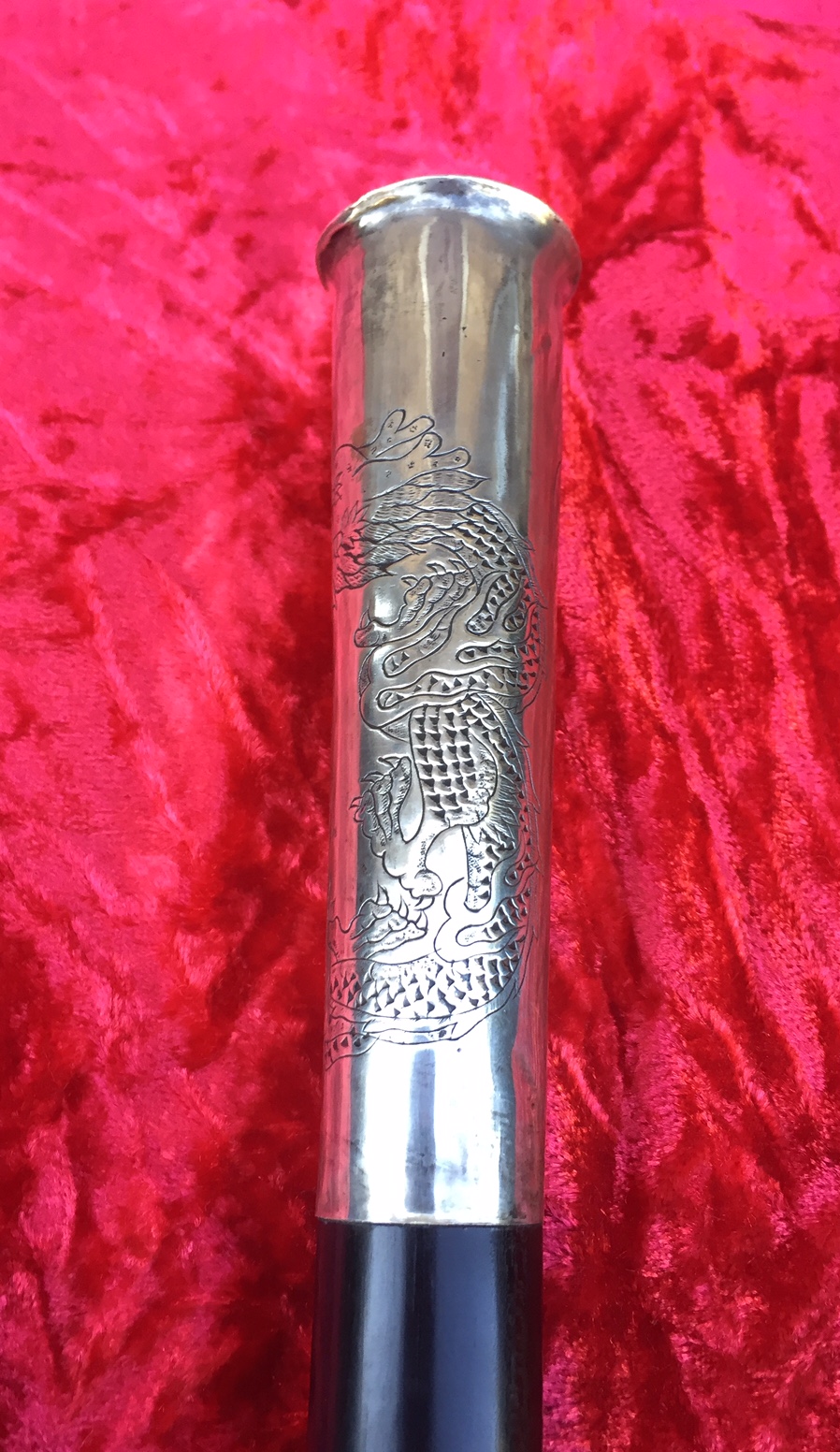
This fine Chinese manufactred ebony and silver tipped walking stick was carried by Navy Pharmacist Mate First Class William E. Riley. Riley was assigned to duty with the Tientsin Marine Detachment. Along with the Marines of Tientsin, he was taken prisoner by the Japanese on 8 Dec 1941. The stick measures 36" in length and features a dragon on the handle. The markings on the cane indicate it was made in Tientsin of "Fine Silver" by Yuan Shun.
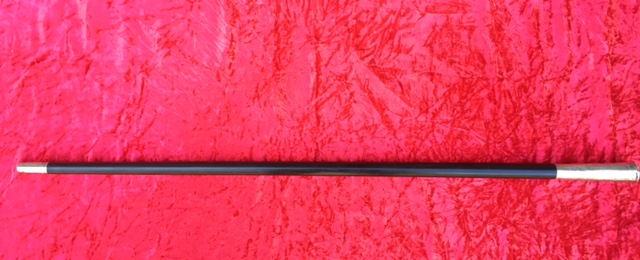
Wood Carving
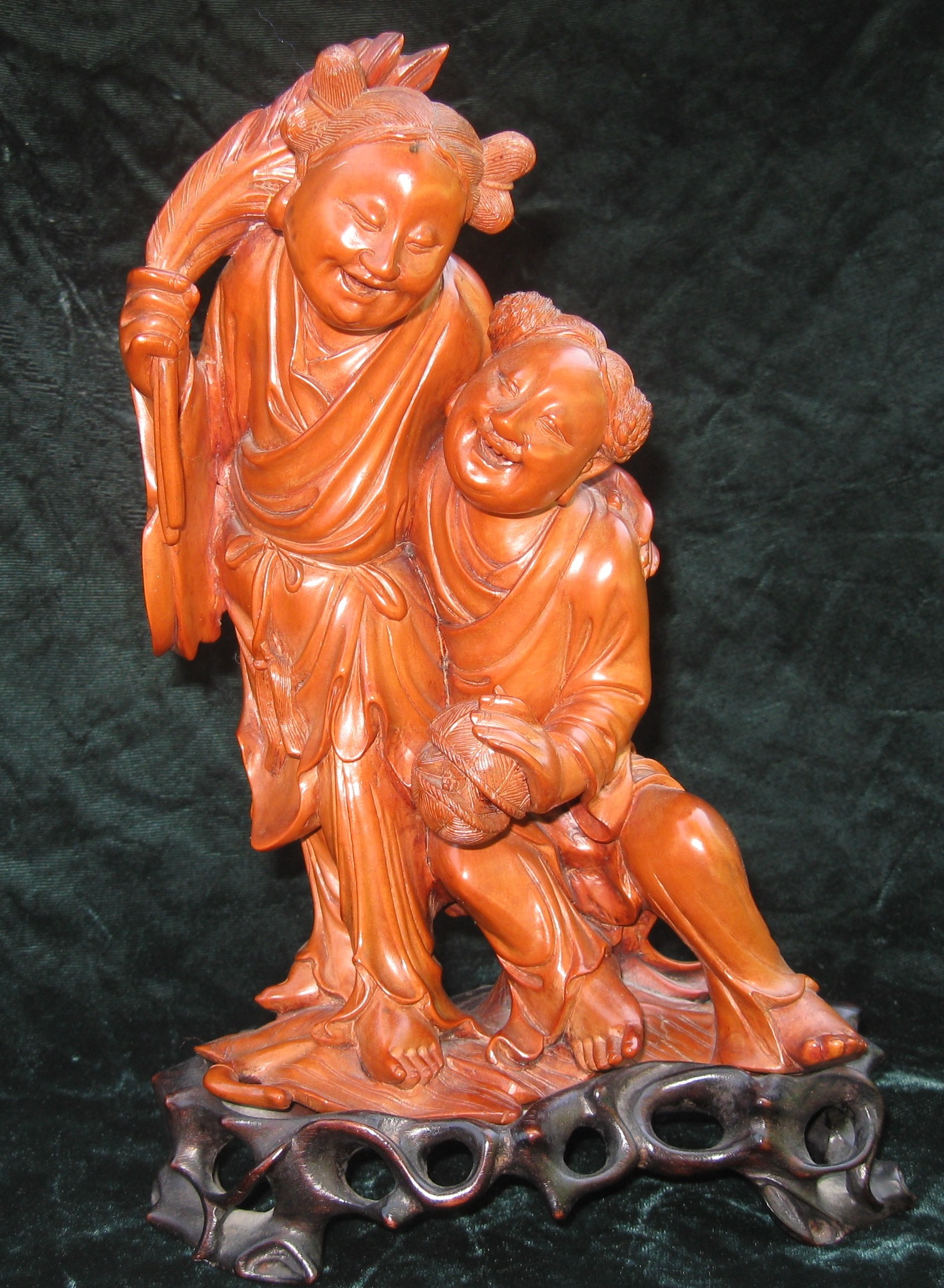
This small wood sculpture was purchased by Lt Dewolf Schatzel and his wife shortly before they returned stateside. According to Schatzel’s daughter, the Lieutenant had a small amount of Chinese currency left at the end of his tour they wanted to spend before leaving country. This was their final purchase.
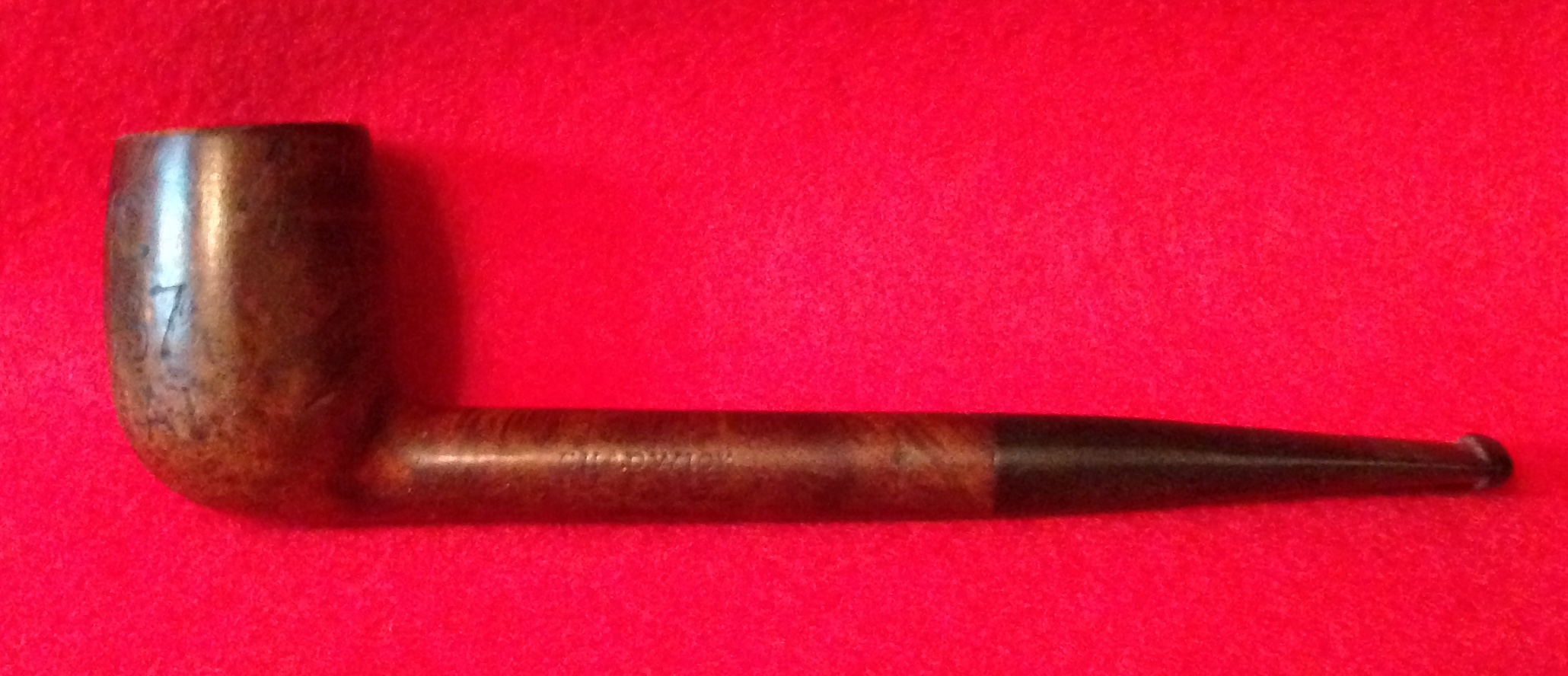
Pipe engraved with the words "USMC 1934-1937 Shanghai." This pipe was made by an American manufacturer and engraved by its owner
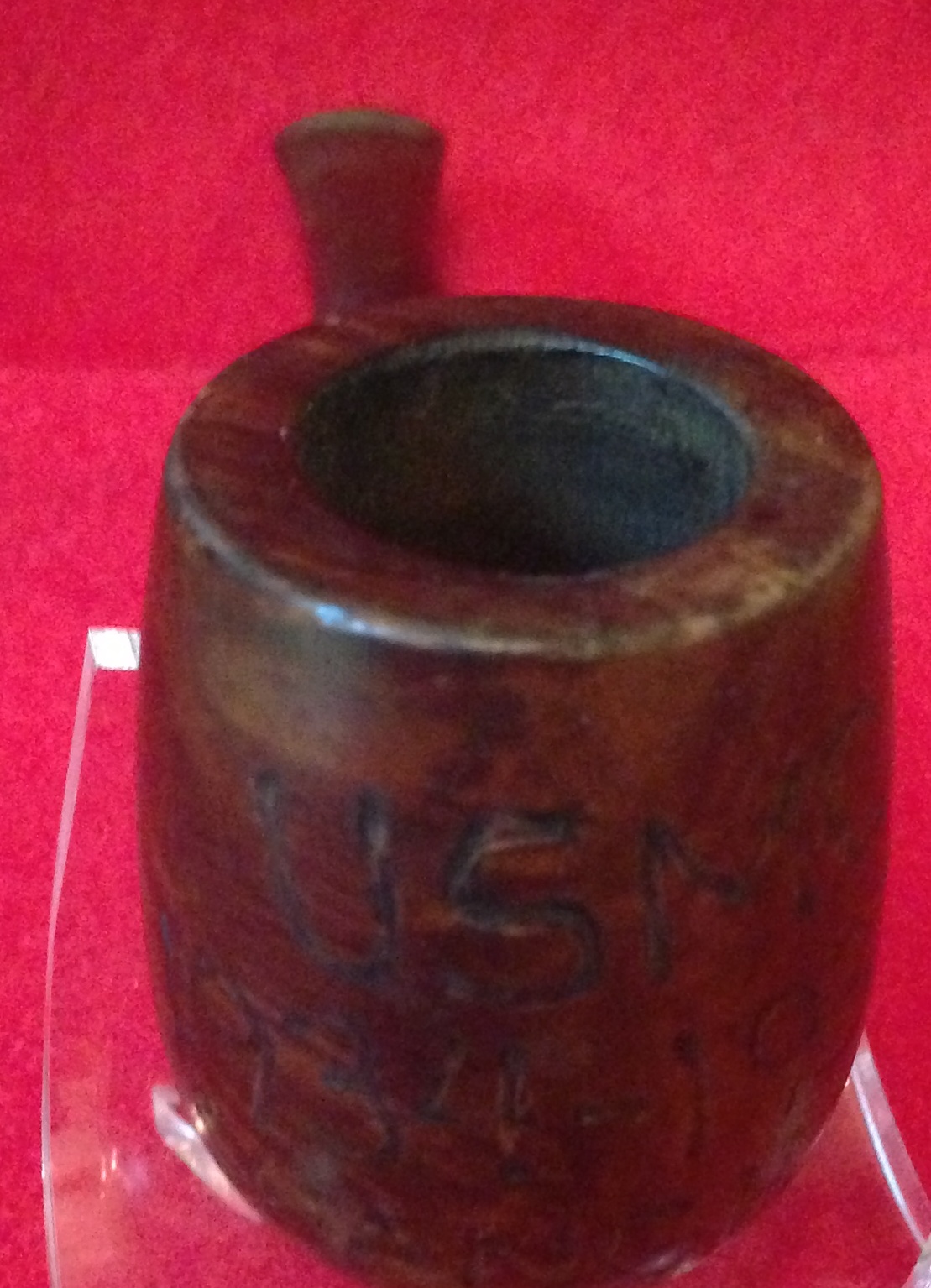
The pipe's bowl showing a portion of the engraving
Trench Art:
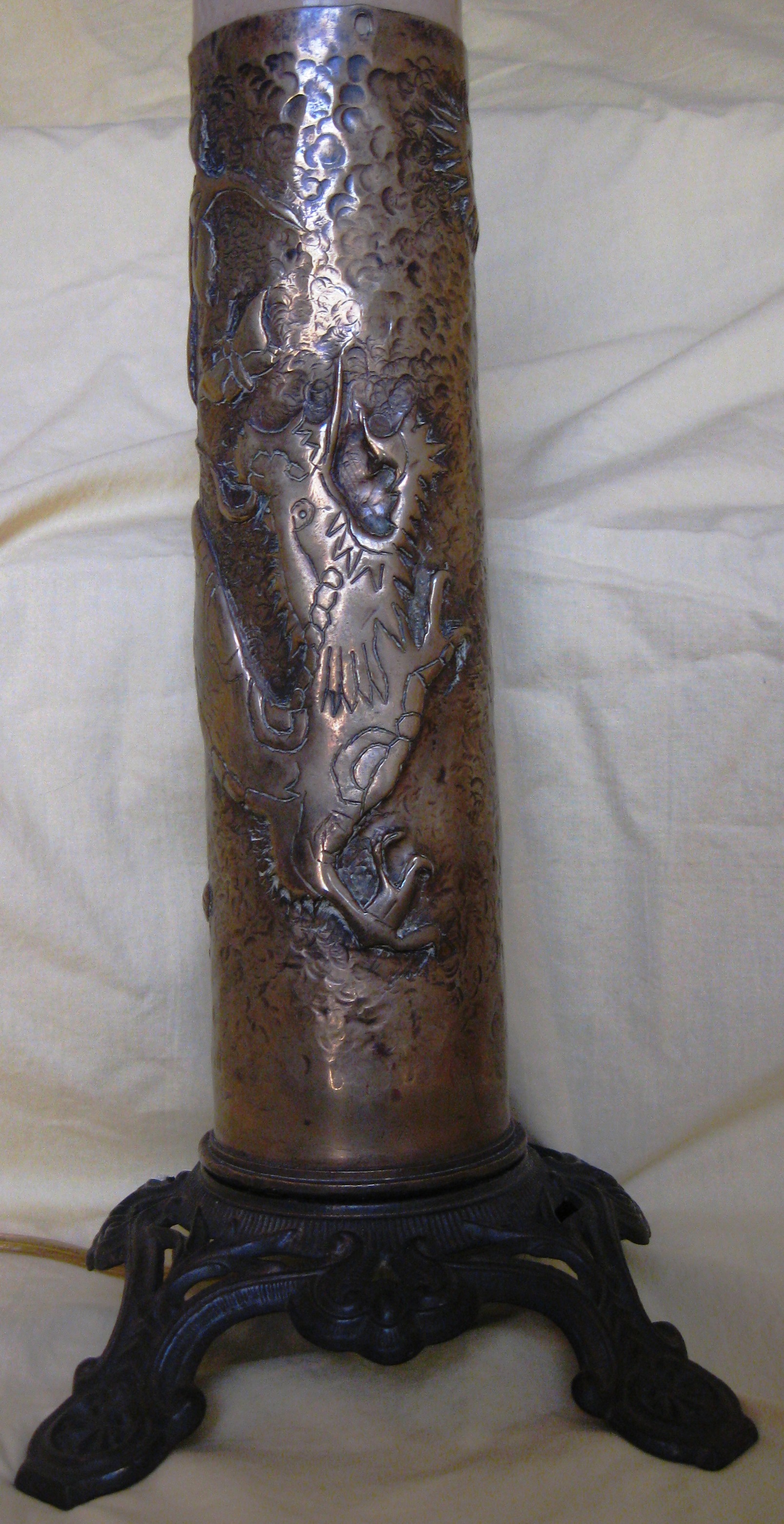
A Marine fashioned a dragon-themed lamp by using the shell casing from a 3" Naval Land Gun. Peking based Marines maintained a number of these small field pieces through March of 1938. The stamping on the base indicates the shell was manufactured by the Winchester Repeating Arms Company in 1893. This lamp is currently undergoing restoration
Ephemera:
Recruiting brochure. A small brochure highlighting the benefits of service in China.
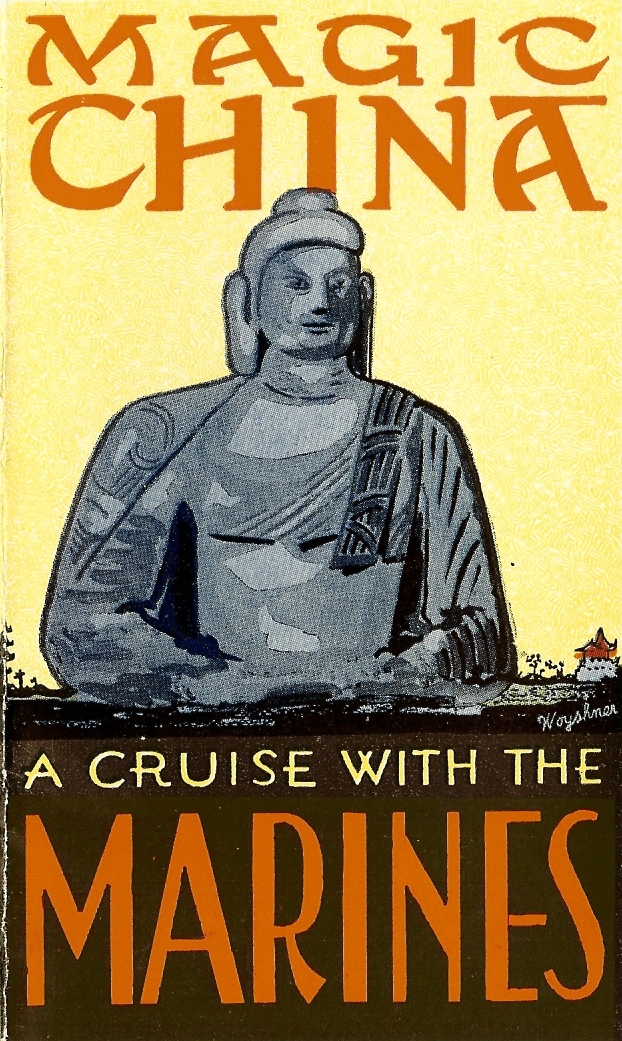
Recruiting brochure. A small brochure highlighting the benefits of service in China.
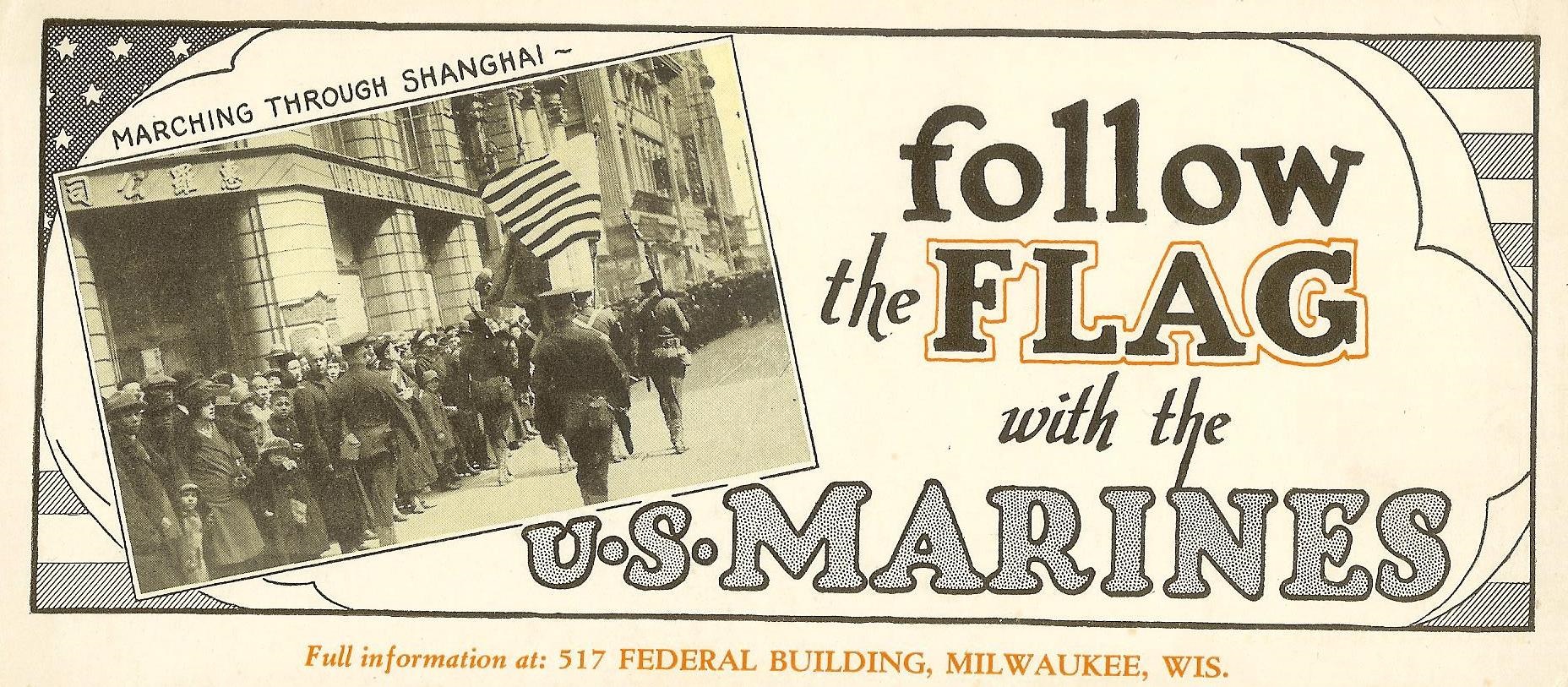
Ink Blotter, highlighting China Service.
Club Book. Both Privates and NCO’s had their own clubs in Peking, Tientsin and Shanghai. China Marines utilizing such clubs operated on the credit or “chit” system. At the beginning of each pay period a Marine would allocate how much credit he wanted for his account. He could draw on his credit for meals or drinks over that period then settle his account when he was next paid. This book belongs to a Peking Marine and records in the book his chits for several months.
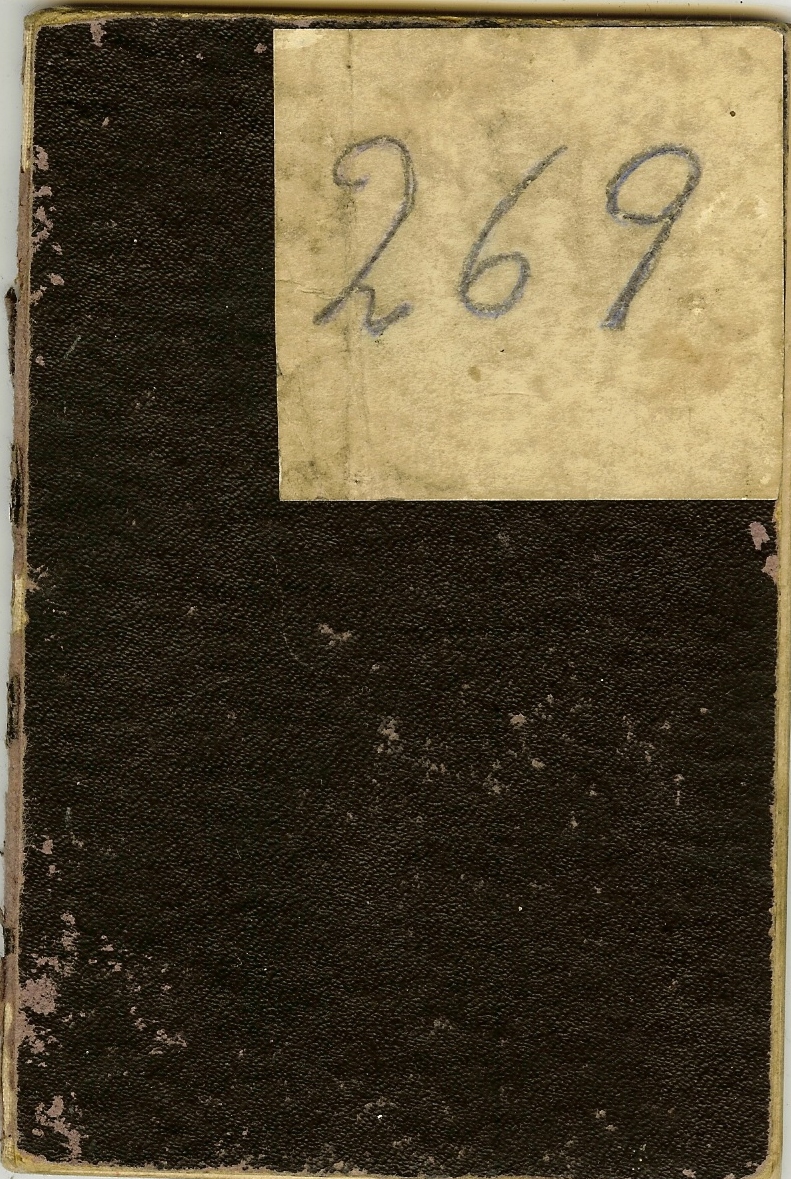
Cover of a Privates Club Book
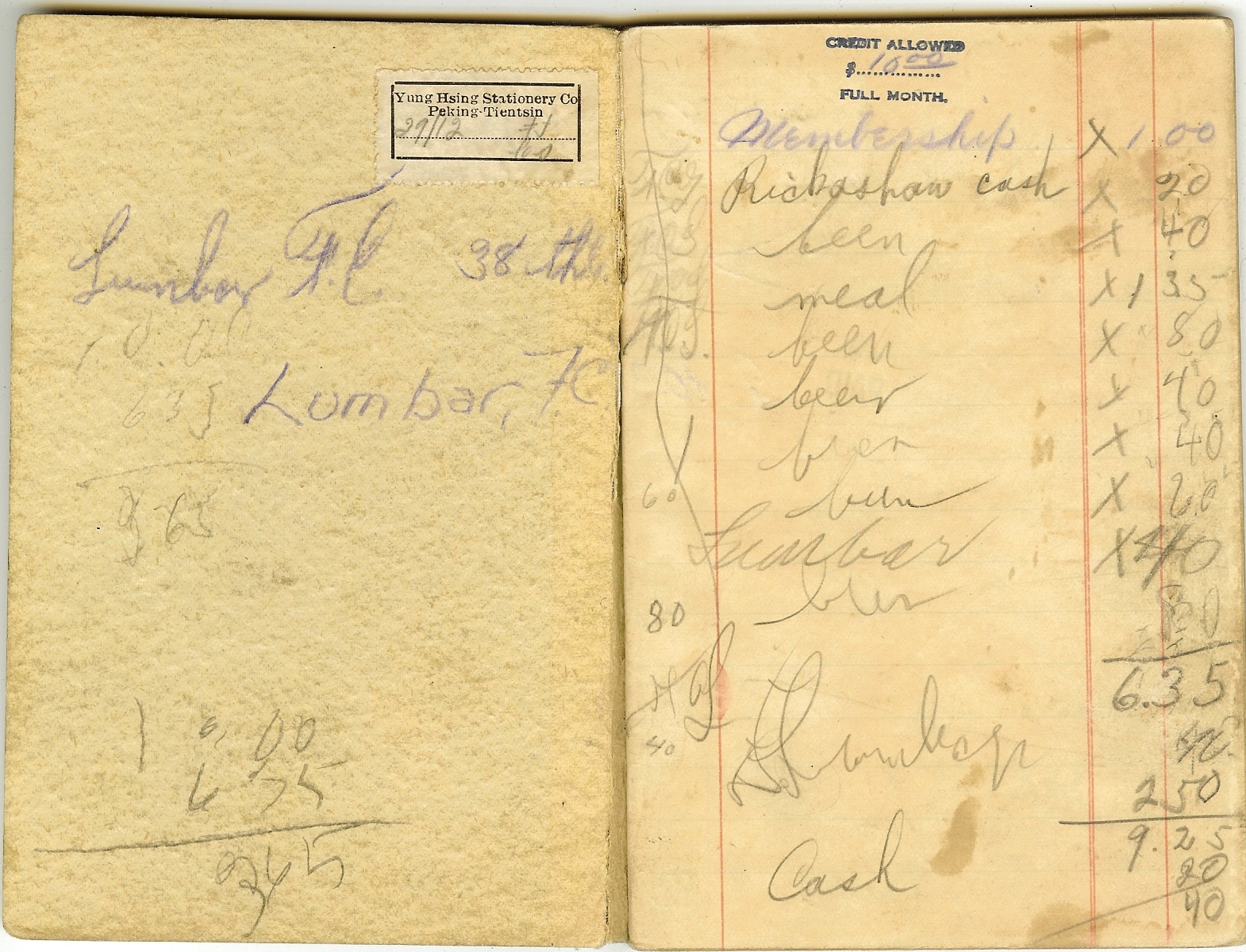
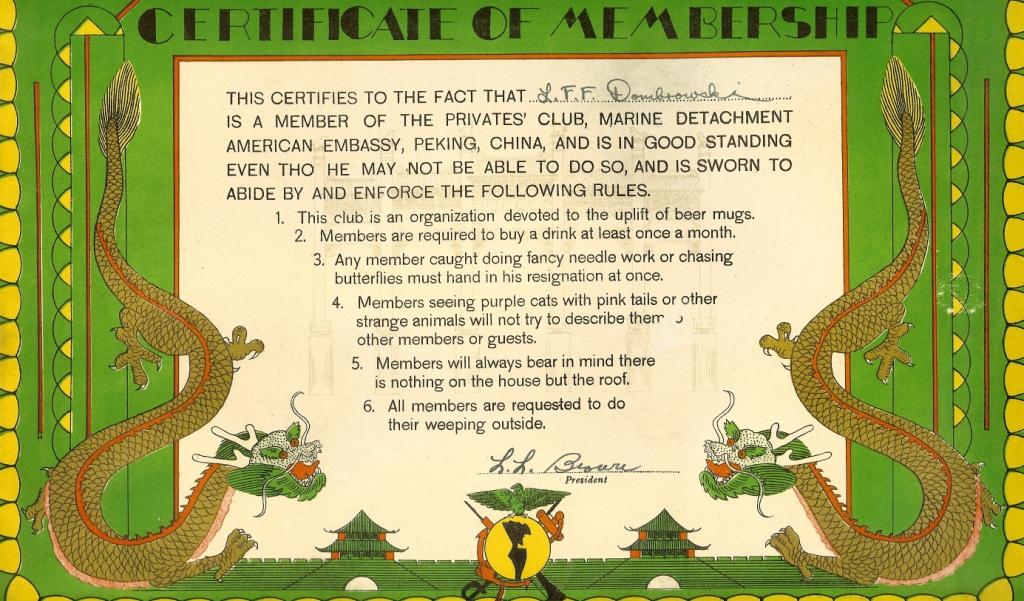
A Detail from a American Embassy Privates Club Membership Certificate: An ornate certificate given to each member of the Peiping Privates Club. Custom certificates like this were popular with American troops serving in China and were also issued by private bars and clubs the sailors, soldiers and Marines patronized.
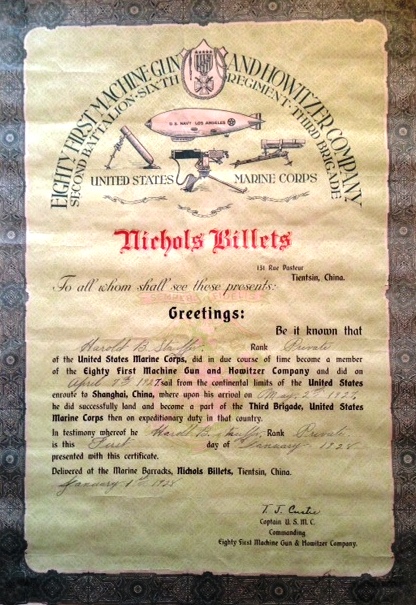
Certifcate of Service. A Chinese printed document highlighting one Marine's service record as a part of Butler's Expeditionary Force.
Menus: Prior to World War II, the American military took national holidays very seriously and held formal dinners honoring Washington’s Birthday, Declaration Day, the 4th of July, Thanksgiving, and Christmas. The services made a point to serve special meals on well decorated tables. In Peking, Shanghai and aboard ship menus were printed to honor the event. Sometimes these menus could be a simple affair, while others could be quite colorful augmented by real photographs throughout its pages.

Legation Guard Menu, 1921
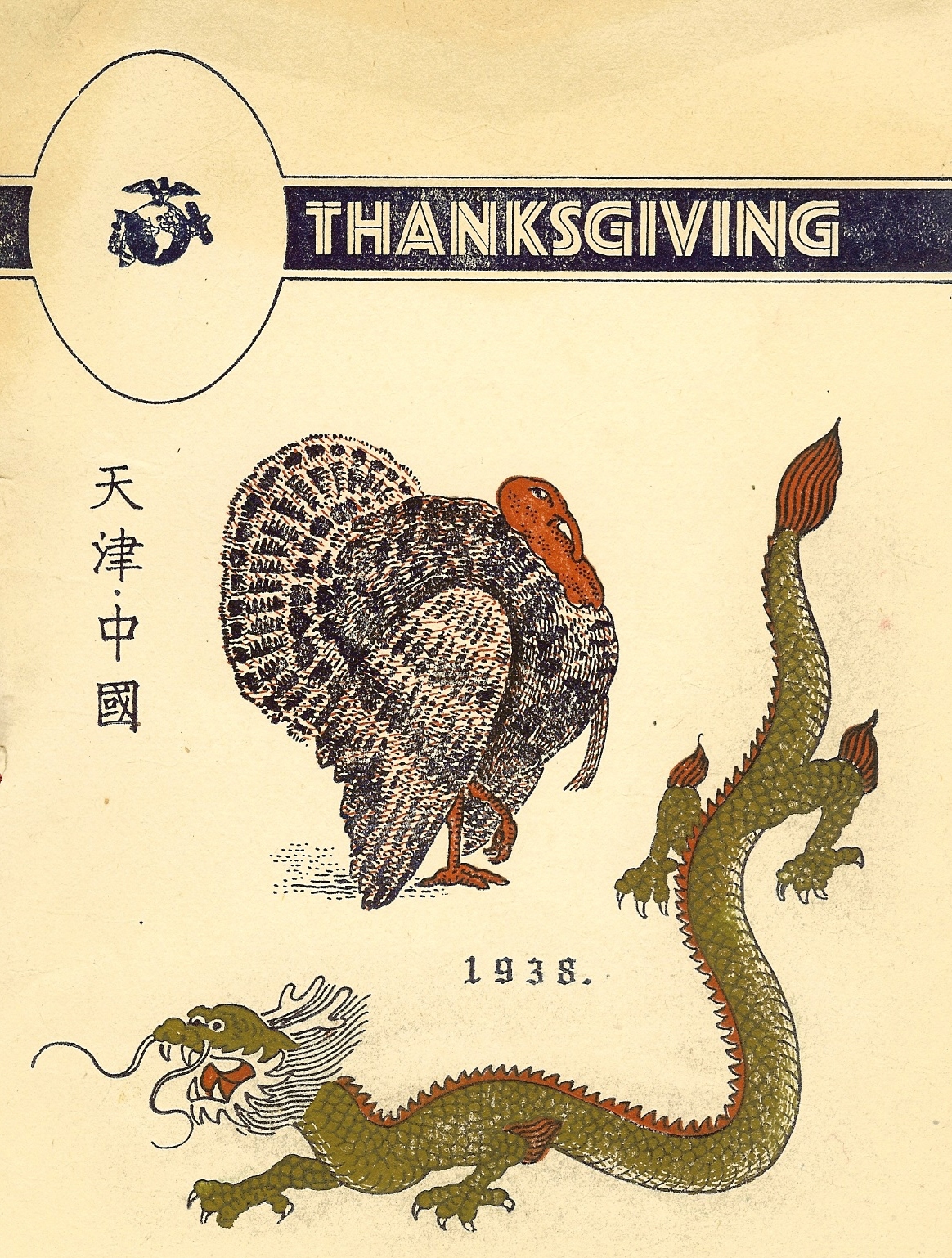
Thanksgiving Day menu from the Marine Detachment at Chinwangtao
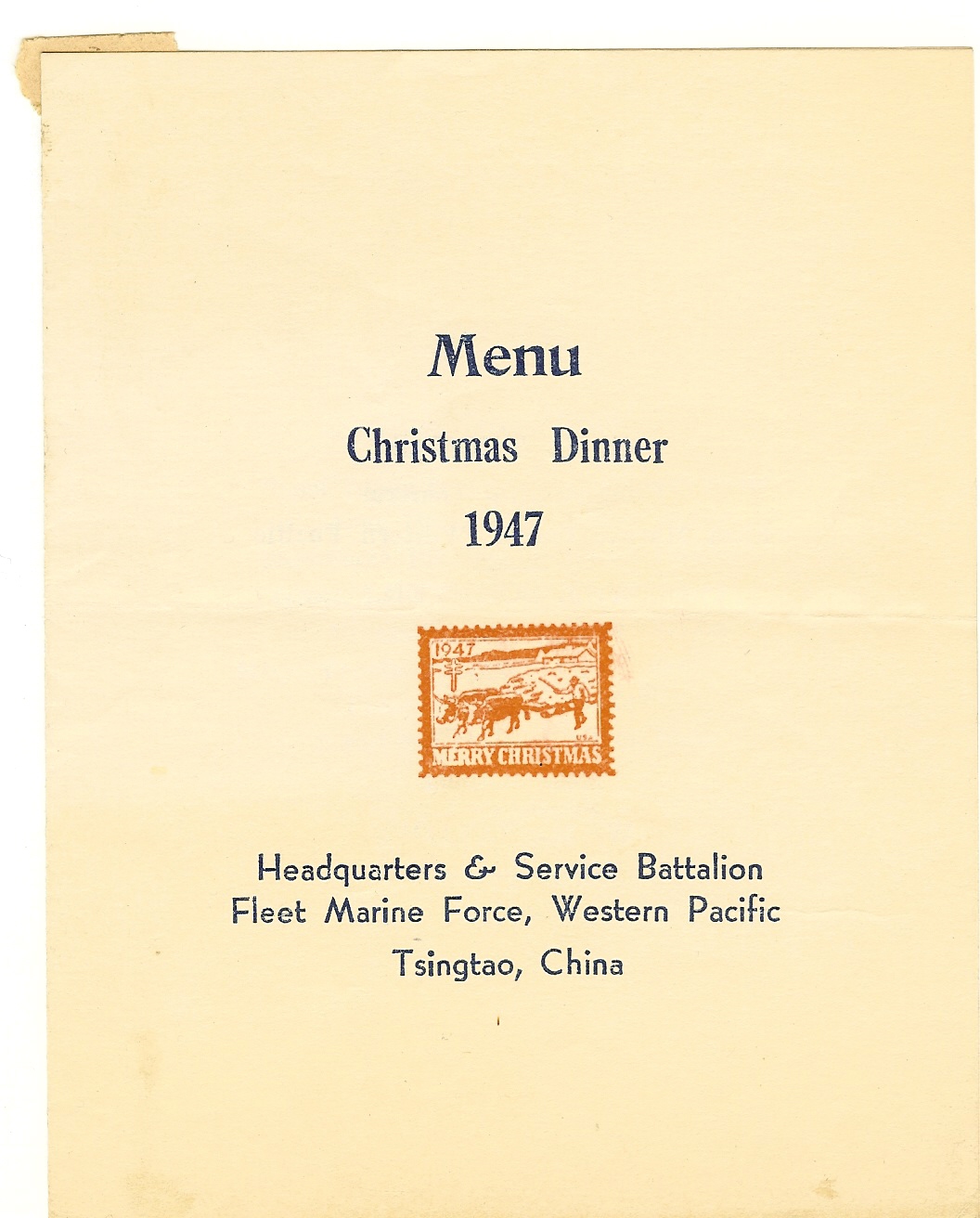
A Post War Menu

This faded image shows Christmas dinner at the Legation c. 1908. Note menus (with a picture-type cover) grace the table.
Tours and Other Activities:

Legation Guard YMCA Sightseeing Trip Program (c.1928-35).These four page guides were developed to augment “Y” sponsored trips to various scenic locations around Northern China. Their contents were drawn from excerpts of Sidney Gambles “Peking- A Social Survey” or Juliet Bredon’s classic “Peking”. Variations of content and cover design have been noted for each program. There are currently eight known tour guide examples:
Brief History of Peking
Geography of Peking
The Summer Palace
The Sea Palaces of Peking
Astronomical Observatory
Temple of Heaven and Temple of Agriculture
The Great Wall of China
The Ming Tombs
Maps:
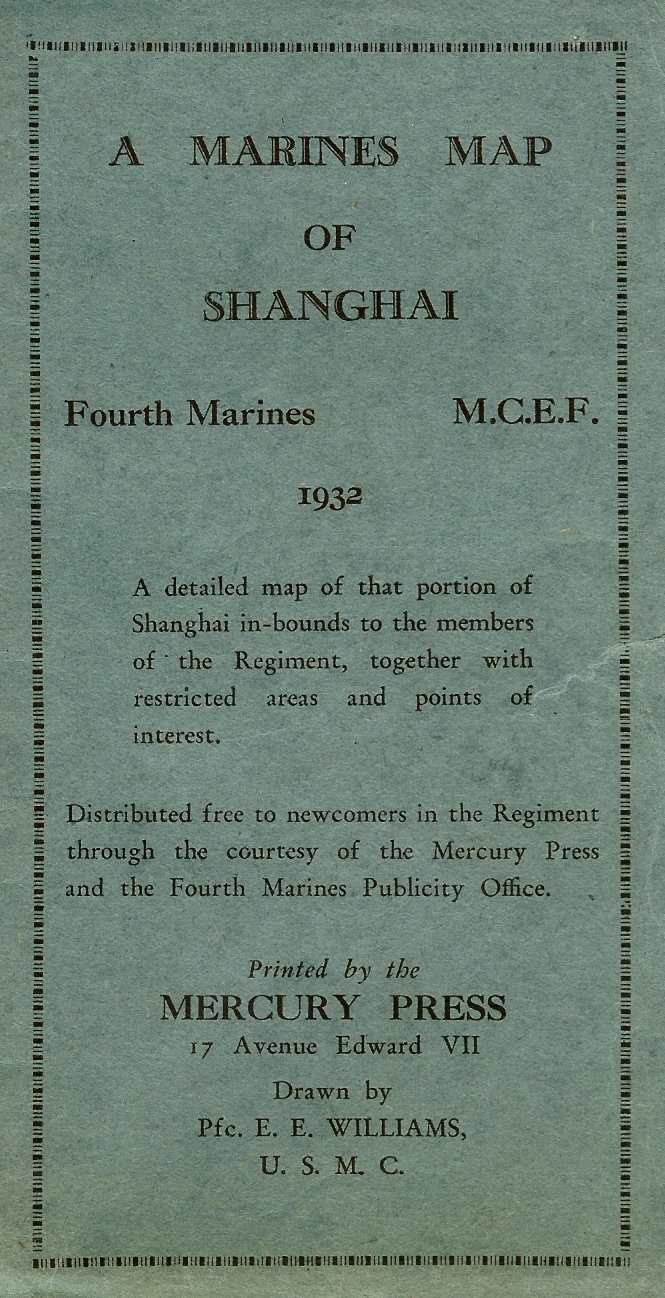
The Navy YMCA had been printing maps of Shanghai for several years when this map was developed around the time of the 1932 Battle of Shanghai. The Map is almost identical to the "Navy Y" map. Of the two examples I''ve seen of this map, both were marked in pencil by their owners showing Marine positions during the battle.
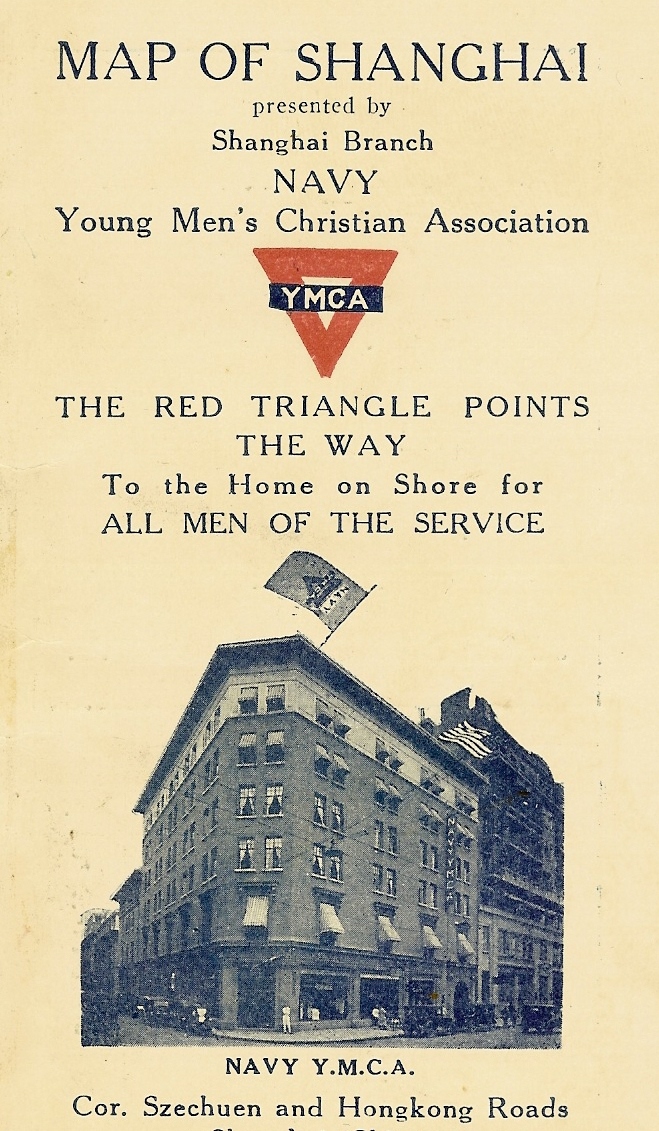
A copy of the Navy YMCA Map of Shanghai. This is a more common map than the Marines map (above), as examples of this type turns up with more frequency. The map is filled with adverts that changed over the years as well as a key that highlighted areas of interest for Sailors and Marines.
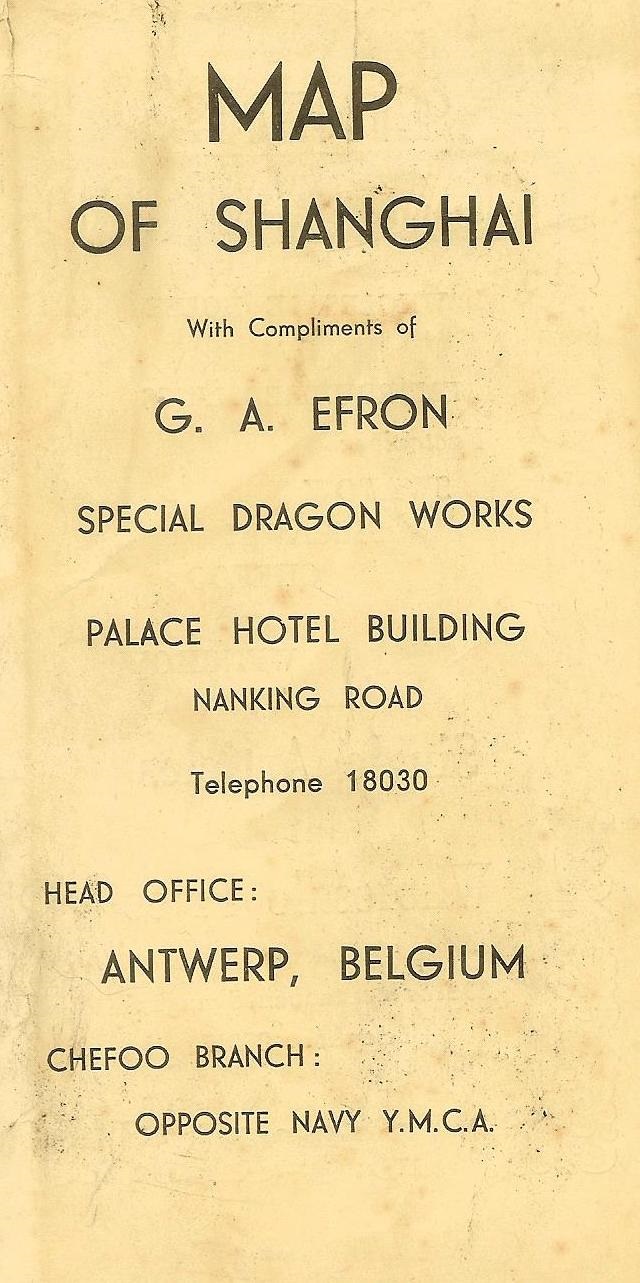
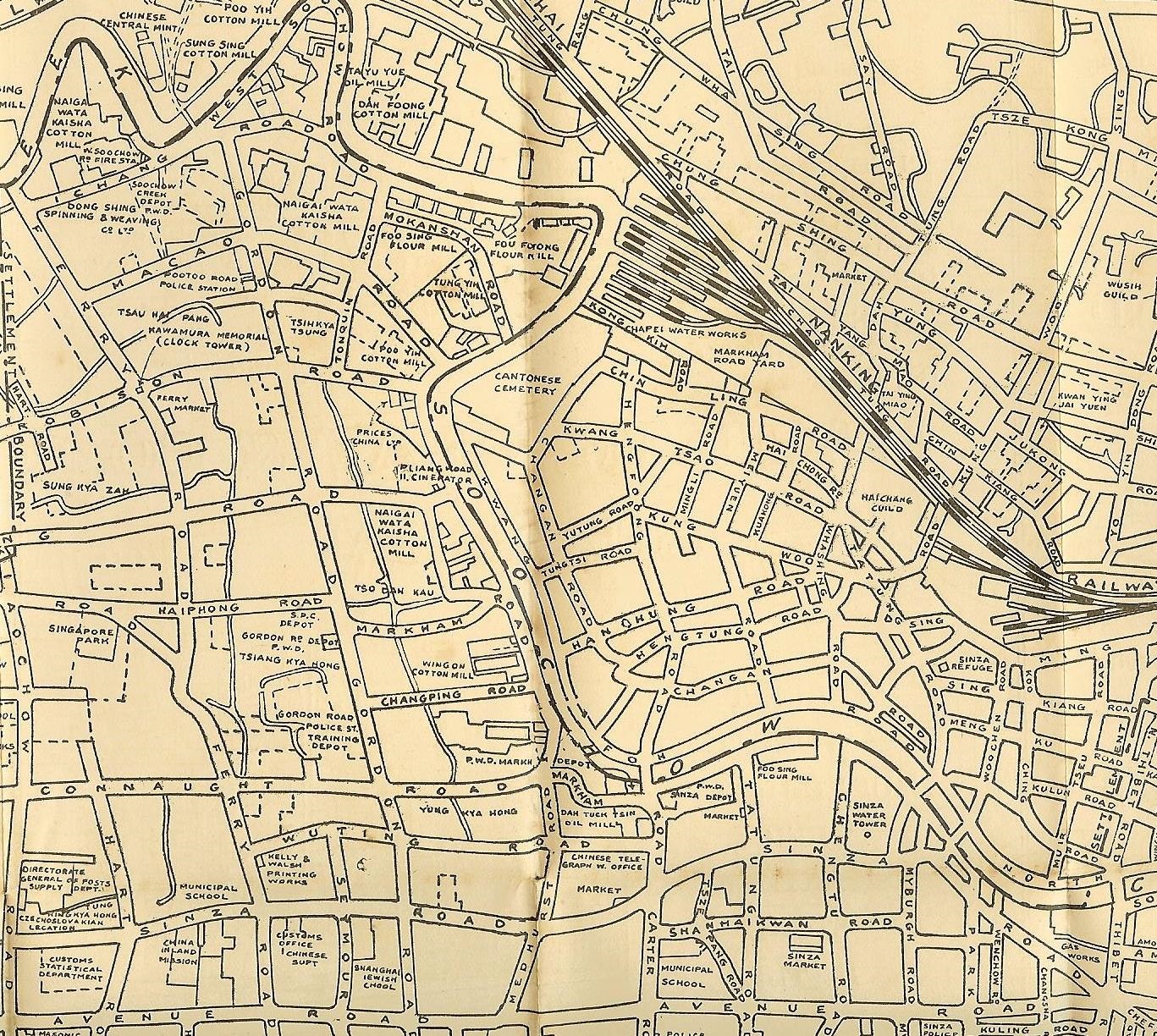
Hotel Map of Shanghai, 1938 edition. Maps of this sort were aimed at the souvenir hunter, highlighting key shopping locations. But also now provides us additional details including the layout and names of many of the mills and other industries along that Soochow Creek.
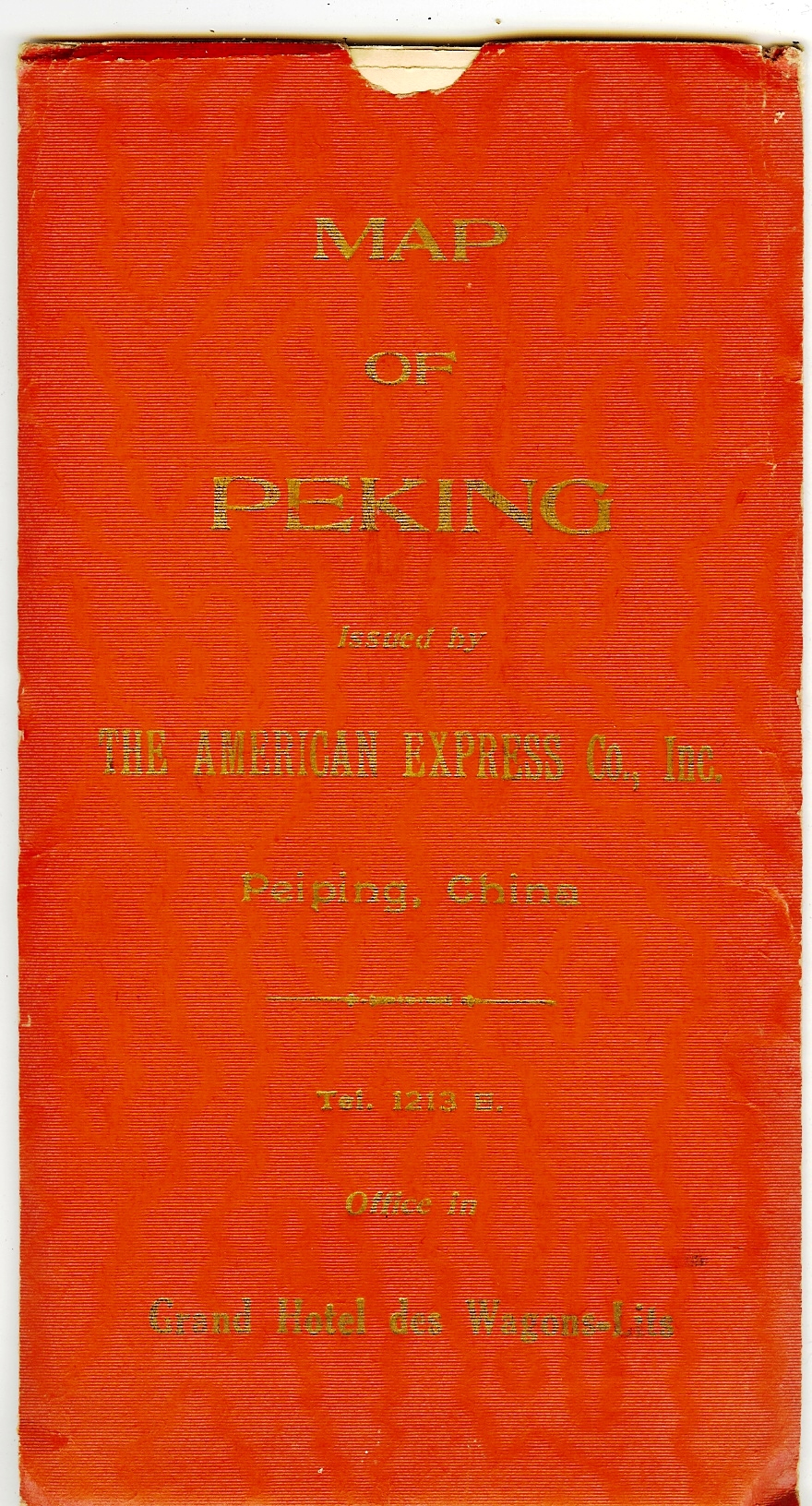
A tourist map of Peking sold by the American Express office located at the Wagon Lits Hotel prior to WWII
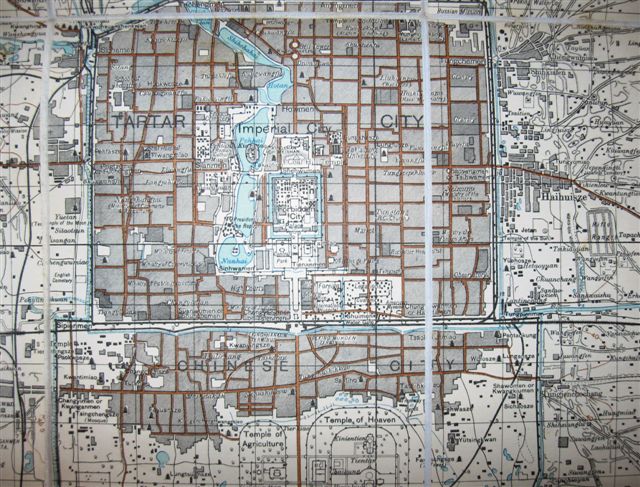
Mounted Detachment Map. This detail of a 1:50,000 scale map of Peking and the surrounding area was made by the British War Office and sold commerically through the French Book Store in Peiping. The map is of paper backed by linen. This is particular map was used by Lt Schatzel, Commander of the Mounted Detachment to assist him navigate the Chinese countryside
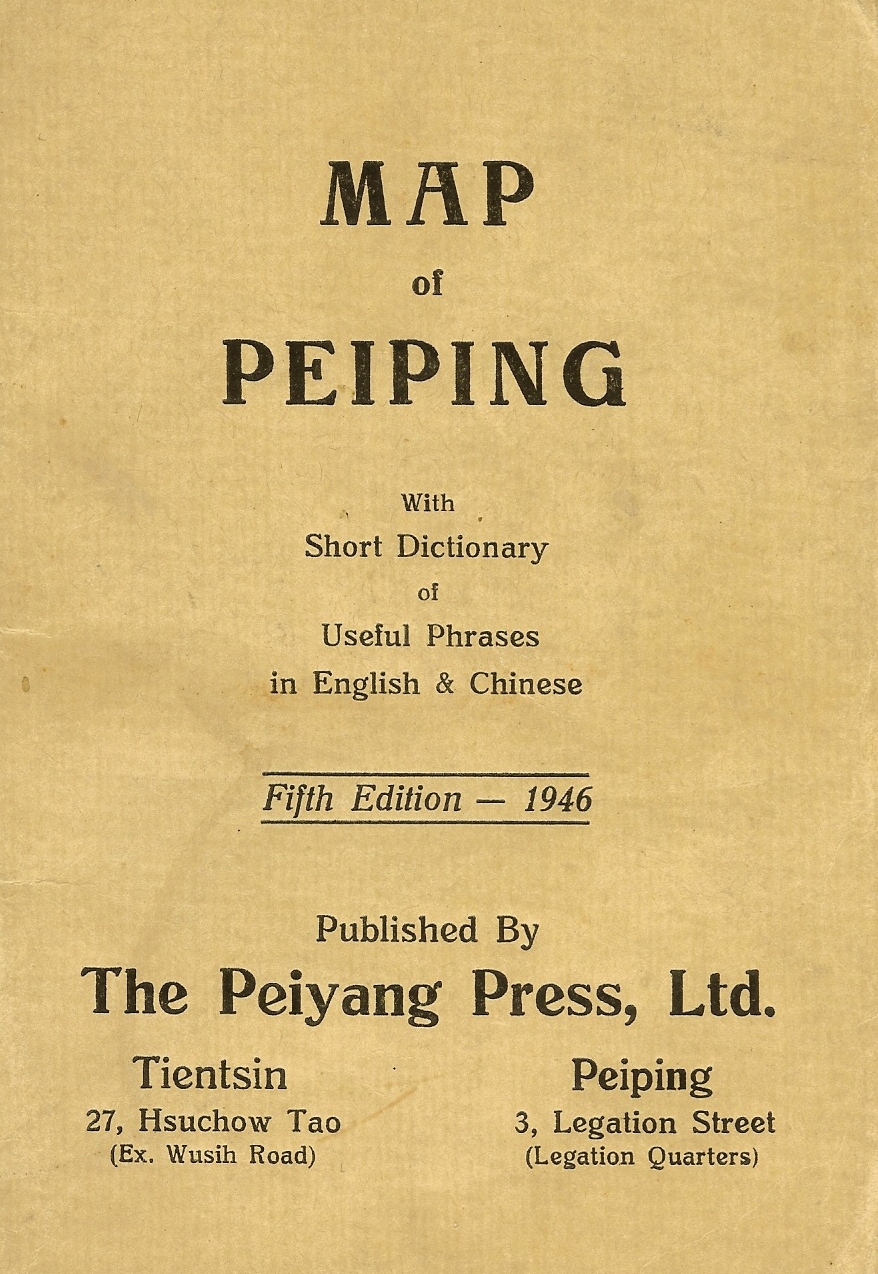
A Post War map of Peiping. This map was initially available prior to WWII and is known to come in several different editions. This example was reissued after the war.
Stationary, Letters and Mail:
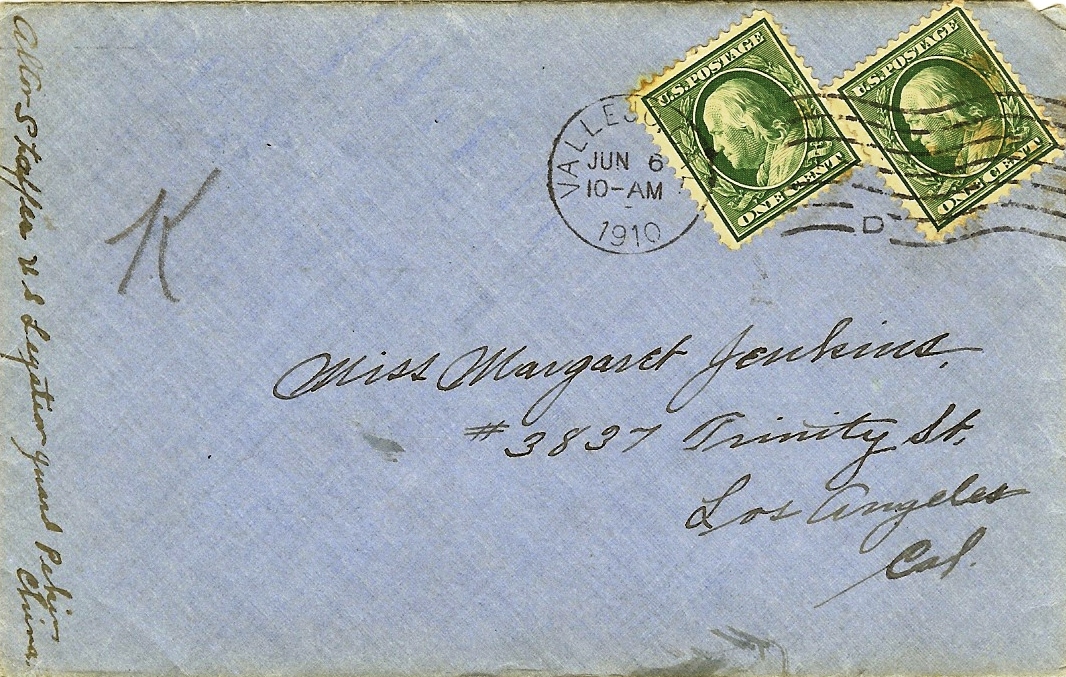
A envelope from Pvt Alton Shaffer to Miss Margaret Jenkins, with a 6 June 1910 cancel stamp. Schaffer mailed this letter the day his ship sailed for China. I read the double diagonal placement of the stamps was a coded note stating he loved Miss Jenkins, and asking if she felt the same toward him. Shaffer served as a Teamster in Peking and was part of the winning 1911 Marine Rifle Team of North China. At the end of his cruise Shaffer returned stateside, got out of the Marine Corps and married Miss Jenkins. Census records show them still together in 1930.
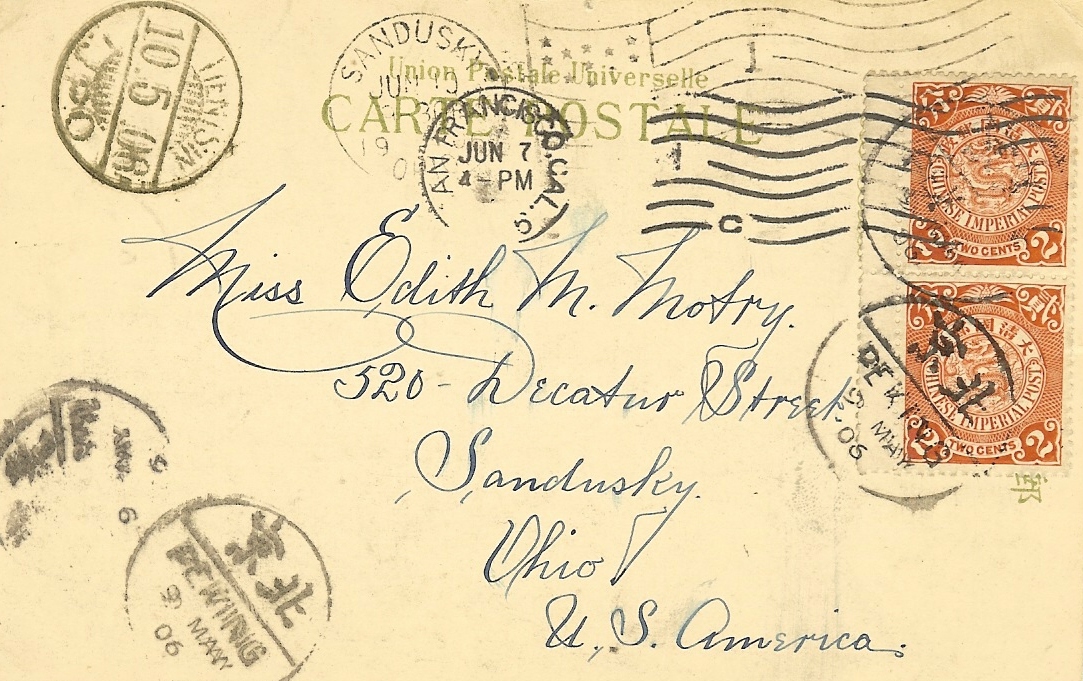
Postcard. Part of a series of cards sent by Pvt Albert Burton, one of the first Peking China Marines, 1906. It appears Burton mailed the card at the Chinese Post Office in the city and it was forwarded to the Japanese Post Office in Tientsin. Burton complained that unless he wrote at least a short note on the front of these cards, they would "disappear" in the postal system and not be delivered.
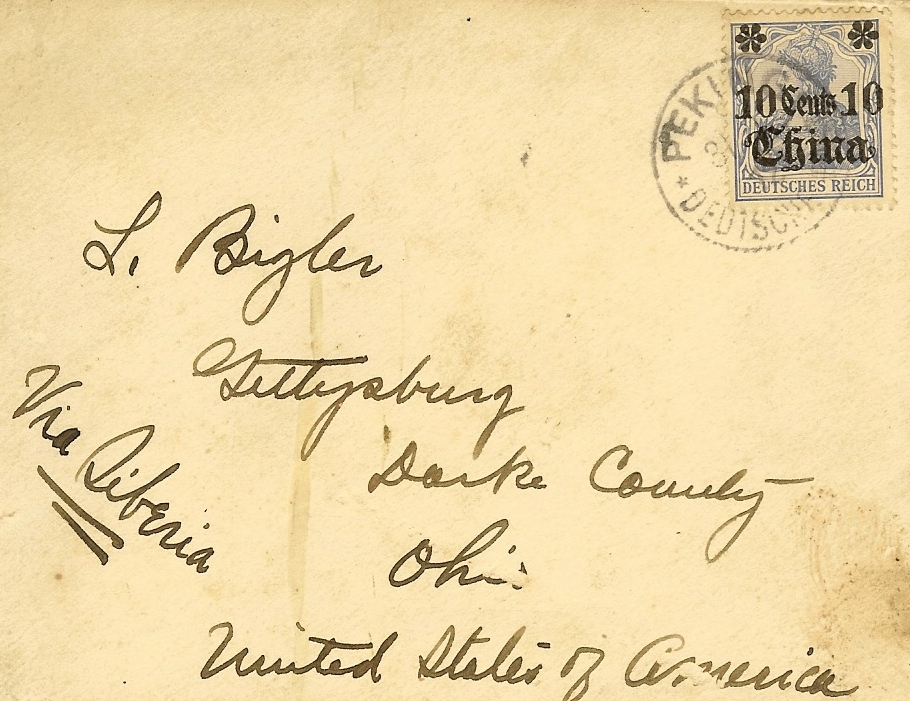
This cover was sent by a Marine officer via the German Post Office in Peking, c.1911. Mail through this post office moved via Siberia and had a good record of reaching the States in about one month.
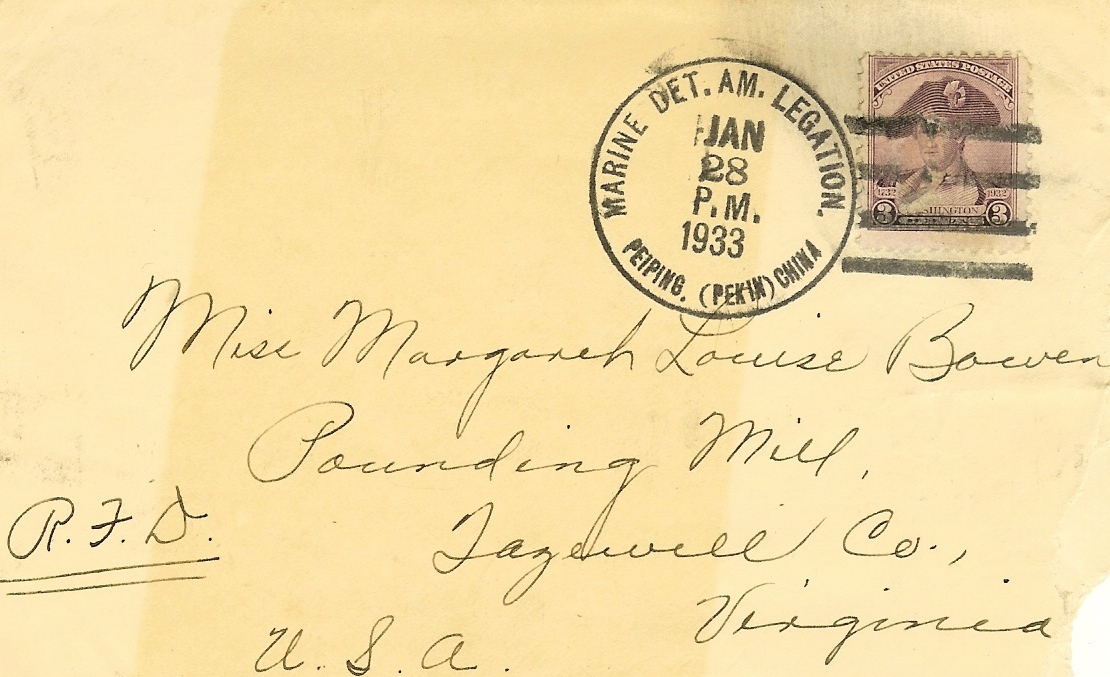
This cover was mailed using the American Legation Post Office in1933, and bears a Marine Detachment cancel stamp.

A Fourth Marine cover.
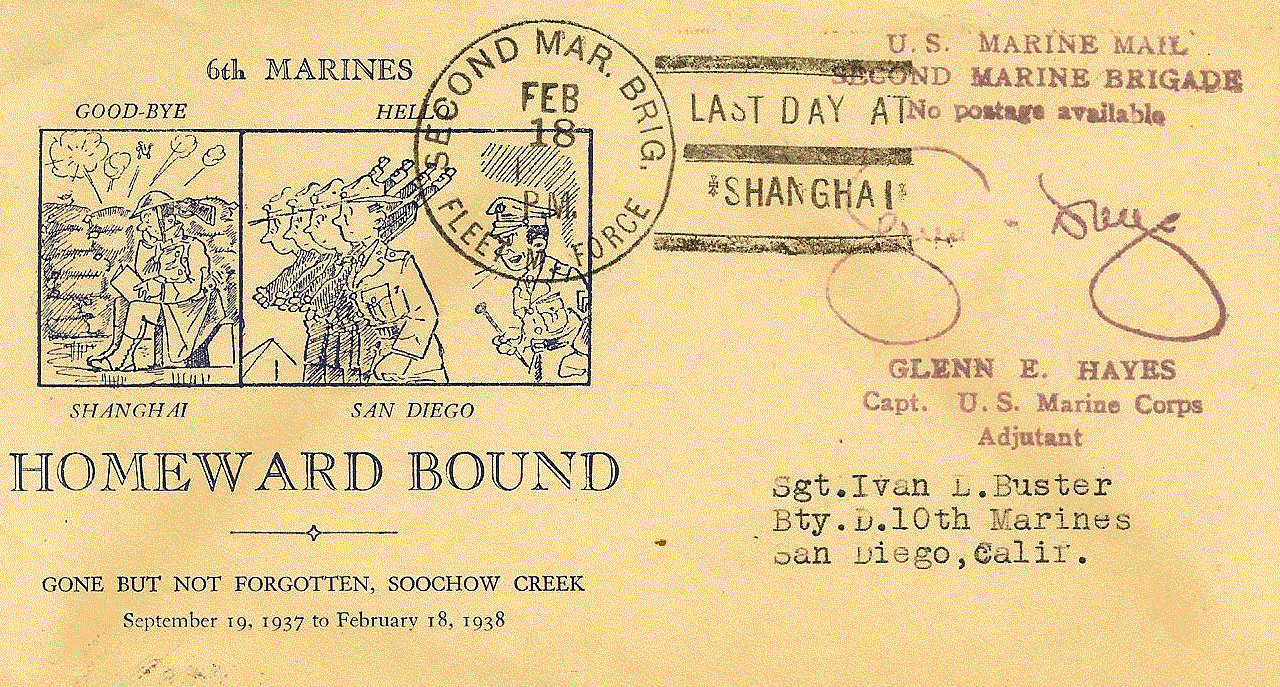
A 6th Marine cover, 1938.
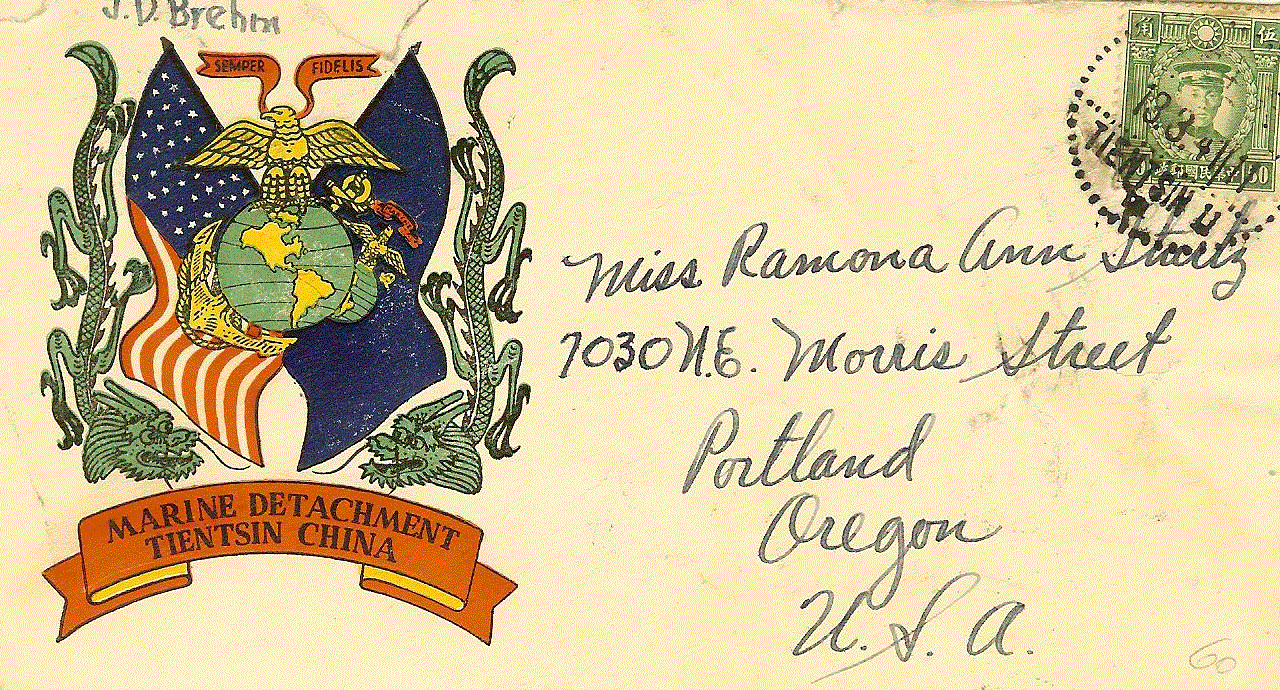
A Pre-War Tientsin cover. This cover design was also used by Peiping based Marines and reused after the war for Marines serving in North China.
Greeting Cards:

Greeting Cards. Prior to WWII, Shanghai and Peking Marines as well as General Butler's Expeditionary Force had Christmas cards printed and sold through their post exchanges. After WWII the tradition continued for returning Marines and sailors, with cards being sold that sometimes utilized pre-war designs.
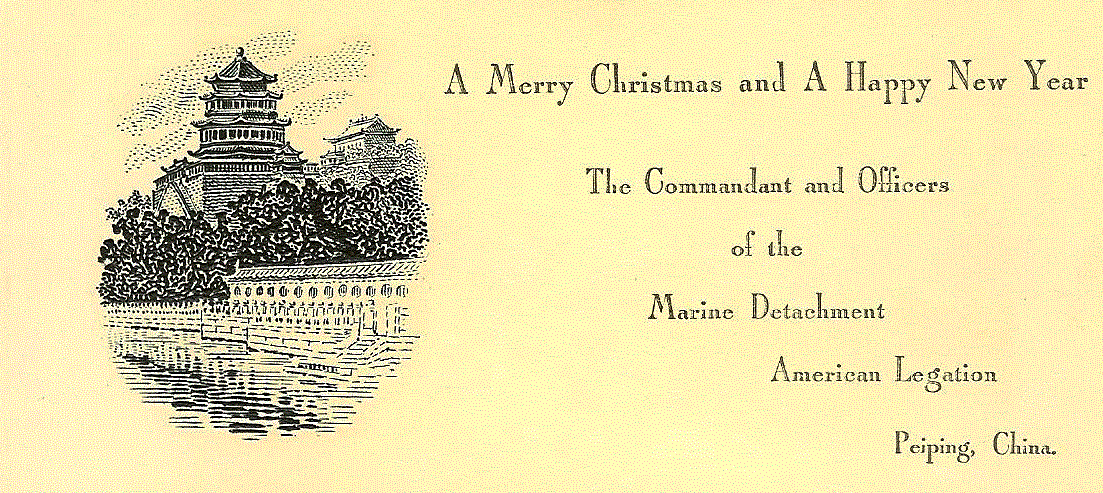
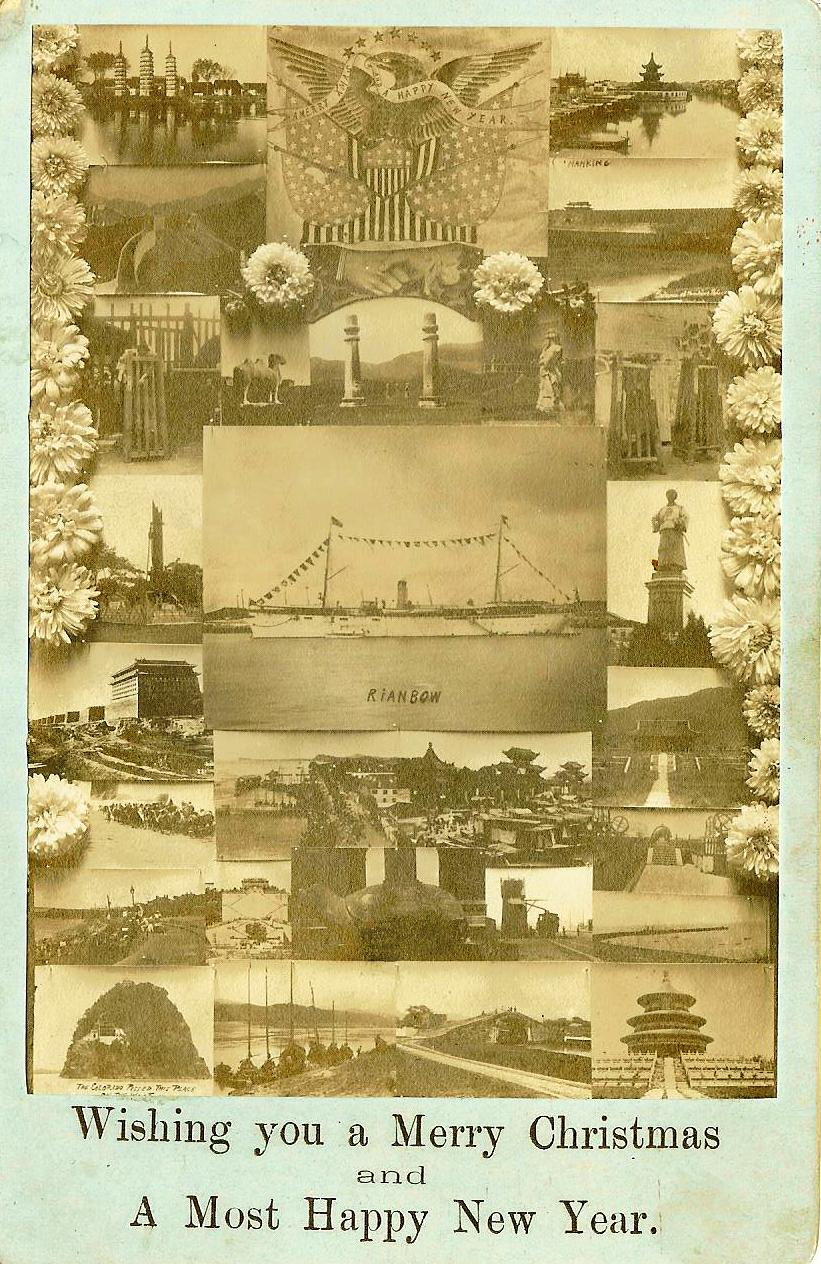
A cabinet card style greeting card. This was a popular souvenir found at photo studios in port cities along the China coast between 1900 and the start of World War I. Examples of this style of card were customized by each studio to show a particular sailors's ship, surrounded by additional stock images of China. This example dates to 1913 and was designed for the USS Rainbow.
Art:
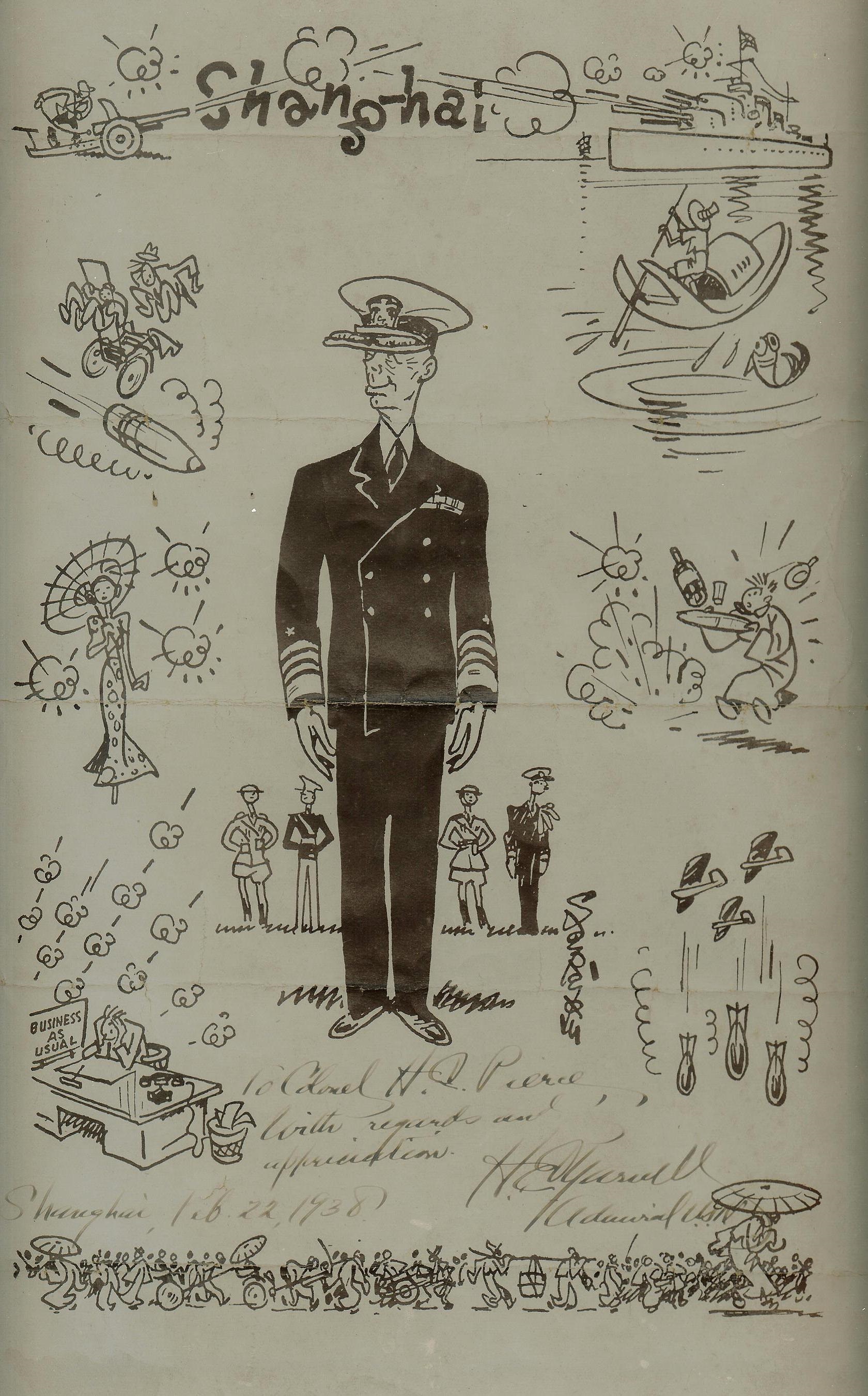
This caricature of C-in-C Asiatic Fleet Admiral Harry Yarnell was drawn by the famous Shanghai cartoonist Sapajou (Georgii Sapojinikoff), of the North-China Daily News fame, as a going away gift for an officer in the 6th Marines, Colonel H.A. Peirce, upon his departure from Shanghai in 1938. Yarnell inscribed a short greeting and autographed the work. The theme of the drawing reflects events of the 1937 Battle of Shanghai which both men witnessed.
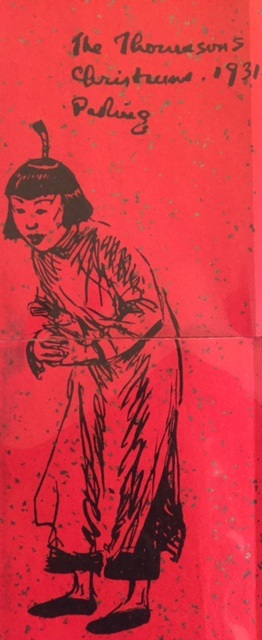
An original drawing by Capt John Thomason. Thomason drew this on Christmas wraping paper for a friend.
